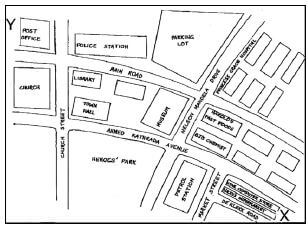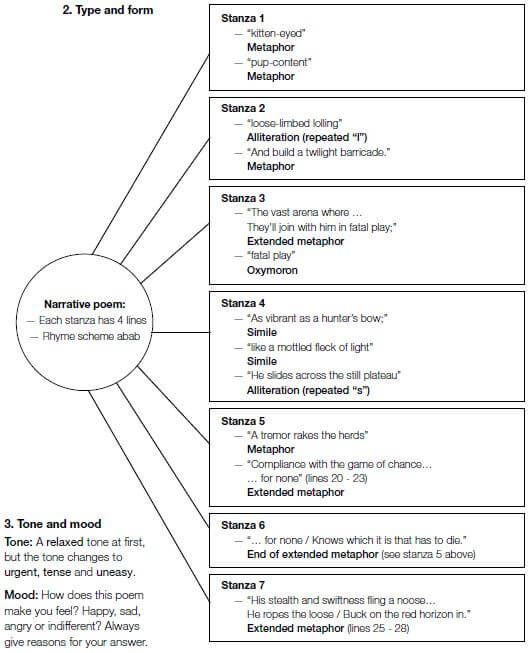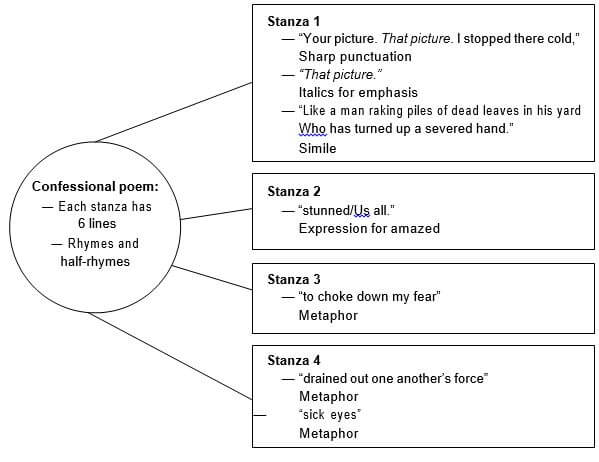Adele
AGRICULTURAL MANAGEMENT PRACTICES GRADE 12 MEMORANDUM - NSC PAST PAPERS AND MEMOS FEBRUARY/MARCH 2018
AGRICULTURAL MANAGEMENT PRACTICES
GRADE 12
NSC PAST PAPERS AND MEMOS
FEBRUARY/MARCH 2018
MEMORANDUM
SECTION A
QUESTION 1
1.1 Multiple Choice
1.1.1 A ✔✔
1.1.2 C ✔✔
1.1.3 C ✔✔
1.1.4 B ✔✔
1.1.5 A ✔✔
1.1.6 C ✔✔
1.1.7 B ✔✔
1.1.8 C ✔✔
1.1.9 D ✔✔
1.1.10 A ✔✔ (10 x 2) (20)
1.2 Matching
1.2.1 L ✔✔
1.2.2 E ✔✔
1.2.3 K ✔✔
1.2.4 J ✔✔
1.2.5 G ✔✔
1.2.6 H ✔✔
1.2.7 A ✔✔
1.2.8 C ✔✔
1.2.9 D ✔✔
1.2.10 B ✔✔ (10 x 2) (20)
1.3 Correct Agricultural Term
1.3.1. Medium term credit ✔
1.3.2 Variable costs ✔
1.3.3 Control ✔
1.3.4 Distribution ✔
1.3.5 Motivation ✔
1.3.6 Pooling system ✔
1.3.7 Production costs ✔
1.3.8 Selling ✔
1.3.9 Entrepreneurship ✔
1.3.10 Interpersonal skills ✔ (10 x 1) (10)
TOTAL SECTION A: 50
SECTION B
QUESTION 2: PHYSICAL AND FINANCIAL PLANNING
2.1 Soil depth
2.1.1 Comparing soil A and soil E in a table form (8)
Soil A | Soil E | |
Depth | Very deep✔ | Shallow ✔ |
Water infiltration | High ✔ | Low ✔ |
Drainage | Well ✔ | Very poor✔ |
Water holding capacity | High ✔ | Low ✔ |
2.1.2 Grow best
- Soil A – legumes ✔
- Soil B – cereals ✔ (2)
2.2 Preferring sweet veld
- Grow on an average low rainfall throughout ✔
- Less supplements needed ✔
- It is nutritious throughout its growing stages ✔
- It stays palatable throughout, even during its matured stage ✔ (4)
2.3 THREE disadvantages of intensive farming system
- Prolonged use of agro-chemicals results in pollution of water and soil ✔
- Land treated with chemicals reduces the diversity of micro-organisms ✔
- Overuse of water leads to reduced nutrients in the soil ✔ (3)
2.4 Different types of pastures (6)
Artificial (planted) pastures | Natural pastures |
Clover ✔ Perennial grasses ✔ Legumes ✔ | Grassland ✔ Scrub ✔ Savannah ✔ |
2.5 Labour illness
2.5.1 THREE methods to reduce the risk of losing income due to ill health
- Workers should be multi-skilled to provide backup skills when needed ✔
- Farmers should outsource certain farming activities and mechanisation✔
- Farm business should have the ill-health policy and programmes in place✔ (3)
2.5.2 THREE items included in the ill-health policy and programme
- Treatment and prevention programmes ✔
- Care and support programmes ✔
- Protection of infected and affected employees from stigma and discrimination ✔ (3)
2.6 Capital
2.6.1 Categorise the types of capital mentioned in the above cartoon
- Working capital ✔
- Wonder fertilizers ✔
- Wonder herbicides ✔
- Money ✔
- Movable capital ✔
- Wonder irrigation ✔ (6)
2.6.2 Advise farmer on extra money
- Can apply for a loan ✔ (1)
2.6.3 THREE important requirements for long term credit
- The potential of the farm business ✔
- The stage of development of the business ✔
- The type of farming enterprise ✔
- The credit worthiness of the farm business ✔ (Any 3) (3)
2.6.4 Difference between sources of capital
- External sources
- Capital obtained from resources outside the farming enterprise ✔
- It is not linked to the owner ✔ (2)
- Internal sources
- Capital obtained from resources within the farming enterprise ✔
- It is linked to the owner itself ✔ (2)
2.7 Budget
2.7.1 FOUR pre-requisites to prepare the next cash-flow budget
- The previous income statement for the same period ✔
- The present balance sheet ✔
- The balance sheet of the previous period ✔
- Notes on the transactions that were conducted during the previous financial period ✔
- Calculations on depreciation ✔ (Any 4) (4)
2.7.2 THREE valuable comparisons from budget and financial statement
- Profitability of the business ✔
- Establish whether the current expenses are within acceptable limits ✔
- Determining whether the business is making progress by comparing figures with those of previous period ✔ (3) [50]
QUESTION 3: ENTREPRENEURSHIP, RECORDING, MARKETING, BUSINESS PLANNING AND ORGANISED AGRICULTURE
3.1 Labour related records
- Working hours for each day/week/month ✔
- The specific days that the seasonal workers have worked ✔
- Total days of leave taken by the workers ✔
- Remuneration of workers ✔
- Misconduct by workers ✔
- Work performance of workers ✔ (Any 5) (5)
3.2 Data items reflected on source documents
- Number of product ✔
- Date of transaction ✔
- Description of article or purchase ✔
- Total amount of sales ✔
- Company name ✔
- Payment method ✔
- Buyer or seller information ✔ (Any 4) (4)
3.3 Income statement
3.3.1 INCOME STATEMENT FOR YEAR ENDING 31 DECEMBER 2017
INCOME | VALUE (Rand) | EXPENDITURE | VALUE (Rand) |
Sale of carrots | 11 500 | Soil preparation | 10 000 |
Sale of onions | 28 000 | Harvesting cost | 6 000 |
Sale of tomatoes | 20 000 | Casual labour | 8 000 |
Sale of cabbages | 9 400 | Seeds | 6 500 |
Fertiliser | 10 000 | ||
Disease, pest and weed control | 10 000 | ||
Repair and maintenance | 15 500 | ||
Packaging and | 4 000 | ||
TOTAL | 68 900 | marketing TOTAL | 70 000 |
- One mark for correct entries in expenditure ✔
- One mark for correct entries in income ✔
- One mark for correct total in expenditure ✔
- One mark for correct total in income ✔ (4)
3.3.2 Profit or Loss
- Profit/Loss = Income – Expenditure
= R68 900 – R70 000
= – R1 100,00 ✔ - It was a loss ✔ (2)
3.4 Financial definitions
3.4.1 Definition of break-even point
- It is the level of production at which the costs are covered ✔
OR - When income derived from produce is equal to output ✔ (1)
3.4.2 Definition of debtor
- Person/business that owes the farm money ✔ (1)
3.5 Balance sheet (6)
ASSETS | VALUE | LIABILITIES | VALUE |
Fixed assets | Capital | R115 000 | |
Land | 3.5.1 / | ||
Buildings | R100 R50000✔000✔ | Mortgage loan | R120 000 |
Second hand tractor | 3.5.2 / R50 000✔ | ||
Implements | R25 000 | ||
Current assets | Current | ||
20 000 | liCreditors abilities | 3.5.5 / R10 000✔ | |
Cash | 3.5.3 / R2 000✔ | Bank overdraft | R15 000 |
Debtors | 3.5.4 / R13 000✔ | ||
Total | R260 000 | Total | 3.5.6 / |
3.6 Marketing plan
3.6.1 Importance of compiling a strategic marketing plan
- Meet customers' needs ✔
- Generate profit ✔ (2)
3.6.2 Questions to acquire information
- Where will I sell my product? ✔
- Who is the client? ✔
- What is the size of my potential client base? ✔
- What is the location of my clients and how will it affect my sales? ✔
- What are the client's needs and requirements? ✔
- Will I sell directly to the client? ✔
- Will I sell wholesale to convenience store? ✔
- What are the seasonal price changes? ✔
- What are the quality standards that I have to adhere to? ✔ (Any 5) (5)
3.7 Business plan
3.7.1 Description of basic features of a business plan related to product
- Product description that will derive from the farming enterprise ✔
- Market analysis to seek the best market to sell the product ✔
- Operational plan on how to produce the product ✔
- Financial analysis including budgets and the use of capital ✔
- Appendices attached as support documents ✔ (Any 4) (4)
3.7.2 FOUR aspects of place to sell
- Distance to the market ✔
- Size of the market ✔
- Storage facilities ✔
- Infrastructure surrounding the market ✔
- Buying power of customers ✔
- Identity/Name of the market ✔ (Any 4) (4)
3.8 Marketing
3.8.1 Graph representing the supply and demand for a crop 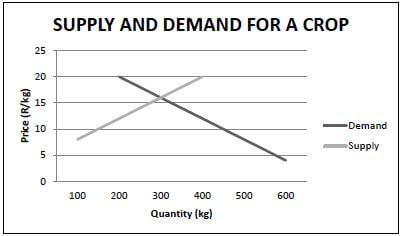
Allocation of marks:
- Applicable heading✔
- Labelling and values of x-axis and y-axis✔
- Labelling graphs✔
- Correct supply graph✔
- Correct demand graph✔ (5)
3.8.2 Price at market equilibrium
- R16,00✔ (1)
3.8.3 TWO possible reasons for the shortage
- Consumers buy more when price is low and with no increase in supply, leads to a shortage ✔
- Farmers supply/market less of a crop when price is low that tend to lead to shortages because of a higher demand from consumers ✔
- Socio-economic factors – when people have more money they buy more and shortages can occur during higher buying timeframes ✔
- Natural disasters/hail/floods/drought causes less products to be harvested ✔
- Seasonal yields differ between different years. Demand increases that leads to shortages ✔ (Any 2) (2)
3.8.4 TWO strategies to deal with shortages
- Modify planting or harvesting times✔ – to supply sufficiently during periods of short supply ✔
- Process products✔ – to prolong shelf life so that they could be sold during periods of short supply ✔ (4) [50]
QUESTION 4: HARVESTING, PROCESSING, MANAGEMENT AND AGRITOURISM
4.1 Harvesting
4.1.1 Factors take into consideration during harvesting a crop
- Availability of transport ✔
- Labour requirements ✔
- Storage ✔
- Weather conditions ✔
- Marketing trends ✔ (Any 4) (4)
4.1.2 Describing basic principles of post-harvest handling
- Handle with care to avoid damage or cutting or crushing or bruising of the produce ✔
- Remove damaged items from good quality items during the sorting process ✔ (2)
4.2 Storage
4.2.1 Storage facility in the picture
- Silo ✔ (1)
4.2.2 Environmental factors that are controlled in a silo
- Temperature ✔
- Moisture/Humidity ✔
- Air ✔
- Light ✔ (Any 3) (3)
4.3 Difference between sorting and grading (6)
Sorting | Grading |
Removal at first sight of some undesirable additional materials e.g. leaves or stones ✔ | The assessment of a number of characteristics of a product to obtain an indication of its overall quality ✔ |
Separation of raw materials into categories on the basis of shape, size, weight, image and colour ✔ | An expensive operation due to long process of setting standards ✔ |
Segregating grains, fruit or vegetables between marketable and unmarketable products ✔ | Requires skilled personnel ✔ |
4.4 Processing
4.4.1 THREE fermentation processes that van be used in preservation
- Sugar fermentation ✔
- Milk sugar/lactose fermentation ✔
- Acid forming fermentation ✔ (3)
4.4.2 Effect of moisture in the cooling process
- Moisture enhances the cooling process/Makes the process faster ✔
- If moisture froze it can damage the product ✔ (2)
4.5 Agricultural chain
4.5.1 Schematic presentation of an agri-business chain 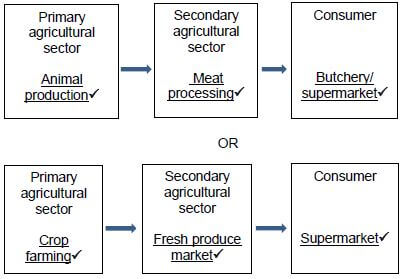 (3)
(3)
4.5.2 THREE tertiary sector inputs
- Storage ✔
- Transport ✔
- Marketing agents ✔
- Market agents ✔
- Advertising companies ✔
- Finance brokers ✔
- Insurance brokers ✔ (Any 3) (3)
4.6 Main functions performed by packaging
- To contain the product ✔
- To protect the product ✔
- To sell the product ✔ (3)
4.7 Factors indicating viability of value adding
- Equipment available ✔
- Facilities available ✔
- Demand for processed product ✔ (Any 2) (2)
4.8 Scenario agritourism
4.8.1 Definition of the term product route
- Agritourism route where tourists see and learn ✔
- About all stages of the production of an agricultural product ✔ (2)
4.8.2 Activities in the scenario
- Touring the rooibos route ✔
- Viewing and feeling the tea plants in their natural state ✔
- Learning about the harvesting and curing of the final product ✔
- Learning the history of the rooibos plant ✔ (Any 2) (2)
4.8.3 Aspects that illustrate educational potential
- Knowledge of the cultural and historical heritage of the place ✔
- Sustainable utilisation of our natural resources ✔
- Promotion of healthier eating habits ✔ (3)
4.8.4 THREE entrepreneurial characteristics in the scenario
- Hardworking ✔
- Creative ✔
- Can identify unique opportunities ✔
- Confident ✔ (Any 3) (3)
4.9 Management
4.9.1 Role of farm manager in maintaining the financial viability
- Planning the production process ✔
- Organizing the different activities on the farm ✔
- Coordination of all sectors of the production process ✔
- Controlling the production process ✔
- Decision making on a day to day basis ✔
- Motivation of labour force ✔ (Any 4) (4)
4.9.2 FOUR basic types of coordination
- Informal coordination✔
- Programmed coordination✔
- Liaison coordination✔
- Group coordination ✔ (4) [50]
TOTAL SECTION B: 150
GRAND TOTAL: 200
ACCOUNTING GRADE 12 MEMORANDUM - NSC PAST PAPERS AND MEMOS FEBRUARY/MARCH 2018
ACCOUNTING
GRADE 12
NSC PAST PAPERS AND MEMOS
FEBRUARY/MARCH 2018
MARKS: 300
MARKING PRINCIPLES:
- Unless otherwise stated in the marking guideline, penalties for foreign items are applied only if the candidate is not losing marks elsewhere in the question for that item (no penalty for misplaced item). No double penalty applied.
- Penalties for placement or poor presentation (e.g. details) are applied only if the candidate is earning marks on the figures for that item.
- Full marks for correct answer. If answer incorrect, mark the workings provided.
- If a pre-adjustment figure is shown as a final figure, allocate the part-mark for the working for that figure (not the method mark for the answer). Note: if figures are stipulated in memo for components of workings, these do not carry the method mark for final answer as well.
- Unless otherwise indicated, the positive or negative effect of any figure must be considered to award the mark. If no + or – sign or bracket is provided, assume that the figure is positive.
- Where indicated, part-marks may be awarded to differentiate between differing qualities of answers from candidates.
- This memorandum is not for public distribution, as certain items might imply incorrect treatment. The adjustments made are due to nuances in certain questions.
- Where penalties are applied, the marks for that section of the question cannot be a final negative.
- Where method marks are awarded for operation, the marker must inspect the reasonableness of the answer and at least one part must be correct before awarding the mark.
- Operation means 'check operation'. 'One part correct' means operation and one part correct. Note: check operation must be +, -, x, ÷, or per memo.
- In calculations, do not award marks for workings if numerator & denominator are swapped – this also applies to ratios.
- In awarding method marks, ensure that candidates do not get full marks for any item that is incorrect at least in part. Indicate with a ⌧.
- Be aware of candidates who provide valid alternatives beyond the marking guideline. 14. Codes: f = foreign item; p = placement/presentation.
These marking guidelines consist of 16 pages.
MEMORANDUM
QUESTION 1
1.1 DEBTORS' AGE ANALYSIS
1.1.1
Explain why the debtors' age analysis is considered to be an effective internal control measure. State ONE point.
| 2 MARKS |
1.1.2
| Explain TWO different problems highlighted by the debtors' age analysis. In EACH case, provide the name of a debtor and figure(s). Give marks for debtor & figures even if problem incorrectly identified | ||
PROBLEM | DEBTOR AND FIGURE(S) | |
Debtors exceeding credit limits | P. Botha (by R700) | |
Overdue accounts/not complying with credit terms/slow payers | S. Walker (R8 500 overdue) | |
Poor control of granting credit / Continue selling to debtors whose accounts are overdue | M. Valley (R950) | 6 marks |
1.2 DEBTORS' RECONCILIATION
1.2.1 CORRECTIONS TO THE DEBTORS' CONTROL ACCOUNT ON 30 NOVEMBER 2017
Balance before errors and omissions | 25 700 | |
(i) | +2 700 ✔ | |
(ii) | +350 ✔ | |
(iii) no part-marks | – 1 800 ✔✔ | |
(iv) | No change ✔ | |
(v) | +1 500 ✔ | |
Correct Debtors' Control balance | 28 450 ? | 7 marks |
| accept brackets for -ve amounts; no sign indicates +ve accept “0 or –“ for “no change” | ||
1.2.2 DEBTORS' LIST ON 30 NOVEMBER 2017
L Nkosi (5 700 – 1 800 ✔) | 3 900 ✔ | |
S Muller (11 100 + 350 ✔) | 11 450 ✔ | |
M Welthagen (– 1 900 + 1 500✔) | (400) ✔ | |
B Sandleni (15 900 – 1 200 ✔ – 1 200 ✔) | 13 500 ? | |
Correct total of Debtors' List | 28 450 ? | 10 marks |
1.3.1 Calculate the VAT amount that is either receivable from or payable to SARS on 31 July 2017.
MARK ONE LINE ONLY (DO NOT MIX LINES) One part correct OR –67 200 two marks +21 000 two marks OR +67 200 two marks –21 000 two marks * Sales less returns # Purchases less drawings
| 11 marks | |||||||||
1.3.2 Nomvula has ordered goods with a marked price of R35 000 from Beta Suppliers.
The sales director of Beta Suppliers, Jim Frow, has offered to sell these goods to Nomvula for R15 000, provided that they do not have to issue an invoice.
| 4 marks |
TOTAL MARKS: 40
QUESTION 2
2.1
2.1.1 | Asset ✔ | |
2.1.2 | Specific identification ✔ | |
2.1.3 | Periodic ✔ | 3 marks |
2.2.1
Calculate the value of the closing stock according to the FIFO method on 31 December 2017. | 6 marks |
2.2.2
Calculate the cost of sales. OR: Using units sold:
Calculate the gross profit. | 8 marks |
2.2.3
Calculate the value of the closing stock on 31 December 2017 by using the weighted-average method. 1 068 600 ✔? one part correct | 6 marks |
What will be the effect on the gross profit if the owner changes to this valuation method? Provide figures. If candidate indicates increase then inspect workings above Gross profit will decrease / be less ✔ * by 9 900 ?? (181 500 – 171 600) see 2.2.1 see 2.2.3 | 3 marks |
2.3 You are provided with information relating to Leno Furnishers. They sell tables, chairs and beds for cash only. The owner is concerned that the figures provided reflect poor internal control and decision-making.
| Identify ONE problem for each product. Quote figures. In EACH case, give advice on how to solve the problem. | |||
Product | Problem ✔✔✔ | Advice | |
Tables |
|
| |
Chairs |
|
| |
Beds |
|
| 9 marks |
TOTAL MARKS : 35
QUESTION 3
3.1 GLAMOUR DRESS CREATIONS
3.1.1 PRODUCTION COST STATEMENT FOR THE YEAR ENDED 28 FEBRUARY 2017.
| Raw/Direct materials cost (918 550 ✔ + 5 250 ✔✔) | 923 800 ?* | |
Direct labour cost ( 810 000 three marks ) OR: Solve for Y OR 753 300+48 600+801 900 = 99% DLC = 101% 801 900 x 101/99 | 818 100 ?* | |
| Prime cost DMC + DLC | 1 741 900 ? | |
Factory overhead cost (227 240 ✔ + 63 96o✔✔✔✔) [(87 100 one mark – 7 150 two marks) x 80% one mark] | 291 200 ?* | |
| Total manufacturing cost operation | 2 033 100 ? | |
| Work-in-process (1 March 2016) | 76 000 | |
| 2 109 100 | ||
| Work-in-process (28 February 2017) operation | (169 100) ? | |
Cost of production of finished goods | 1 940 000 ✔✔?* | 21 marks |
| -1 foreign items (max -2) | *one part correct |
3.1.2
Calculate the net profit for the year ended 28 February 2017. 79 950 X 20% = 625 000 ✔ one part correct | 7 marks |
3.2 LIGHTING SOLUTIONS
3.2.1
Calculate the factory overhead cost per unit for the year ended 31 December 2017.
| 2 marks |
3.2.2
Explain why George would not be concerned about the 28,1% increase in total variable cost from R936 600 to R1 200 000.
| 3 marks |
3.2.3
Give TWO reasons for the increase in the selling and distribution cost per unit.
Do not accept increased sales / increased delivery expenses | 2 marks |
3.2.4
Calculate the break-even point for the year ended 31 December 2017. 575 000 ✔ | 4 marks |
Comment on the production level for 2017. State TWO points. Quote figures. Comparison figures not necessary but may enhance answer
| 4 marks |
3.2.5
Lighting Solutions are considering importing raw materials because it is cheaper and of a higher quality. Name TWO aspects that they must consider before finalising their decision. Any TWO relevant aspects ✔ ✔
| 2 marks |
TOTAL MARKS : 45
QUESTION 4
4.1
4.1.1 | C ✔ | |
4.1.2 | E ✔ | |
4.1.3 | D ✔ | |
4.1.4 | A ✔ | |
4.1.5 | B ✔ | 5 marks |
4.2 ORBIT LTD
4.2.1
(a) ORDINARY SHARE CAPITAL
| Authorised | |||
| 6 000 000 shares | |||
| Issued | |||
| 4 200 000 ✔ | Ordinary shares in issue at beginning of year | 3 150 000 ✔ | |
(60 000) ✔ Ignore brackets | Shares repurchased during the year at R0,75✔✔ (ASP) one part correct | *(45 000) Ignore brackets✔* | |
| 4 140 000 ✔ | Ordinary shares in issue at end of year one part correct must subtract repurchase | 3 105 000 ✔ | 8 marks |
| *Do not accept: R210 000 or 60 000 x R3,50 | |||
(b) RETAINED INCOME
| Balance on 1 July 2016 | 874 000 | |
Net profit after income tax (408 800 ✔ x 72/28 ✔) | 1 051 200 ?* | |
| Shares repurchased (60 000 x R2,75 ?) 3,50 – ASP above OR: 210 000 – figure for repurchase in (a) | **(165 000) | |
| Ordinary share dividends | (1 540 800) Ignore brackets✔* | |
| Interim (paid) | 630 000 ✔ | |
| Final (recommended) (4 140 000 ✔ x 22 cents ✔ or 0,22 / 22% | 910 800 ✔* | |
Balance on 30 June 2017 *one part correct & repurchase and OSD must be subtracted | 219 400 ✔* | 11 marks |
| *One part correct ** do not accept 210 000 or 0; | ||
4.2.2 ORBIT LTD
BALANCE SHEET ON 30 JUNE 2017.
| ASSETS | |||
| NON-CURRENT ASSETS TA – CA | 3 822 600 | ||
| Fixed/Tangible Assets balancing figure | 3 442 600 | ||
| Fixed deposit | 2 | 380 000 | |
| CURRENT ASSETS operation | 1 037 800 | ||
| Inventory | 478 000 | ||
Trade and other receivables | 309 100 | ||
| Cash and cash equivalents | 250 700 | ||
| TOTAL ASSETS see Total Equity and Liabilities | 9 | 4 860 400 | |
| EQUITY AND LIABILITIES | |||
| SHAREHOLDERS' EQUITY operation | 3 324 400 | ||
| Ordinary share capital see 4.2.1 | 3 | 3 105 000 | |
| Retained income see 4.2.1 | 219 400 | ||
| NON-CURRENT LIABILITIES | 320 000 | ||
Loan: Helping Bank | 4 | 320 000 | |
| CURRENT LIABILITIES operation | 1 216 000 | ||
| Award all marks if all items included in T&OP | 246 400 | ||
| Trade and other payables one part correct (239 800 ✔ + 6 600 ✔ ) | |||
| Shareholders for dividends see 4.2.1 | 910 800 | ||
SARS: Income tax (408 800 – 390 000) | 18 800 | ||
| Current portion of loan see loan | 40 000 | ||
| TOTAL EQUITY AND LIABILITIES operation | 10 | 4 860 400 | 28 marks |
| Misplaced items mark figures but-1 each time (as per Nov 2017) Foreign entries -1 (max -2) Presentation / Incorrect or incomplete details -1 (max -2) SARS may not be shown as a current asset | |||
4.2.3
As a shareholder, explain your concern regarding the proposed buy-back of shares. Provide calculations to support your concern. | 6 marks |
4.3 AUDIT REPORT: DF ENTERPRISES LTD
4.3.1
(a) | External ✔ | |
(b) | Directors ✔ | 2 marks |
4.3.2
| (a) The audit report below indicates a/an (qualified/unqualified) opinion. Qualified ✔ | 1 mark |
(b) Explain why the shareholders should be concerned about this audit report. State TWO points.
| 4 marks |
TOTAL MARKS: 65
QUESTION 5
5.1
| NO. | WORKINGS | AMOUNT | |
| a) | Additions to buildings OR (b) below (c) below OR 4 934 450 – 300 000 + 97 600 + 270 280 – 3 993 390 | 1 008 940 ? one part correct | 4 marks |
| b) | Total depreciation on equipment Old: 1 126 400 ✔ x 20% = 225 280 ? one part correct | 270 280 ? one part correct | 6 marks |
| c) | Disposal of equipment at carrying value 1 126 400 + 300 000 – 270 280 – 1 058 520 See (ii) above | 97 600 ? one part correct | 5 marks |
| 15 marks |
| WORKINGS | ANSWER | ||||||||
| 5.2.1 | Calculate the Income tax paid. Accept reversed signs | 124 940 ? one part correct Accept -ve or brackets | 5 marks | ||||||
| 5.2.2 | Calculate the dividends paid. Accept reversed signs OR: 50 000 + 168 000 – 98 000 | 120 000 ? one part correct must be +ve Accept -ve or brackets | 3 marks | ||||||
| 5.2.3 | Calculate the net change in cash and cash equivalents. Signs are important here
| – 270 000 ✔ | 4 marks |
5.3
| CASH EFFECTS OF FINANCING ACTIVITIES one part correct | 562 500 ? | |
Proceeds from shares issued | 1 270 000 ? One part correct | |
Funds used to repurchase shares 25 000 x R6,30 | (157 500)✔✔ 157 500 with no brackets award 1 mark | |
Change in loan 1 300 000 – 750 000 | (550 000)✔✔ 550 000 with no brackets award 1 mark | 10 marks |
| 5.4.1 | Calculate the debt-equity ratio. 750 000 ✔ : 4 375 250 ✔ = 0,2 : 1 ? one part correct (accept 0,17 : 1) | 3 marks |
| 5.4.2 | Calculate the earnings per share (in cents). | 3 marks |
| 5.4.3 | Calculate the return on average shareholders' equity (ROSHE). | 5 marks |
5.5
Explain why the directors felt that the 630 cents offered on the shares repurchased was a fair price. Quote TWO financial indicators with figures. Comparison to market price ✔ Figures ✔
| 4 marks |
5.6.1
The directors revised the dividend pay-out policy for the current financial year.
|
5.6.2
Give ONE reason why the directors took this decision.
| 2 marks |
5.6.3
Explain why the shareholders may not be satisfied with the return they earned. Quote a financial indicator or figure(s). |
5.7 Apart from the dividends, identify THREE good decisions. Explain the effect of each decision on the company. Quote figures.
GOOD DECISION ✔ ✔ ✔ | EFFECT ON COMPANY ✔ ✔ ✔ | |
Reducing or paying a large portion of the loan by R550 000 OR: Decreased loan from R1 300 000 to R750 000 | Reduced financial risk / Improved the debt equity ratio from 0,4 :1 to 0,2 : 1 see 5.4.1 OR The ROTCE improved from 6,4% to 11,4%; closer to the interest rate of 12% (still negatively geared). | |
Issue new shares; R1 270 000* |
| |
Purchase of fixed assets; R1 308 930 (1 008 940 + 300 000) see 5.1(a) |
| 9 marks |
*Also: | ||
TOTAL MARKS : 70
QUESTION 6
6.1.1
Calculate the mark-up percentage on spare parts used in the Projected Income Statement for March 2018. 22 875✔ / 30 500✔ x 100 = 75%✔ one part correct | 3 marks |
6.1.2
Calculate % decrease in service fee income expected in April 2018. | 3 marks |
6.1.3
Calculate the additional space (in square metres) the business will rent from April 2018. 6 000 / 75 = R80 ✔✔ OR 3 200 one mark | 4 marks |
6.1.4
Calculate the interest rate on the fixed deposit. | 5 marks |
6.2
Comment on the control of stock and explain how Vusi intends to correct this. Quote figures.
| 4 marks |
6.3.1
Vusi is thinking of purchasing the business premises rather than renting it. State ONE advantage and ONE disadvantage of this option. Advantage ✔✔ part-mark for unclear / incomplete answer
Disadvantage ✔✔ part-mark for unclear / incomplete answer
| 4 marks |
6.3.2
Vusi offers a free delivery service of spare parts to customers, but plans to discontinue this service on 31 March 2018.
| 4 marks |
6.3.3
Calculate the cost of the new vehicle that he plans to purchase on 1 April 2018. 9 000 ✔ x 12 ✔ = R720 000 ? one part correct | 4 marks |
6.4.1
Explain whether Water and electricity has been well controlled, or not.
OR
| 3 marks |
6.4.2
Explain whether you agree with Vusi's decision not to use the full budget for Advertising.
| 3 marks |
6.4.3
Explain whether Consumable stores have been well controlled, or not.
| 4 marks |
6.4.4
Explain how Vusi's decision about the mark-up percentage on spare parts has affected the business.
| 4 marks |
TOTAL MARKS : 45
TOTAL: 300
ACCOUNTING GRADE 12 QUESTIONS - NSC PAST PAPERS AND MEMOS FEBRUARY/MARCH 2018
ACCOUNTING
GRADE 12
NSC PAST PAPERS AND MEMOS
FEBRUARY/MARCH 2018
INSTRUCTIONS AND INFORMATION
Read the following instructions carefully and follow them precisely.
- Answer ALL the questions.
- A special ANSWER BOOK is provided in which to answer ALL the questions.
- Show ALL workings to earn part-marks.
- You may use a non-programmable calculator.
- You may use a dark pencil or blue/black ink to answer the questions.
- Where applicable, show all calculations to ONE decimal point.
- Write neatly and legibly.
- Use the information in the table below as a guide when answering the question paper. Try NOT to deviate from it.
QUESTION 1: 40 marks; 25 minutes | |
Topic: | This question integrates: |
Debtors' Reconciliation and VAT | Financial accounting
Managing resources
|
| QUESTION 2: 35 marks; 20 minutes | |
| Topic: | This question integrates: |
| Inventory Valuation and Internal Control | Managing resources
|
| QUESTION 3: 45 marks; 25 minutes | |
| This question integrates: | |
| Manufacturing | Managerial accounting
Managing resources
|
| QUESTION 4: 65 marks; 40 minutes | |
| This question integrates: | |
| Balance Sheet and Audit Report | Financial accounting
Managing resources
|
| QUESTION 5: 70 marks; 45 minutes | |
| Topic: | This question integrates: |
| Fixed Assets, Cash Flow and Interpretation | Financial accounting
Managing resources
|
| QUESTION 6: 45 marks; 25 minutes | |
| Topic: | This question integrates: |
| Projected Income Statement | Managerial accounting
Managing resources
|
QUESTIONS
QUESTION 1: DEBTORS' RECONCILIATION AND VAT (40 marks; 25 minutes)
1.1 DEBTORS' AGE ANALYSIS
The information below relates to Witbank Hardware.
REQUIRED:
1.1.1 Explain why the debtors' age analysis is considered to be an effective internal control measure. State ONE point. (2)
1.1.2 Explain TWO different problems highlighted by the debtors' age analysis. In EACH case, provide the name of a debtor and figure(s). (6)
INFORMATION:
- Debtors are granted 30 days to settle their accounts.
- Debtors' age analysis on 31 October 2017:
DEBTORS | CREDIT LIMIT | AMOUNT OWING | CURRENT MONTH | 30 DAYS | 60 DAYS | 90 DAYS |
Z Zulu | 6 000 | 5 000 | 2 100 | 2 900 | ||
P Botha | 3 500 | 4 200 | 3 800 | 400 | ||
M Valley | 7 000 | 1 450 | 500 | 950 | ||
S Walker | 13 000 | 12 500 | 1 000 | 3 000 | 4 500 | 4 000 |
O Klein | 3 000 | 3 000 | 1 900 | 1 100 | ||
| 26 150 | 9 300 | 6 300 | 5 600 | 4 950 | ||
100% | 36% | 24% | 21% | 19% |
1.2 DEBTORS' RECONCILIATION
Information from the records of Amber Traders for November 2017 is presented. Some errors and omissions were noted. See information B.
REQUIRED:
1.2.1 Calculate the correct Debtors' Control Balance on 30 November 2017. Show figures and indicate '+', '–' or 'No change' at EACH adjustment. (7)
1.2.2 Calculate the correct total of the debtors' list on 30 November 2017. (10) INFORMATION:
A. Balances on 30 November 2017 before errors and omissions:
- Debtors' Control, R25 700
- Debtors' list:
DEBIT | CREDIT | |
L Nkosi | R5 700 | |
S Muller | R11 100 | |
M Welthagen | R1 900 | |
B Sandleni | R15 900 | |
R32 700 | R1 900 |
B. Errors and omissions:
- The total of the Debtors' Journal was undercast by R2 700.
- Interest of R350 must be charged on the overdue account of S Muller.
- An amount of R3 100 received from L Nkosi was incorrectly recorded as R1 300 in the Cash Receipts Journal and posted as such to the General Ledger and the Debtors' Ledger.
- Trading stock returned by B Sandleni was posted to the wrong side of his Debtors' Ledger Account, R1 200.
- No entry was made for a credit sales invoice issued to M Welthagen, R1 500.
1.3 VAT
The information relates to Aqua Stores for the VAT period ended 31 July 2017. The business is owned by Nomvula Sithole. All goods sold are subject to 14% VAT.
REQUIRED:
1.3.1 Calculate the VAT amount that is either receivable from or payable to SARS on 31 July 2017. (11)
1.3.2 Nomvula has ordered goods with a marked price of R35 000 from Beta Suppliers. The sales director of Beta Suppliers, Jim Frow, has offered to sell these goods to Nomvula for R15 000, provided that they do not have to issue an invoice. Comment on the offer made by Jim. State TWO points. (4)
INFORMATION:
- Amount owed by SARS on 1 July 2017, R27 200.
- Amounts from the Journals on 31 July 2017:
DETAILS | EXCLUDING VAT | VAT AMOUNT | INCLUDING VAT |
Total sales | R495 000 | R69 300 | R564 300 |
Purchases of stock | 159 000 | 22 260 | 181 260 |
Stock returned by debtors | 15 000 | ? | 17 100 |
Bad debts | ? | ? | 34 200 |
C. The following transactions were not taken into account:
- Stock taken by the owner, cost price R9 000 (excluding VAT).
- VAT on discount received from suppliers. Total discount received amounted to R33 630.
QUESTION 2: INVENTORY VALUATION AND INTERNAL CONTROL (35 marks; 20 minutes)
2.1 Choose the correct word(s) from those given in brackets. Write only the word(s) next to the question number (2.1.1–2.1.3) in the ANSWER BOOK.
2.1.1 Merchandise purchased is recorded as an (asset/expense) to the business in the perpetual inventory system. (1)
2.1.2 The (specific identification/weighted-average) stock valuation method is best suited for unique high-value products. (1)
2.1.3 Cost of sales is usually calculated at the end of the financial year in the (periodic/perpetual) inventory system. (1)
2.2 MONGI TRADERS
You are provided with information relating to Mongi Traders. The business sells one type of plastic table. Their financial year ends on 31 December. The business uses the FIFO method to value their stock. They use the periodic inventory system.
REQUIRED:
2.2.1 Calculate the value of the closing stock according to the FIFO method on 31 December 2017. (6)
2.2.2 Calculate the following for the year ended 31 December 2017:
- Cost of sales
- Gross profit (8)
2.2.3 The owner considers changing the stock valuation method to the weighted-average method.
- Calculate the value of the closing stock on 31 December 2017 by using the weighted-average method. (6)
- What will be the effect on the gross profit if the owner changes to this valuation method? Provide figures. (3)
INFORMATION:
A. Inventories:
DATE | NUMBER OF UNITS | PER UNIT | TOTAL VALUE |
1 January 2017 | 540 | R350 | R189 000 |
31 December 2017 | 440 | ? | ? |
B. Purchases and returns in 2017:
Purchases: | ||||||
DATE | NO. OF UNITS | PER UNIT | TOTAL PURCHASES | CARRIAGE PER UNIT | TOTAL CARRIAGE | TOTAL PURCHASE COST |
31 Mar. | 550 | R370 | R203 500 | R13 750 | R217 250 | |
30 Jun. | 900 | R380 | R342 000 | R22 850 | R364 850 | |
30 Sep. | 500 | R350 | R175 000 | R25 | R12 500 | R187 500 |
30 Nov. | 300 | R400 | R120 000 | R30 | R9 000 | R129 000 |
Totals | 2 250 | R840 500 | R58 100 | R898 600 | ||
| Returns: | ||||||
| DATE | NO. OF UNITS | PER UNIT | TOTAL RETURNS | CARRIAGE PER UNIT | TOTAL CARRIAGE | |
| 5 Jul. | 50 | R380 | R19 000 | 0 | 0 | |
| These returns are from the purchases of June 2017. There is no refund for carriage | ||||||
C. Sales:
2 300 units at R600 each = R1 380 000
2.3 INTERNAL CONTROL
You are provided with information relating to Leno Furnishers. They sell tables, chairs and beds for cash only. The owner is concerned that the figures provided reflect poor internal control and decision-making.
Identify ONE problem for each product. Quote figures. In EACH case, give advice on how to solve the problem. (9)
INFORMATION:
Information from the records for the financial year:
TABLES | CHAIRS | BEDS | |
Opening stock (units) | 50 | 209 | 300 |
Units purchased | 670 | 2 390 | 380 |
Units sold | 600 | 2 400 | 480 |
Units as per physical count at year-end | 90 | 199 | 200 |
Selling price per unit | R1 500 | R800 | R3 000 |
Total sales (amounts actually deposited) | R900 000 | R1 800 000 | R1 440 000 |
QUESTION 3: MANUFACTURING (45 marks; 25 minutes)
3.1 GLAMOUR DRESS CREATIONS
Glamour Dress Creations manufactures one type of ladies' dress. The financial year ended on 28 February 2017.
REQUIRED:
3.1.1 Prepare the Production Cost Statement for the year ended 28 February 2017. (21)
3.1.2 Calculate the net profit for the year ended 28 February 2017. (7)
INFORMATION:
A. Stock balances, among others, were taken from the General Ledger:
28 FEBRUARY 2017 | 1 MARCH 2016 | |
Work-in-process stock | ? | R76 000 |
Finished goods stock | R190 000 | R110 000 |
B. Information extracted from the financial records on 28 February 2017:
Administration cost | R259 010 |
Raw/Direct material cost | 918 550 |
Factory overhead cost | 227 240 |
Selling and distribution cost | 410 000 |
Net wages paid to factory workers (direct labour) | 753 300 |
SARS: PAYE | 48 600 |
UIF deductions | 1% |
Sales | ? |
Cost of sales | 1 860 000 |
C. The following information has not been taken into account:
- A problem was identified regarding the valuation of the closing stock of raw materials: 5 000 metres of material on hand, with a unit cost of R2,75 per metre, were erroneously recorded as R3,80 per metre.
This must be corrected. - Rent expense was omitted from the figures above. Total rent paid for the financial year amounted to R87 100. The rent for March 2017 has been paid in advance. The rent was increased by R650 on 1 December 2016. 80% of this expense must be allocated to the factory and the balance must be regarded as an office expense.
- The employer contributes 1% to UIF on behalf of the employees.
D. The business uses a mark-up percentage of 75% on cost. During the financial year special discounts of R85 000 were offered to cash customers who bought in bulk.
3.2 LIGHTING SOLUTIONS
George Mkize is the owner of Lighting Solutions, a manufacturing business that produces one type of energy-saving light bulb. The financial year ended on 31 December 2017.
NOTE:
- Production is based on orders received; therefore there are no balances for work-in-process.
- The current inflation rate is 8%.
REQUIRED:
3.2.1 Calculate the factory overhead cost per unit for the year ended 31 December 2017. (2)
3.2.2 Explain why George would not be concerned about the 28,1% increase in total variable cost from R936 000 to R1 200 000. (3)
3.2.3 Give TWO reasons for the increase in the selling and distribution cost per unit. (2)
3.2.4 George wants to know if the production level for this financial year is satisfactory.
- Calculate the break-even point for the year ended 31 December 2017. (4)
- Comment on the production level for 2017. State TWO points. Quote figures. (4)
3.2.5 Lighting Solutions are considering importing raw materials because it is cheaper and of a higher quality. Name TWO aspects that they must consider before finalising their decision. (2)
INFORMATION:
Information from the records of Lighting Solutions on 31 December:
2017 | 2016 | |||
TOTAL (R) | UNIT COST (R) | TOTAL (R) | UNIT COST (R) | |
Fixed costs: | 575 000 | 11,50 | 428 400 | 10,20 |
Factory overhead cost | 395 000 | (3.2.1) | 310 800 | 7,40 |
Administration cost | 180 000 |
| 117 600 | 2,80 |
| Variable costs: | 1 200 000 | 24,00 | 936 600 | 22,30 |
| Direct material cost | 435 000 | 8,70 | 344 400 | 8,20 |
Direct labour cost | 560 000 | 11,20 | 441 000 | 10,50 |
Selling and distribution cost | 205 000 | 4,10 | 151 200 | 3,60 |
Selling price per unit | R45,00 | R41,50 | ||
Number of units produced and sold | 50 000 | 42 000 | ||
Break-even point (units) | ? | 22 313 | ||
QUESTION 4: BALANCE SHEET AND AUDIT REPORT (65 marks; 40 minutes)
4.1 Choose a description from COLUMN B that matches the term in COLUMN A. Write only the letter (A–E) next to the question number (4.1.1–4.1.5) in the ANSWER BOOK.
COLUMN A | COLUMN B |
4.1.1 Income Statement |
|
(5 x 1) (5)
4.2 ORBIT LTD
Refer to the information from the records of Orbit Ltd for the financial year ended 30 June 2017.
REQUIRED:
4.2.1 Prepare the following notes to the Balance Sheet:
- Ordinary share capital (8)
- Retained income (11)
4.2.2 Complete the Balance Sheet on 30 June 2017. Where notes are not required, show ALL workings in brackets. (28)
4.2.3 The CFO (chief financial officer), Barry Wright, has convinced the company to buy back a further 400 000 shares from his close relative during the next financial year. Barry currently owns 1 904 400 shares in this company, which is 46% of the issued shares.
As a shareholder, explain your concern regarding the proposed buy-back of shares. Provide calculations to support your concern. (6)
INFORMATION:
A. Extract from the books on 30 June 2017:
Fixed/Tangible assets (carrying value) | ? |
Fixed deposit: Morocco Bank | 380 000 |
Ordinary share capital (1 July 2016) | 3 150 000 |
Retained income (1 July 2016) | 874 000 |
Bank (favourable) | 250 700 |
Loan: Helping Bank | 302 400 |
Trading stock | 478 000 |
Debtors' control | 317 000 |
Creditors' control | 239 800 |
Income received in advance | 6 600 |
SARS: Income tax (provisional payments) | 390 000 |
Dividends on ordinary shares (interim dividends) | 630 000 |
B. Share capital:
- The business has an authorised share capital of 6 000 000 shares.
- 70% of the shares were in issue on 1 July 2016.
- 60 000 ordinary shares were repurchased from a disgruntled shareholder on 1 December 2016. The company paid R3,50 per share. This was paid and recorded on 1 December 2016.
C. A final dividend of 22 cents per share was declared on 30 June 2017. Only shares in the share register qualify for final dividends.
D. The following adjustments have not been taken into account yet:
- Provision for bad debts is set at 5% of the outstanding debtors.
- Insurance included an annual premium of R31 800, paid for the period 1 October 2016 to 30 September 2017.
E. The loan statement from Helping Bank reflected the following:
Balance on 1 July 2016 | R480 000 |
Repayments during financial year (including interest) | R177 600 |
Interest capitalised | R57 600 |
Balance on 30 June 2017 | ? |
R40 000 of the loan will be paid back in the next financial year.
F. Income tax for the year amounted to R408 800. This was calculated at 28% of the corrected net profit.
4.3 AUDIT REPORT: DF ENTERPRISES LTD
REQUIRED:
4.3.1 Choose the correct word(s) from those given in brackets. Write only the word(s) next to the question number (4.3.1(a)–4.3.1(b)) in the ANSWER BOOK.
- The audit report is completed by the (internal/external) auditor. (1)
- The (directors/shareholders/auditors) are responsible for the preparation of the financial statements. (1)
4.3.2 Refer to the audit report below.
- The audit report below indicates a/an (qualified/unqualified) opinion. (1)
- Explain why the shareholders should be concerned about this audit report. State TWO points. (4)
INFORMATION:
EXTRACT FROM THE AUDIT REPORT OF DF ENTERPRISES LTD
Audit Opinion
|
QUESTION 5: FIXED ASSETS, CASH FLOW AND INTERPRETATION (70 marks; 45 minutes)
MAFOKO LTD
The given information relates to Mafoko Ltd for the financial year ended 28 February 2017.
REQUIRED:
5.1 Refer to Information A and Information B.
Calculate the missing amounts denoted by (a) to (c) on the Fixed Asset Note. (15)
5.2 Calculate the following amounts for the Cash Flow Statement:
5.2.1 Income tax paid (5)
5.2.2 Dividends paid (3)
5.2.3 Net change in cash and cash equivalents (4)
5.3 Complete the Cash Effects of Financing Activities section of the Cash Flow Statement. (10)
5.4 Calculate the following financial indicators on 28 February 2017:
5.4.1 Debt-equity ratio (3)
5.4.2 Earnings per share (in cents) (3)
5.4.3 Return on average shareholders' equity (ROSHE) (5)
5.5 Explain why the directors felt that the 630 cents offered on the shares repurchased was a fair price. Quote TWO financial indicators with figures. (4)
5.6 The directors revised the dividend pay-out policy for the current financial year.
5.6.1 Calculate the percentage of earnings distributed as dividends for each year to show this change. (4)
5.6.2 Give ONE reason why the directors took this decision. (2)
5.6.3 Explain why the shareholders may not be satisfied with the return they earned. Quote a financial indicator or figure(s). (3)
5.7 The Cash Flow Statement reflects some important decisions taken by the directors.
Apart from the dividends, identify THREE good decisions. Explain the effect of each decision on the company. Quote figures. (9)
INFORMATION:
A. Information from the financial statements on 28 February:
2017 R | 2016 R | |
Depreciation | ? | ? |
Interest expense | 123 000 | 126 500 |
Net profit before income tax | 422 500 | 157 500 |
Net profit after income tax | 295 750 | 113 400 |
Fixed assets (carrying value) | 4 934 450 | 3 993 390 |
Shareholders' equity | 4 375 250 4 117 500 | 3 135 000 |
Ordinary share capital | 3 000 000 | |
Retained income | 257 750 750 000 | 135 000 |
Non-current liabilities | 1 300 000 | |
Inventories (only Trading Stock) | 288 000 | 363 000 |
Debtors | 318 000 | 254 000 |
Creditors | 287 000 | 367 000 |
Cash and cash equivalents | 2 500 | 245 000 |
Bank overdraft | 27 500 | - |
SARS: Income tax | 5 200 (Cr) | 3 390 (Cr) |
Shareholders for dividends | 98 000 | 50 000 |
B. Fixed Asset Note:
Fixed assets comprise only Buildings and Equipment.
| BUILDINGS | EQUIPMENT | |
| Carrying value (01/03/2016) | 2 866 990 | 1 126 400 |
| Cost (01/03/2016) | 2 200 000 | |
Accumulated depreciation (01/03/2016) | (1 073 600) | |
| Movements: | ||
| Additions | (a) | 300 000 |
Disposals | (c) | |
Depreciation | (b) | |
Carrying value (28/02/2017) | 1 058 520 | |
Cost (28/02/2017) | ||
Accumulated depreciation (28/02/2017) |
- Additional equipment was purchased on 1 June 2016.
- Extensions to the building were completed on 31 August 2016.
- Old equipment was sold at carrying value on 28 February 2017.
- Equipment is depreciated at 20% p.a. using the diminishing-balance method.
C. Share capital and dividends
- The company is registered with an authorised share capital of 1 000 000 ordinary shares.
- On 1 March 2016 there were 500 000 shares in issue. A further 200 000 shares were issued on this date.
- An interim dividend of R70 000 was paid on 31 August 2016.
- On 28 February 2017, 25 000 ordinary shares were repurchased from the estate of a deceased shareholder at R6,30 per share. The average issue price was R6,10 at this point.
- A final dividend was declared on 28 February 2017.
D. Financial indicators on 28 February:
2017 | 2016 | |
Debt-equity ratio | ? | 0,4:1 |
Earnings per share | ? | 23 cents |
Dividend per share | 24 cents | 20 cents |
Return on average shareholders' equity | ? | 3,6% |
Return on total capital employed | 11,4% | 6,4% |
Net asset value per share | 648 cents | 627 cents |
Market price of shares (JSE) | 640 cents | 630 cents |
Interest rate on loans | 12% | 11% |
Interest on fixed deposits | 9% | 8% |
QUESTION 6: PROJECTED INCOME STATEMENT (45 marks; 25 minutes)
You are provided with information relating to Mabuso's Auto Repairs for the period 1 March 2018 to 30 April 2018. The business is owned by Vusi Mabuso.
- All transactions are strictly cash.
- The financial year ends on 30 April each year.
- The business repairs vehicles for which they charge service fees.
- If the repairs require new spare parts, these are charged to each customer's account separately.
- Consumable stores are used for repairing the vehicles. There is no charge for these items.
REQUIRED:
6.1 Calculate the:
6.1.1 Mark-up percentage on spare parts used in the Projected Income Statement for March 2018 (3)
6.1.2 % decrease in service fee income expected in April 2018 (3)
6.1.3 Additional space (in square metres) the business will rent from April 2018 (4)
6.1.4 Interest rate on the fixed deposit (5)
6.2 Comment on the control of stock and explain how Vusi intends to correct this. Quote figures. (4)
6.3 Vusi is considering changes to the fixed assets owned by the business.
6.3.1 Vusi is thinking of purchasing the business premises rather than renting it. State ONE advantage and ONE disadvantage of this option. (4)
6.3.2 Vusi offers a free delivery service of spare parts to customers, but plans to discontinue this service on 31 March 2018. State TWO points to support this decision. (4)
6.3.3 Calculate the cost of the new vehicle that he plans to purchase on 1 April 2018. (4)
6.4 Refer to information E. You are provided with the projected and actual figures for February 2018. Quote figures in your explanation in EACH case below.
6.4.1 Explain whether Water and electricity has been well controlled, or not. (3)
6.4.2 Explain whether you agree with Vusi's decision not to use the full budget for Advertising. (3)
6.4.3 Explain whether Consumable stores have been well controlled, or not. (4)
6.4.4 Explain how Vusi's decision about the mark-up percentage on spare parts has affected the business. (4)
INFORMATION:
A. Extract from the Projected Income Statement for the period 1 March 2018 to 30 April 2018:
| MARCH 2018 | APRIL 2018 | |
| R | R | |
| Service fee income from customers | 150 000 | 136 500 |
| Profit on sale of spare parts | 22 875 | 31 500 |
| Sales | 53 375 | 76 500 |
| Cost of sales | (30 500) | (45 000) |
| Other operating income | ||
| Profit on disposal of delivery vehicle | 8 000 | 0 |
| Gross operating income | ||
| Operating expenses | ||
| Rent expense (see B below) | 6 000 | 9 200 |
| Water and electricity | 5 200 | 5 200 |
| Motor vehicle expenses | 7 500 | 1 500 |
| Security expenses | 5 000 | 9 200 |
| Advertising | 4 700 | 4 700 |
| Consumable stores (used for repair service) | 30 000 | 30 000 |
| Repairs and maintenance of equipment | 15 000 | 0 |
| Depreciation on vehicles (see D below) | 3 000 | 9 000 |
| Depreciation on equipment | 1 500 | 1 500 |
| Trading stock deficit | 14 000 | 2 000 |
| Operating profit | ||
| Interest on fixed deposit (see C below) | 5 700 | 2 700 |
| Net profit |
B. Rent expense is calculated on a fixed amount per square metre. The business will rent 75 square metres in March 2018. On 1 April 2018 additional floor space will be rented at the same rate due to expansion.
C. A fixed deposit of R450 000 will mature on 31 March 2018.
D. Vehicles:
ITEM | COST PRICE | ACCUMULATED DEPRECIATION: 31/03/2018 | DEPRECIATION RATE AND METHOD |
Delivery vehicle | R240 000 | R108 000 | 15% p.a. on cost |
Audi Q7 | ? | 0 |
The delivery vehicle will be sold on 31 March 2018. The Audi Q7 vehicle will be purchased on 1 April 2018 and used by the owner.
E. Figures provided for February 2018:
PROJECTED | ACTUAL | |
Water and electricity (*see note below) | R 4 500 | R 5 000 |
Advertising | 4 700 | 1 800 |
Service fee income | 150 000 | 127 500 |
Consumable stores | 30 000 | 36 450 |
Sale of spare parts | 128 700 | 97 200 |
Cost of sales | 78 000 | 54 000 |
Profit on sale of spare parts | 50 700 | 43 200 |
Mark-up percentage (on cost) | 65% | 80% |
*NOTE: The water and electricity tariff unexpectedly increased by 15% from 1 February 2018.
TOTAL: 300
LITERATURE OVERVIEW GRADE 12 NOTES - STUDY GUIDE
Overview of the English First Additional Language Paper 3: Writing Exam
The Paper 3: Writing exam is 2 ½ hours long. There are THREE sections. You must answer ONE question from EACH of the three sections. The total of the marks for the exam is 100.
Here is a summary of the three sections in the Paper 3: Writing exam:
Section | Text types | What marks are awarded for | Number of marks |
Section A | Essays |
| 30 marks Total: 50 marks |
Section B | Longer transactional texts |
| 18 marks Total: 30 marks |
Section C | Shorter transactional texts |
| 12 marks Total: 20 marks |
It is recommended that you spend the following amount of time on each section:
- Section A: Essays (50 marks) 80 minutes
- Section B: Longer transactional texts (30 marks) 40 minutes
- Section C: Shorter transactional texts (20 marks) 30 minutes
|
Question words
Here are examples of question types found in the exam.
Question type | What you need to do |
Literal: Questions about information that is clearly given in the text or extract from the text | |
Name characters/places/things ... | Write the specific names of characters, places, etc. |
State the facts/reasons/ideas … | Write down the information without any discussion or comments. |
Give two reasons for/why … | Write two reasons (this means the same as ‘state’). |
Identify the reasons … | Write down the reasons. |
Describe the place/character/ what happens when … | Write the main characteristics of something, for example: What does a place look/feel/smell like? Is a particular character kind/rude/aggressive … |
What happened when … | Write what happened. |
Why did this happen … | Given reasons for what happened. |
Who did … | Write down who is responsible for the action. |
To whom does xx refer … | Write the name of the relevant character/ person. |
Reorganisation: Questions that need you to bring together different pieces of information in an organised way. | |
Summarise the main points/ideas … | Write the main points, without a lot of detail. |
Group the common elements … | Join the same things together. |
Give an outline of ….. | Write the main points, without a lot of detail. |
Inference: Questions that need you to interpret (make meaning of) the text using information that may not be clearly stated. This process involves thinking about what happened in different parts of the text; and using your own knowledge to help you understand the text. | |
Explain how this idea links … | Identify the links. |
Compare the attitudes/actions of character x with character y … | Point out the similarities and differences. |
What do the words … suggest/ reveal about /what does this situation tell you about … | State what you think the meaning is, based on your understanding of the text. |
How does x react when …. Describe how something affected … State how you know that x is … | Write down the character's/person's reaction or what the character/person did or felt. |
What did x mean by the expression … | Explain why the character/person used those particular words. |
Is the following statement true or false? | Write ‘true’ or ‘false’ next to the question number. You must give a reason for your answer. |
Choose the correct answer to complete the following sentence (multiple choice question). | A list of answers is given, labelled A–D. Write only the letter (A, B, C or D) next to the question number. |
Complete the following sentence by filling in the missing words … | Write the missing word next to the question number. |
Quote a line from the extract to prove your answer. | Write the relevant line of text using the same words and punctuation you see in the extract. Put quotation marks (“ ” inverted commas) around the quote. |
Evaluation Questions that require you to make a judgement based on your knowledge and understanding of the text and your own experience. | |
Discuss your view/a character’s feelings/a theme ... | Consider all the information and reach a conclusion. |
Do you think that … | There is no ‘right’ or ‘wrong’ answer to these questions, but you must give a reason for your opinion based on information given in the text. |
Do you agree with … | |
In your opinion, what … | |
Give your views on … | |
Appreciation Questions that ask about your emotional response to what happens and how the text is written. | |
How would you feel if you were x when … | There is no ‘right’ or ‘wrong’ answer to these questions, but you must give a reason for your opinion based on information given in the text. |
Discuss your response to … | |
Do you feel sorry for … | |
Discuss the use of the writer’s style, diction and figurative language, dialogue … | To answer this type of question, ask yourself: Does the style help me to feel/ imagine what is happening or how someone is feeling? Why/why not? Give a reason for your answer. |
Words to Know
These are words about writing and text types that you should learn. | |
abbreviations | words which are shortened, e. g. prof (professor). Do not use contractions in formal writing. |
active voice | the subject of a sentence carries out the action e.g. the team won the game. |
advertisement | a notice or announcement in a public medium such as newspapers, radio or television, which promotes a product, service, or event |
agenda | a list of items to be discussed at a meeting |
argumentative essay | an essay which strongly supports one side of an argument |
article | a piece of writing published in a newspaper or magazine |
audience | the person or people who are expected to read a particular piece of writing |
characters | the people who play a part/feature in an essay, story or play |
climax | the high point of a piece of writing. A story builds up to a climax |
colloquial | informal, everyday language e.g. okay, guys |
contractions | words which are joined and therefore shortened e.g. didn’t (did not). An apostrophe must be placed where a letter/letters have been left out. Contractions should not be used in formal writing. |
covering letter | the letter which is sent with a CV |
curriculum vitae (CV) | a document which lists a person’s personal details. A CV is submitted with an application for a job. |
descriptive essay | an essay which focuses on describing a person, a place or experience |
dialogue | a conversation between two or more people |
diary | a written record of a person’s experiences and thoughts |
directions | information explaining how to go somewhere |
discursive essay | an essay which considers an argument from many points of view |
draft | a first version of a piece of writing |
edit | to read a text carefully and correct errors in it |
eulogy | a speech given at a funeral in praise of someone |
figures of speech | expressions which are not meant to be taken literally e.g. similes, metaphors, alliteration, onomatopoeia. The purpose of figures of speech is to add detail and life to writing. |
first person | I, me, we ,us |
flyer | an advertisement on a piece of paper which can be given to people |
format | the way a piece of writing is set out on a page e.g. a letter has a format (address/es, date etc) |
genre | type of writing e.g. play, poem, narrative essay |
graphics | drawings used to give more detail, to attract the reader, or to explain something e.g. most printed advertisements have written information, as well as graphics |
instructions | words used to explain how to do something e.g. to build a model aeroplane, or to assemble a computer |
interview | a situation in which one person (the interviewer) asks another person (interviewee) questions |
invitation card | a polite request in writing for someone to attend a function e.g. a prize- giving, or party |
irony | something which is the opposite of what is expected e.g. she found maths difficult at school, so it is an irony that she is now an accountant. |
key words | the most important words in a piece of writing. You may be asked to underline key words to improve your understanding of a passage. |
language | the way in which something is written. It includes grammar, such as punctuation, correct use of verbs, etc. |
minutes | the written record of a meeting |
narrative essay | an essay which tells a story |
narrator | the person who tells a story |
obituary | a piece of writing about the life and personal qualities of someone who has recently died |
objective | a neutral, unbiased attitude |
passive voice | the object of a sentence becomes the subject e.g. the game was won by the team. |
perspective | a particular way of thinking. People look at life from different perspectives. |
plot | the main points of a story |
point of view | a particular attitude or way of looking at a matter |
postcard | a card for sending a message by post without an envelope. Only a small amount of information can fit onto a postcard. |
poster | a large printed written notice, or picture used to advertise or to decorate. Posters may display only writing, only a picture, or a combination of pictures and writing. Movies are often advertised on posters. |
practice/practise | practice (noun) e.g. there will be a soccer practice this evening; practise (verb) e.g. I practise writing essays every week. |
reflective essay | an essay in which the writer thinks about an experience, or feelings about a topic |
register | the use of different language styles to suit different speakers and audiences. Language can be formal (e.g. how do you do?) or informal (e.g. hi/howzit) depending on who is speaking and who is being addressed. |
report | a factual account of an event such as an accident which has taken place, often after an investigation. |
review | a piece of writing which considers the good and bad points of e.g. a book, play or restaurant |
rubric | a detailed explanation of how a piece of work will be assessed |
setting | the place where events take place in a piece of writing |
structure | the way in which a piece of writing is put together. There should be an introduction, body and conclusion. |
style | The way in which something is written e.g. formal, informative |
subjective | from a particular point of view; often emotional and one-sided |
text | a piece of writing. This could be e.g. a novel, an article in a newspaper, a poem, etc. A visual text is a picture. |
third person | he, she, it, they |
tone | the emotional message contained in a text e.g. the tone of the letter is angry and critical. |
transactional writing | writing intended for a particular function, such as to inform or persuade |
Here are the correct spellings of useful words. |
accommodate/accommodation |
achieve |
acquaintance |
acquire |
advertisement |
advice - noun - e.g. My father gave me good advice. |
advise – verb – e.g. I asked my father to advise me. |
argument |
beautiful |
beginning |
business |
calendar |
commitment |
committed |
committee |
conscience |
conscious |
dairy |
deceive |
definitely |
definition |
diary |
disappear |
disappoint - HINT: when you add a prefix onto a word, simply add the prefix to the word disappoint |
embarrass/embarrassment |
environment |
exaggerate |
excitement |
existence |
favourite |
finally |
foreign |
friend |
glamorous |
government |
grammar |
guarantee |
humorous |
immediately |
independent |
interrupt |
laboratory |
licence – noun e.g. I have a driver’s licence. |
license – verb e.g. I must remember to license my car. |
mischievous |
necessary |
noticeable |
obedience |
occasion |
occurrence |
original/originally |
peace |
piece |
practically |
practice - noun e.g. He did not attend singing practice. |
practise - verb e.g. He practises singing each day. |
privilege |
probably |
proceed |
publicly |
receive |
recommend |
referred/referring |
scared |
scarred |
separate |
sincerely |
successful |
thorough |
through |
tomorrow |
truly |
unnecessary - HINT: when you add a prefix onto a word, simply add the prefix to the word - unnecessary |
until |
unusual - HINT: when you add a prefix onto a word, simply add the prefix to the word = unusual |
usual |
weight |
wherever |
SHORTER TRANSACTIONAL TEXTS GRADE 12 NOTES - LITERATURE STUDY GUIDE
- Steps to writing shorter transactional texts in the exams
- Category A
- Advertisement
- Invitation card
- Flyer
- Poster
- Category B
- Diary entry
- Postcard
- Category C
- Instructions
- Directions
- What is expected from you in the exam?
Section C: Shorter transactional texts
This type of transactional text is a short written exchange of information, or a written record of communication. Each type of writing has a specific purpose and format, such as conducting business, or sharing news.
In this section, you will learn the features of each type of shorter transactional text that will earn you marks in the final Grade 12 exam. There are three categories of shorter transactional text as shown above.
The exam will contain one question from each of the three categories listed here.
You will only have to answer ONE of the questions.
1. Steps for writing shorter transactional texts
There are four steps involved in writing a shorter transactional text in an exam:
- Step 1: Choose your text type
- Step 2: Plan your topic
- Step 3: Write a draft of your text and edit it
- Step 4: Write your final text
Step 1: Choose your text type and topic
There are three categories of shorter transactional texts. The exam has one question for each of these three categories. You only have to answer ONE of the questions. Choose the text type format you know best.
The three categories of shorter transactional texts | |
1. Category A |
|
2. Category B |
|
3. Category C |
|
Hint
|
Step 2: Plan your topic
Remind yourself of the correct format for the text type you have chosen.
Plan your text by writing down your ideas for the content. Remember that your ideas must be relevant to the topic and the text type you have chosen.
There are many different ways to plan your text. For example, you could use a mind map. Use the planning method that works best for you. There are examples of planning tools on page 121.
Once you have written down a few ideas, you can organise them by numbering them in a logical order. This is the order in which your ideas will appear in your text.
Hint:
|
Ways to plan shorter transactional text
A plan helps you think about what ideas you want to include in your text. It also helps you put your ideas into a clear structure. You will earn marks for showing your planning.
You can use a mind map or an ideas list to plan your text.
1. Mind maps
These are diagrams of ideas. The title is in the centre with branches coming from it showing thoughts and ideas. Below is an example of a mind map.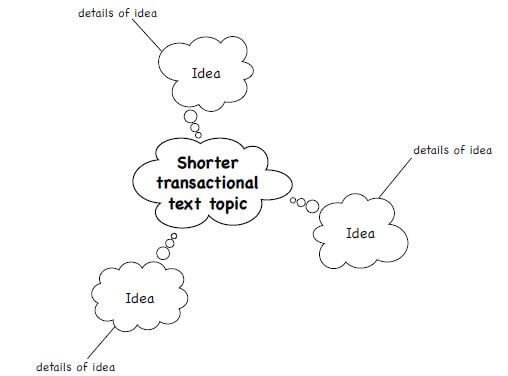
2. Idea lists
These help you to quickly write down ideas for each paragraph. Write down your ideas as they come to you and then organise them ideas in a logical order. Below is an example.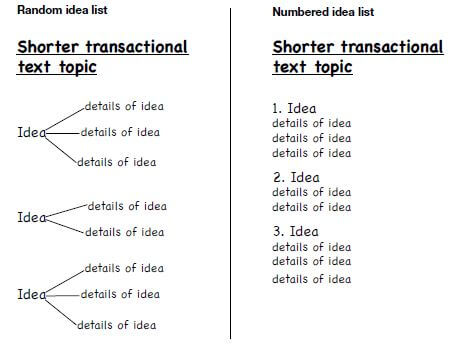
Step 3: Write and edit your draft text
Write a draft of your text, using the ideas from your plan.
Check that the format is right for the text type you have chosen.
Read through each sentence carefully to proofread it. Look for any spelling, punctuation or other language mistakes. Edit your draft by correcting these mistakes and making any other changes you think are needed. This will improve your final text.
Count the number of words in your text and make any changes to meet the word limit. For example, you may need to add some words or use fewer words.
Hint:
|
Step 4: Write your final text
Write your final text by rewriting your draft. Make sure that you make all the changes you marked in your draft so that your final text is error-free and clearly expresses all your best ideas. Check again that the text is in the correct format for the text type.
When you have finished your final text, cross out your planning and draft text. If you do not do this, the examiner may mark your draft and not your final text.
Hint:
|
Important differences between formal and informal writing
Formal writing | Informal writing |
|
|
|
|
|
|
|
|
|
2. Category A
Category A in the exam paper covers the following texts:
- Advertisement
- Invitation card
- Flyer
- Poster
2.1 Writing an advertisement
Advertisements aim to sell products or services. They are found in electronic media, such as on TV, radio and websites; in the cinema; and through sms’s to cellphones.
They are also found in print media. Printed adverts can take the form of flyers, posters and billboards; catalogues and advertising supplements; and adverts placed in newspapers and magazines.
Hint:
|
eg: A learner's example of an advertisement using the four steps
Step 1: Choose the text type
This learner chose this question on an advertisement:
Your family runs a home business making products such as toys, ethnic jewellery and clothing. Write out the advertisement to promote the sale of ONE of the products to tourists.
You should include the following in your advertisement: a brand name, a slogan, details of the product and where to find it.
Note: Do not include illustrations.
Step 2: Plan the text
Read the question carefully. Identify the key words to use in your planning.
In this topic, the key words are business, toys, tourists, brand name, slogan and details of product.
This learner used a mind map to plan his advertisement: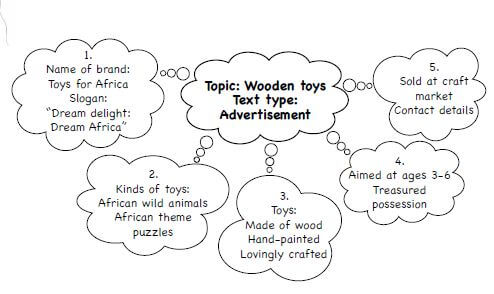

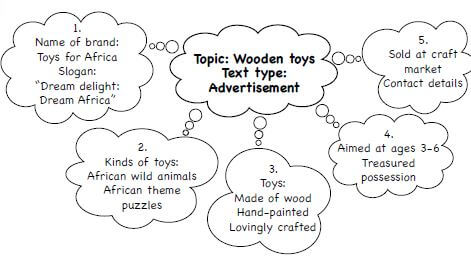
 Step 3: Write and edit the draft text
Step 3: Write and edit the draft text
Write a draft of the text using the ideas from the plan. Edit the draft by correcting any grammar, punctuation, spelling and format errors.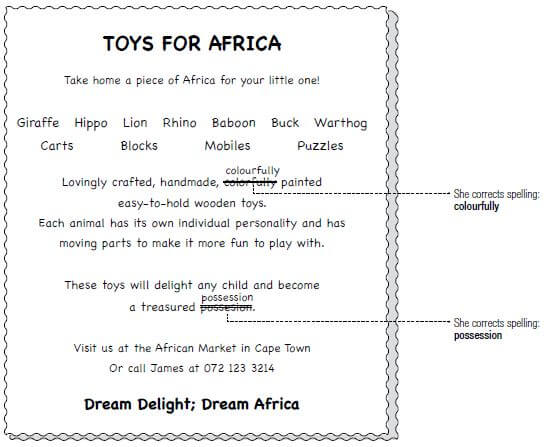
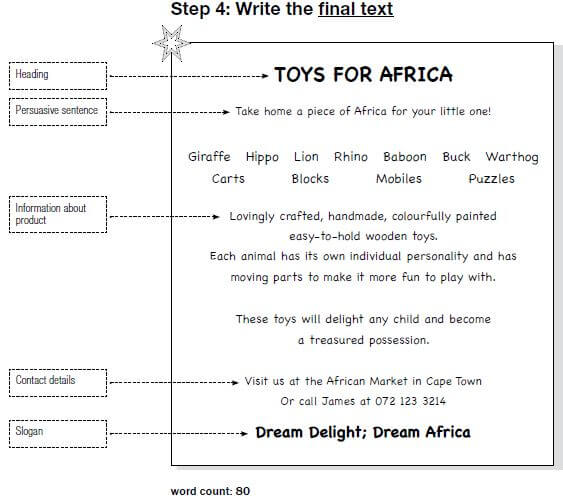
Activity: Writing an advertisement
Here are some topics to help you to practise writing advertisements:
- Your neighbour is a businessman who has developed a new hair care product. He wishes to advertise the product in a national magazine. He has asked you to write the advertisement.
Write this advertisement.
Note: Do not include illustrations. - You help your family run a small family business, but sales have recently decreased. Your father has asked you to write an advertisement that will promote the business.
2.2 Advertisement checklist
Features | Details of the feature | Yes | No | Don't know |
Text type | I understand the features of an advertisement. | |||
Topic | I understand the topic I have chosen. | |||
Content, planning and format | ||||
Planning | I can show evidence of planning. | |||
Content | Each point in plan is relevant to my topic. | |||
Purpose / Audience | I understand the purpose of an advertisement. | |||
Format | My layout is eye catching and makes the information easy to understand. | |||
Language, style and editing | ||||
Choice of words / diction | I have chosen my words carefully to make my text interesting. | |||
Language | I have checked and corrected my grammar, spelling and punctuation. | |||
2.3 Writing an invitation card
An invitation card is a written request inviting someone to attend a specific occasion.
Hint:
|
Eg: A learner’s example of an invitation card using the four steps
Step 1: Choose the text type and topic
This learner chose this question on an invitation card:
You have been asked to invite guests to your school’s prize-giving function. A former principal of the school will be the guest speaker.
Write out the invitation card you will send to the guests.
Note: Do not include illustrations or drawings.
Step 2: Plan the text
Read the question carefully. Identify the key words to use in your planning. In this topic, the key words are school’s prize-giving function, former principal, guest speaker and invitation card to guests.
This learner used a list to plan her invitation card.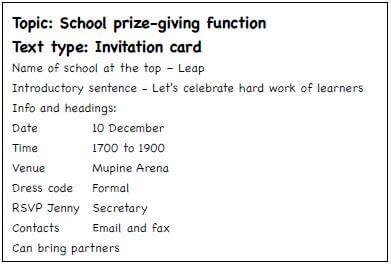
Step 3: Write and edit the draft text
Write a draft of the text using the ideas from the plan. Edit the draft by correcting any grammar, punctuation, spelling and format errors.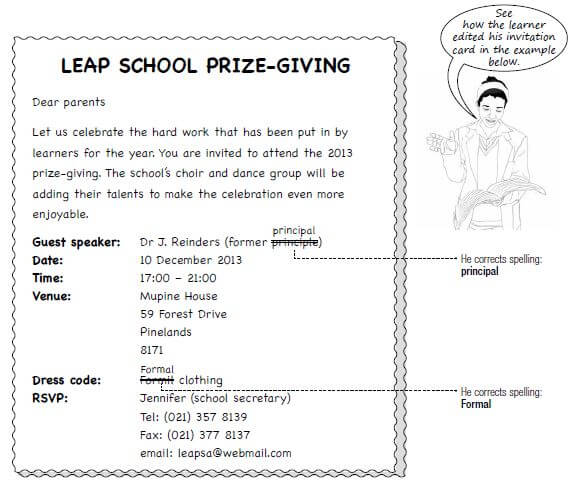

Activity: Writing an invitation card
Here are some topics to help you to practise writing invitation cards:
- The couple living next door to you has been married for 50 years. They are planning to celebrate this by hosting a formal function. You have been asked to prepare the formal invitation.
Write the invitation that will be sent to their families and friends.
Note: Do NOT include illustrations. - Your school’s Life Orientation teacher has invited a well-known personality to give a motivational talk to the learners at your school. As chairperson of your school’s Learners’ Representative Council, you wish to invite the chairpersons of the Learners’ Representative Councils of neighboring schools.
Write the invitation you will send to them.
2.4 Invitation card checklist
Features | Details of the feature | Yes | No | Don't know |
Text type | I understand the features of an invitation card. | |||
Topic | I understand the topic I have chosen. | |||
Content, planning and format | ||||
Planning | I can show evidence of planning. | |||
Content | Each point in plan is relevant to my topic. | |||
Purpose / Audience | I understand the purpose of an invitation card. | |||
Format | My invitation card has a clear heading and the details of the event are listed below using colons. | |||
Language, style and editing | ||||
Choice of words / diction | I have chosen my words carefully to make my text interesting. | |||
Language | I have checked and corrected my grammar, spelling and punctuation. | |||
2.5 Writing a flyer
A flyer is a cheap and simple form of advertising. It is usually a one-page leaflet that is handed out to people.
Hint:
|
eg: A learner’s example of a flyer using the four steps
Step 1: Choose the text type and topic
This learner chose this question on a flyer:
You employed a painter, Isaac Khumalo, to paint your house. His work was of a high standard. He now wishes to promote his business and has asked you to write a flyer.
Write out this flyer.
Note: Do not include illustrations or drawings.
Step 2: Plan the text
Read the question carefully. Identify the key words to use in your planning. In this topic, the key words are painter, high standard, promote and flyer.
The learner has used a mind map to plan her flyer.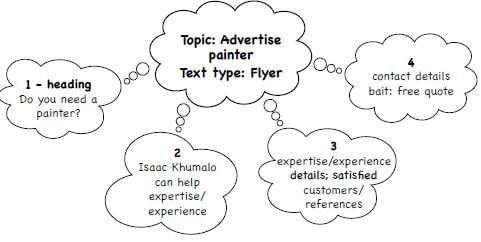
Step 3: Write and edit the draft text
Write a draft of the text using the ideas from the plan. Edit the draft by correcting any grammar, punctuation, spelling and format errors.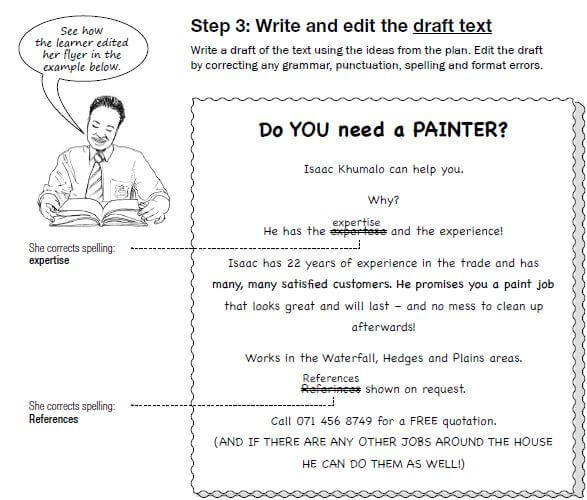
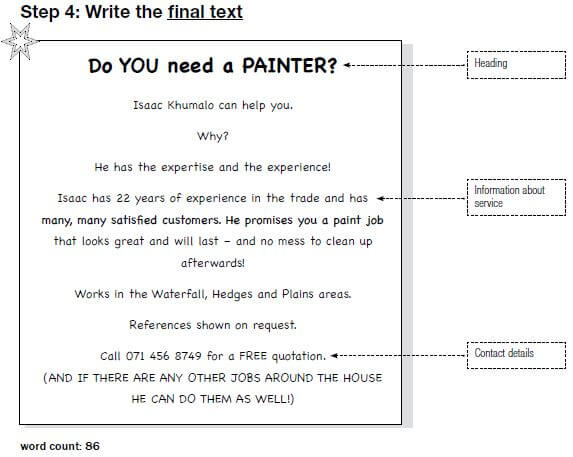
Activity: Writing a flyer
Here are some topics to help you to practise writing flyers:
- You live next door to the Public Relations Officer for your town/ city/suburb. He/she is organising a flea market to raise funds to beautify the town/city/suburb. Write this flyer.
- You are a Grade 12 learner who is excellent at Maths. You wish to earn some pocket money by offering extra lessons. Write a flyer in which you advertise your services.
- Your uncle has a small gardening service. However, he needs more customers and he has asked you for help. Write a flyer in which you promote his business.
2.6 Flyer checklist
Features | Details of the feature | Yes | No | Don't know |
Text type | I understand the features of a flyer. | |||
Topic | I understand the topic I have chosen. | |||
Content, planning and format | ||||
Planning | I can show evidence of planning. | |||
Content | Each point in plan is relevant to my topic. | |||
Purpose / Audience | I understand the purpose of a flyer. | |||
Format | My flyer has a clear heading. | |||
Language, style and editing | ||||
Choice of words / diction | I have chosen my words carefully to make my text interesting. | |||
Language | I have checked and corrected my grammar, spelling and punctuation. | |||
2.7 Writing a poster
A poster is a large printed notice in a public place. It is a simple form of advertising that uses bold lettering and an interesting layout to catch people’s attention.
Hint:
|
eg: A learner’s example of a poster using the four steps
Step 1: Choose the text type and topic
This learner chose this question on a poster:
Your friends have formed a band and have been offered the opportunity to play at a local restaurant.
Write the poster that promotes their appearance at this venue.
Note: No drawings or illustrations are required.
Step 2: Plan the text
Read the question carefully. Identify the key words to use in your planning. In this topic, the key words are band, local restaurant and poster.
The learner has used a mind map to plan his poster.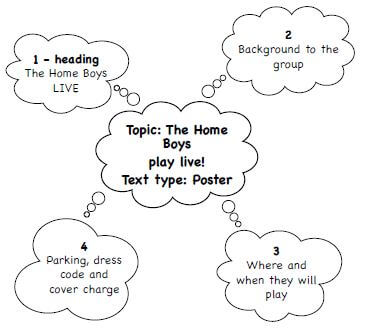
Step 3: Write and edit the draft text
Write a draft of the text using the ideas from the plan. Edit the draft by correcting any grammar, punctuation, spelling and format errors.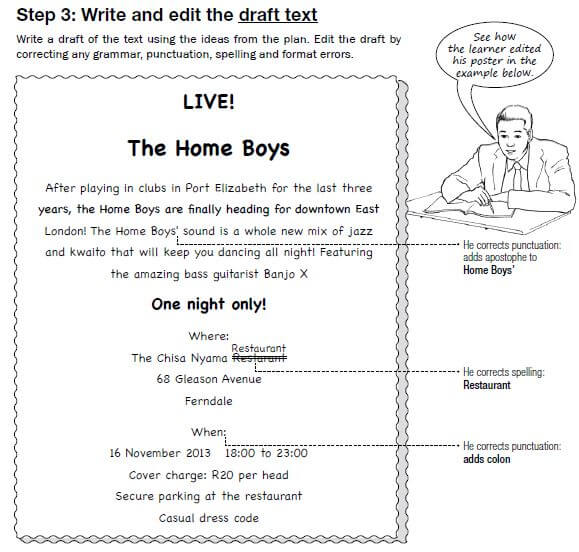
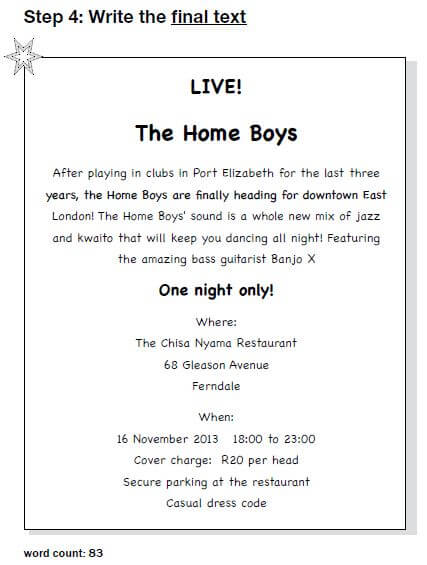
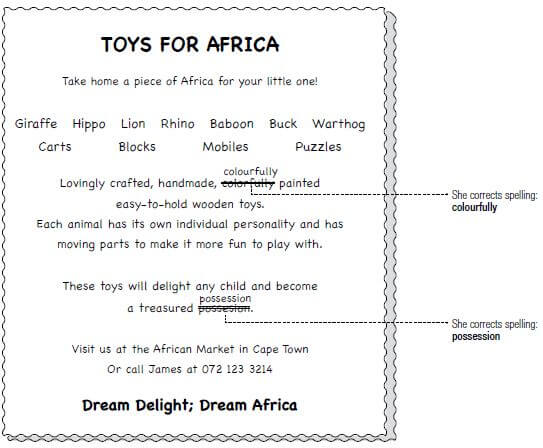
Activity: Writing a poster
Here are some topics to help you to practise writing posters:
- You live next door to the local councillor for your ward/suburb. He/she is organising a flea market to raise funds to beautify the suburb. Write out this poster.
Note: No illustrations are required. - Road deaths are a continual source of worry for traffic authorities. The campaign that they have come up with to make motorists obey the rules of the road and drive safely is called Arrive Alive.
Write out a poster for Arrive Alive.
Note: No illustrations are required.
2.8 Poster checklist
Features | Details of the feature | Yes | No | Don't know |
Text type | I understand the features of a poster. | |||
Topic | I understand the topic I have chosen. | |||
Content, planning and format | ||||
Planning | I can show evidence of planning. | |||
Content | Each point in plan is relevant to my topic. | |||
Purpose / Audience | I understand the purpose of a poster. | |||
Format | I have used a bold heading and laid out the information in a clear and eye-catching way. | |||
Language, style and editing | ||||
Choice of words / diction | I have chosen my words carefully to make my text interesting. | |||
Language | I have checked and corrected my grammar, spelling and punctuation. | |||
3. Category B
Category B in the exam paper covers the following texts:
- Diary entry
- Postcard
3.1 Writing a diary entry
A diary entry is a personal account of events, thoughts and feelings that the writer has experienced.
Hint:
|
Eg: A learner’s example of a diary entry using the four steps
Step 1: Choose the text type and topic
This learner chose this question on a diary entry:
You are in Grade 12 and you have been experiencing mixed feelings about the final examinations.
Write down your diary entries for the following TWO days:
- The day before the examination starts
- The last day of the examination
Step 2: Plan the text
Read the question carefully. Identify the key words to use in your planning. In this topic, the key words are mixed feelings, final examinations, day before, last day of the examination and diary entries.
The learner has used a mind map to plan her diary entries.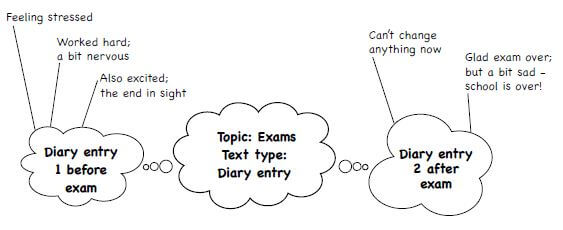
Step 3: Write and edit the draft text
Write a draft of the text using the ideas from the plan. Edit the draft by correcting any grammar, punctuation, spelling and format errors.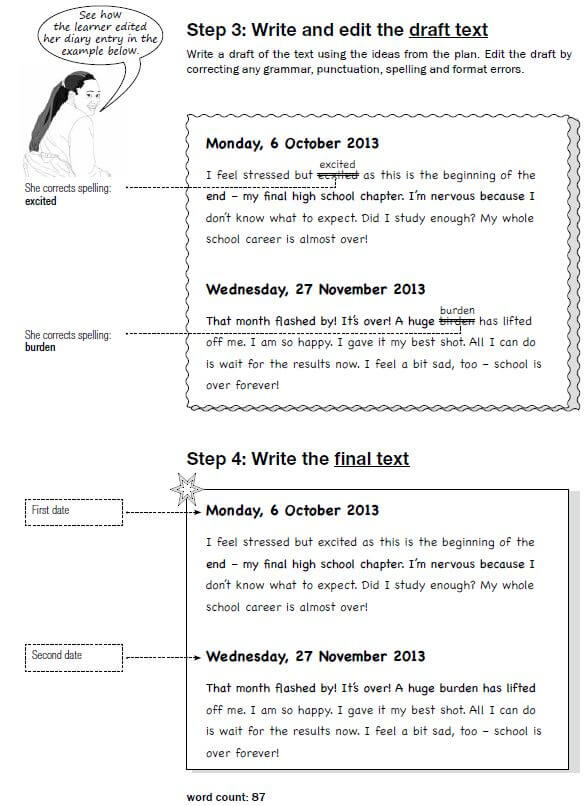
Activity: Writing a diary entry
Here are some topics to help you to practise writing diary entries:
- You have gone through a difficult period recently. You recorded your experience in a diary.
Write your diary for two of the difficult days. - Imagine that you played very well in a sports match for the school. Write a dairy entry that describes your feelings.
- You and your best friend have had an argument. Write the diary entry for two consecutive days.
3.2 Diary entry checklist
Features | Details of the feature | Yes | No | Don't know |
Text type | I understand the features of a diary entry. | |||
Topic | I understand the topic I have chosen. | |||
Content, planning and format | ||||
Planning | I can show evidence of planning. | |||
Content | Each point in plan is relevant to my topic. | |||
Purpose / Audience | I understand the purpose of a diary entry. | |||
Format | I have put a date above each diary entry. | |||
Language, style and editing | ||||
Choice of words / diction | I have chosen my words carefully to make my text interesting. | |||
Language | I have checked and corrected my grammar, spelling and punctuation. | |||
3.3 Writing a postcard
A postcard is a short message sent by post that briefly tells someone your news and lets them know you are thinking of them.
Hint:
|
Eg: A learner’s example of a postcard using the four steps
Step 1: Choose the text type and topic
This learner chose this question on a postcard:
You are far away from home at a beautiful holiday resort.
Write the text (words) of a postcard that you would send to a family member describing your experiences.
Note: Do not include illustrations.
Step 2: Plan the text
Read the question carefully. Identify the key words to use in your planning. In this topic, the key words are postcard, far away from home, beautiful holiday resort, family member and your experiences.
The learner has used a mind map to plan his postcard.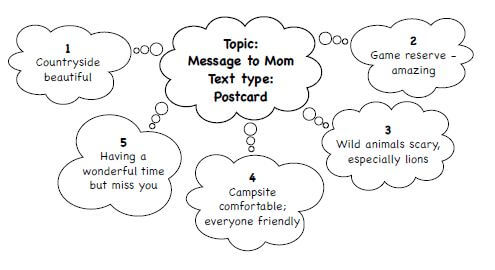
Step 3: Write and edit the draft text
Write a draft of the text using the ideas from the plan. Edit the draft by correcting any grammar, punctuation, spelling and format errors.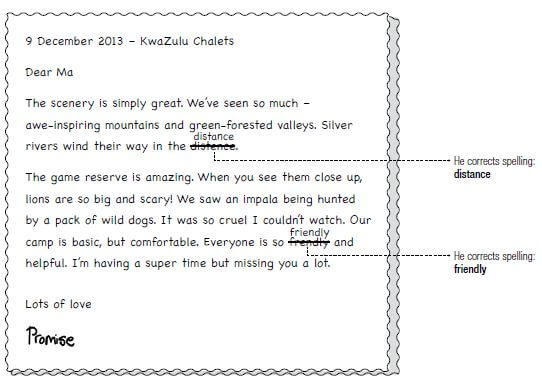
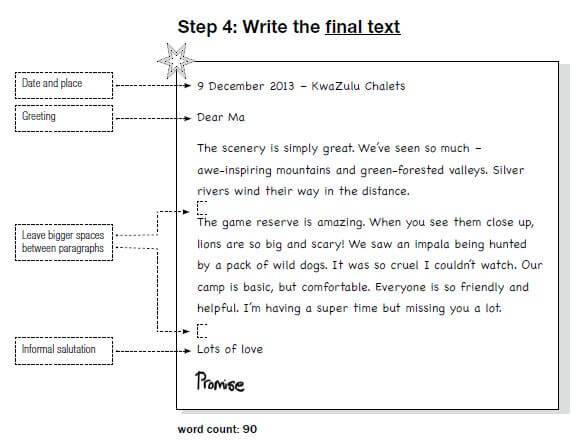
Activity: Writing a postcard
Here are some topics to help you to practise writing postcards:
- You are on holiday with school friends after completing Grade 12.
Write a postcard to your family indicating that all is well and that they need not worry about your fellow matriculants misbehaving. - You are on holiday in a resort in South Africa. At the last moment you decide to stay on longer and then travel elsewhere. Your family, however, is expecting your return.
Write a postcard to your family explaining your decision. - You have been sponsored to stay on a farm and learn another language.
Write a postcard to your sponsor telling him or her of your progress and your experiences.
3.4 Postcard checklist
Features | Details of the feature | Yes | No | Don't know |
Text type | I understand the features of a postcard. | |||
Topic | I understand the topic I have chosen. | |||
Content, planning and format | ||||
Planning | I can show evidence of planning. | |||
Content | Each point in plan is relevant to my topic. | |||
Purpose / Audience | I understand the purpose of a postcard. | |||
Format | The date and place are at the top of the postcard | |||
Language, style and editing | ||||
Choice of words / diction | I have chosen my words carefully to make my text interesting. | |||
Language | I have checked and corrected my grammar, spelling and punctuation. | |||
4. Category C
Category C in the exam paper covers the following texts:
- Instructions
- Directions
4.1 Writing instructions
The purpose of instructions is to explain how something is done.
Hint:
|
eg: A learner’s example of instructions using the four steps
Step 1: Choose the text type and topic
This learner chose this question on instructions.
You have been asked by your sports coach to help if a mouth-to-mouth emergency situation occurs on the sports field. He has asked you to write a set of instructions on mouth-to-mouth artificial respiration.
These instructions will be distributed to all athletes. Write out this set of instructions.
Step 2: Plan the text
Read the question carefully. Identify the key words to use in your planning. In this topic, the key words are emergency situation; mouth-to-mouth artificial respiration; athletes; and set of instructions.
The learner has used a list to plan her instructions.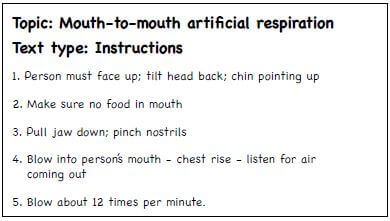
Step 3: Write and edit the draft text
Write a draft of the text using the ideas from the plan. Edit the draft by correcting any grammar, punctuation, spelling and format errors.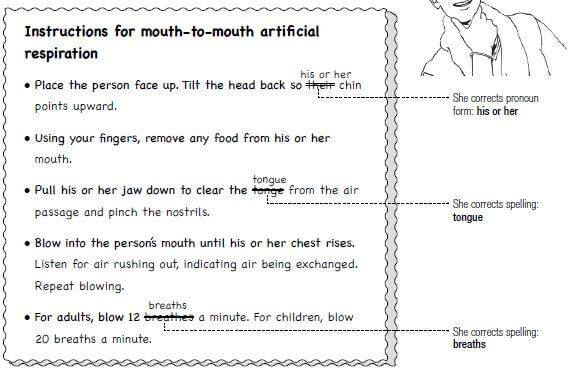
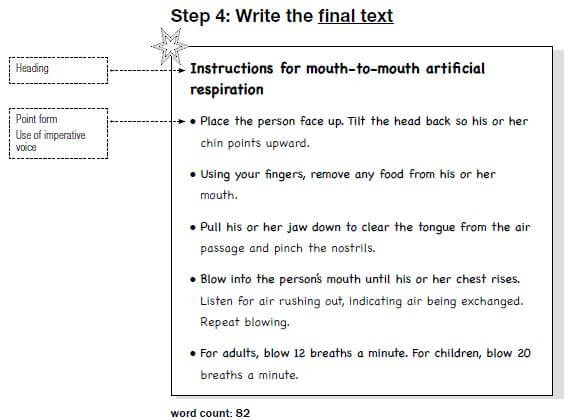
Activity: Writing instructions
Here are some topics to help you to practise writing instructions:
- You have been asked to do a short oral presentation for a Life Orientation lesson on how to lead a healthy, balanced life. Write down a list of 6–7 tips you would give your classmates in your presentation.
- Your younger brother has asked you to help him cover his school exercise books. Write out a set of instructions that will enable him to carry out this task.
- Your school wishes to start a recycling programme. Your principal has asked you, as a member of the Learners’ Representative Council, for assistance. Write out a set of instructions that will be posted on the wall of every classroom.
4.2 Instructions checklist
Features | Details of the feature | Yes | No | Don't know |
Text type | I understand the features of instructions. | |||
Topic | I understand the topic I have chosen. | |||
Content, planning and format | ||||
Planning | I can show evidence of planning. | |||
Content | Each point in plan is relevant to my topic. | |||
Purpose / Audience | I understand the purpose of instructions. | |||
Format | I have given my instructions a heading. | |||
Language, style and editing | ||||
Choice of words / diction | I have chosen my words carefully to make my text interesting. | |||
Language | I have checked and corrected my grammar, spelling and punctuation. | |||
4.3 Writing directions
Directions explain to someone how to get to a certain place.
Hint:
|
eg: A learner’s example of directions using the four steps
Step 1: Choose the text type and topic
This learner chose this question on directions:
You and your friends have decided to meet at your house to celebrate the end of the examinations. Write out the directions you will give your friends to travel from the school to your house.
Note: In your response, you must include some distances, turns and landmarks. Do not include sketches or maps.
- If you live in an urban area, include landmarks like a fast-food outlet, an intersection or a park.
- If you live in a rural area, include landmarks like a bridge, a river, or a road sign.
Step 2: Plan the text
Read the question carefully. Identify the key words to use in your planning. In this topic, the key words are your friends, directions, from the school to your house, distances, turns and landmarks.
The learner has used a list to plan his directions.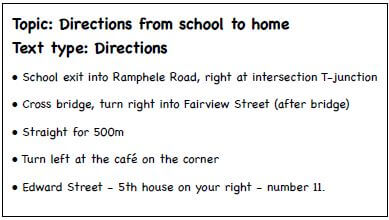
Step 3: Write and edit the draft text
Write a draft of the text using the ideas from the plan. Edit the draft by correcting any grammar, punctuation, spelling and format errors.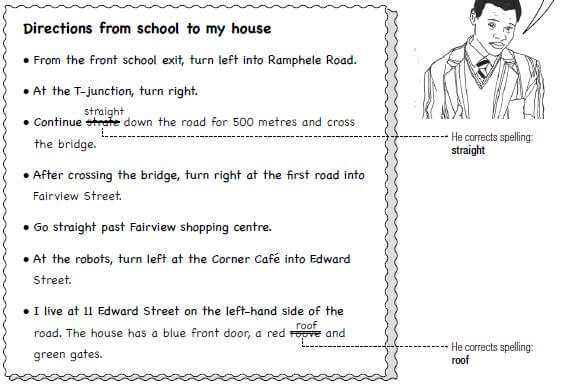
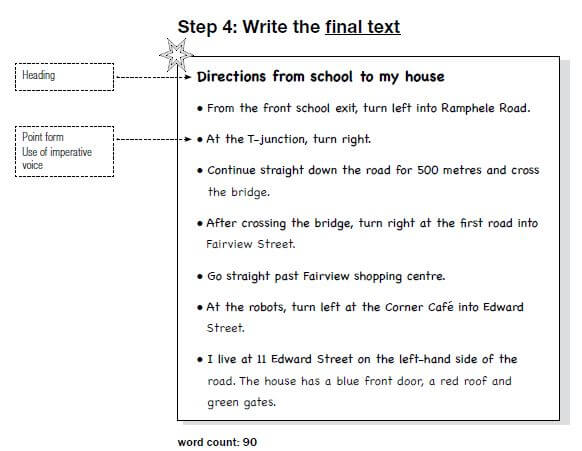
Activity: Writing directions
Here are some directions topics to help you to practise your writing skills:
- A friend from another province will be in your town and would like to visit you at your home.
Write the directions from a nearby bus stop to your house. You must include at least three turns and two landmarks (e.g. a school, a shop, a sports field) in your response.
Note: do not include illustrations or drawings. - Study the map on page 159. You are shopping at Lucky’s Supermarket (point X on the map) when a customer asks you for directions to the post office (point Y on the map).
Write out the directions you will give to the customer. In your response you must refer to the streets and landmarks on the route you choose.
4.4 Directions checklist
Features | Details of the feature | Yes | No | Don't know |
Text type | I understand the features of directions. | |||
Topic | I understand the topic I have chosen. | |||
Content, planning and format | ||||
Planning | I can show evidence of planning. | |||
Content | Each point in plan is relevant to my topic. | |||
Purpose / Audience | I understand the purpose of directions. | |||
Format | I have given my directions a heading. | |||
Language, style and editing | ||||
Choice of words / diction | I have chosen my words carefully to make my text interesting. | |||
Language | I have checked and corrected my grammar, spelling and punctuation. | |||
What is expected from you in the exam?
In the exam, you must write one shorter transactional text that is no less than 80 words long and no more than 100 words long.
The shorter transactional text question is worth 20 marks out of 100 marks in the exam. Examiners will give marks for your shorter transactional text based on:
- Content, planning and format (12 marks)
- Language, style and editing (8 marks)
The exam is 2 1/2 hours long and you should spend about 30 minutes on the shorter transactional text question.
The rubric on the next page is a table the examiners use to mark your shorter transactional text. It shows the five levels of achievement that the examiners can award a shorter transactional text, from the lowest achievement (Inadequate column) to the highest achievement (Exceptional column).
The table also describes the skills the examiner looks for when marking. For example, when marking the text, the examiner will assess how well the ideas relate to the topic, whether they are well planned, and that the format used is correct for the text type.
The rubric is a useful guide for you to use when practicing your shorter transactional text writing because it reminds you of the skills the examiner will be assessing when marking your work.
ASESSMENT RUBRIC FOR SHORTER TRANSACTIONAL TEXT – FIRST ADDITIONAL LANGUAGE [20 MARKS]
| Criteria | Exceptional | Skilful | Moderate | Elementary | Inadequate |
| CONTENT, PLANNING & FORMAT Response and ideas; Organisation of ideas for planning; Purpose, audience, features/conventions and context 12MARKS | 10-12 | 8-9 | 6-7 | 4-5 | 0-3 |
|
|
|
|
| |
| LANGUAGE, STYLE & EDITING Tone, register, style, purpose/effect, audience and context; Language use and conventions; Word choice; Punctuation and spelling 8 MARKS | 7-8 | 5-6 | 4 | 3 | 0–2 |
|
|
|
|
| |
| MARK RANGE | 17-20 | 13-15 | 10-11 | 7-8 | 0-5 |
LONGER TRANSACTIONAL TEXTS GRADE 12 NOTES - LITERATURE STUDY GUIDE
- Steps to writing longer transactional texts in the exams
- Category A
- Formal letter
- Informal or friendly letter
- Formal and informal letter to the press
- Category B
- Curriculum vitae (CV) and covering letter
- Obituary
- Category C
- Review
- Newspaper article
- Magazine article
- Agenda and minutes of a meeting
- Formal and informal report
- Category D
- Dialogue
- Written interview
- Written formal and informal speech
- What is expected from you in the exam?
Section B: Longer transactional texts
A transactional text is a written exchange of information, or a written record of communication between people. This type of writing has a specific purpose and format, such as conducting business, or sharing news.
In this section, you will learn the features of each type of longer transactional text that will earn you marks in the final Grade 12 exam.
There are four categories of longer transactional text.
1. Steps for writing longer transactional texts
There are four main steps for writing a longer transactional text in an exam:
Step 1: Choose your text type
Step 2: Plan your topic
Step 3: Write a draft of your text and edit it
Step 4: Write your final text
Step 1: Choose your text type and topic
There are four categories of longer transactional texts. The exam has one question for each of these four categories. You only have to answer ONE of the questions. Choose the text type format you know best.
Longer transactional texts | |
Category A |
|
Category B | 4. CV and covering letter |
Category C | 6. Review |
Category D | 11. Dialogue |
Hint:
|
Step 2: Plan your topic
Remind yourself of the correct format for the text type you have chosen.
Plan your text by writing down your ideas for the content. Remember that your ideas must be relevant to the topic, and the text type you have chosen.
There are many different ways to plan your text. For example, you could use a mind map. Use the planning method that works best for you. There are examples of planning tools on page 46.
Once you have written down a few ideas, you can organise them by numbering them in a logical order. This is the order in which you will structure your ideas in paragraphs in your text.
Logical order - Arranging information so that the points follow each other in an order that makes sense.
Hint:
|
Ways to plan a longer transactional text
A plan helps you think about what ideas you want to include in your text. It also helps you put your ideas into a clear structure. You will earn marks for showing your planning.
You can use a mind map or an ideas list to plan your text.
1. Mind maps
These are diagrams of ideas. The title is in the centre with branches coming from it showing thoughts and ideas. Below is an example of a mind map.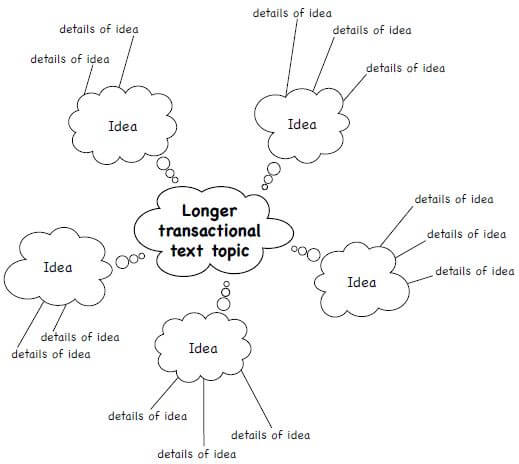 2. Idea lists
2. Idea lists
These help you to quickly write down ideas for each paragraph. Your idea list can be a random or a numbered list. Below are examples of these two different idea lists.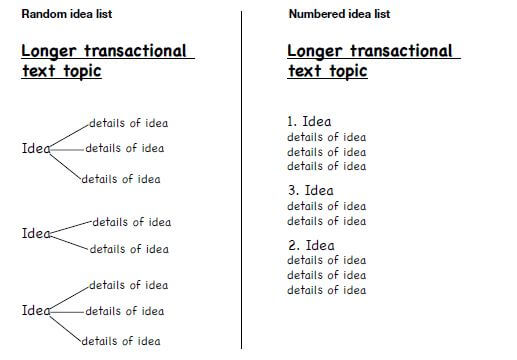 Step 3: Write and edit your draft text
Step 3: Write and edit your draft text
Write a draft of your text, using the ideas from your plan.
Check that the format is right for the text type you have chosen.
Read through each sentence carefully to proofread it. Look for any spelling, punctuation or other language mistakes. Edit your draft by correcting these mistakes and making any other changes you think are needed. This will improve your final text.
Count the number of words in your text and make any changes to meet the word limit. For example, you may need to add some words or use fewer words.
Note - The content of a longer transaction text is between 120-150 words long. In a letter do not add the address and greetings as part of the word count.
Hint:
|
Step 4: Write your final text
Write your final text by rewriting your draft. Make sure that you make all the changes you marked in your draft so that your final text has no mistakes and clearly expresses all your best ideas. Check again that the text is in the correct format for the text type.
When you have finished your final text, cross out your planning and draft text. If you do not do this, the examiner may mark your draft and not your final text.
Hint:
|
Important differences between formal and informal writing
Formal writing | Informal writing |
|
|
|
|
|
|
|
|
|
|
2. Category A
Category A in the exam paper covers the following:
- Formal letter
- Informal or friendly letter
- Formal and informal letter to the press
Each one of these letters has a different format, serves a different purpose and has a different register. For example, the register of a letter to a place of business is formal, while the register of a letter to a friend is informal.
2.1 Writing a formal letter
A formal letter is a communication used in official or important situations, or with people you do not know well.
Hint;
|
eg: A learner’s example of a formal letter using the four steps
Step 1: Choose the text type and topic
This learner chose this question on a formal letter:
An international company is offering a limited number of bursaries to Grade 12 learners for further studies.
Write a letter to the Manager: Human Resources of this company, applying for one of these bursaries. Mention the career you want to study towards and state clearly why you deserve this bursary.
Step 2: Plan the text
Read through the question carefully and look for the key words that would help you think about the contents of your letter. Note these key words in the question above: bursaries, career and deserve this bursary.
The learner used a mind map to plan her formal letter.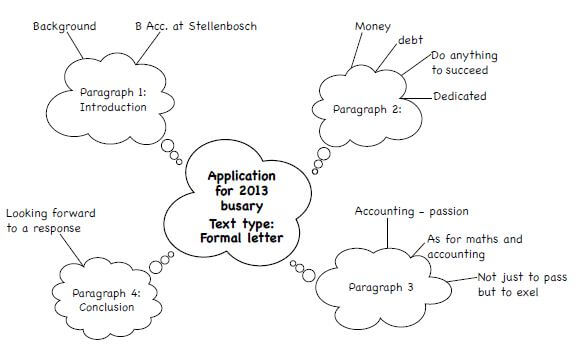
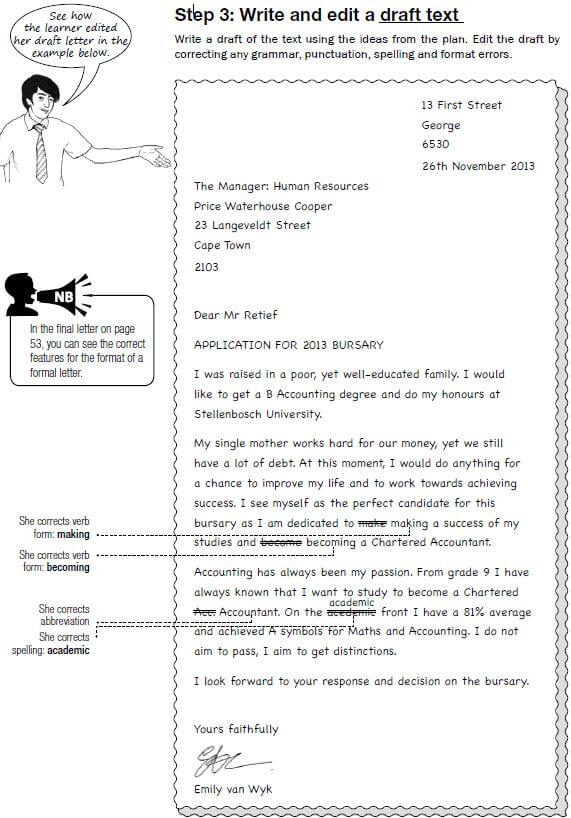
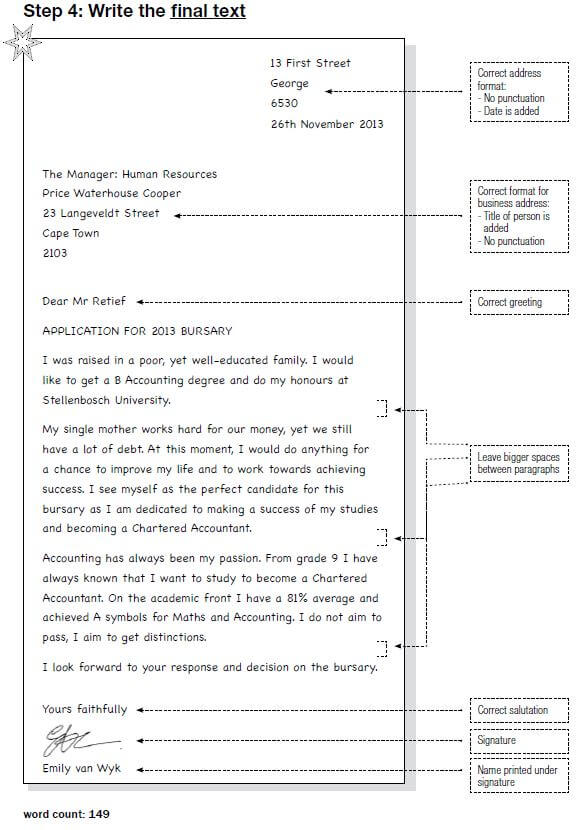
Activity: Writing a formal letter
Here are some formal letter topics to help you to practise your writing skills:
- Recently your youth club/religious organisation hosted a successful sports day for your community. A local company sponsored prizes for the event.
You are the chairperson of the organising committee of this event. Write a letter to the manager of the company, telling him/ her about the success of the event and thanking him/her for the sponsorship.
Note - in question 1 there are two things you must do in your letter: Talk about the success of the event and thank the chairperson for sponsoring the event. - Recently you needed a certain item which you were unable to obtain from stores in your area. However, a shop assistant at a certain store helped you to obtain the item.
Write a letter to the manager of that store, giving details about
how the shop assistant helped you and expressing your gratitude.
2.2 Writing an informal letter
An informal letter also called a friendly letter is usually written to friends or family members.
Hint:
|
eg: A learner’s example of an informal letter using the four steps
Step 1: Choose the text type and topic
This learner chose this question on an informal or friendly letter:
Your friend has experienced a major disappointment. At the moment he/she is very depressed.
Write a letter to encourage and support your friend.
Step 2: Plan the text
Read the question carefully and find the key words in the question to help
you think of the contents of the letter.
Note the words disappointment and depressed and encourage and support in the question above. The learner used these key words in the mind map to plan his friendly letter.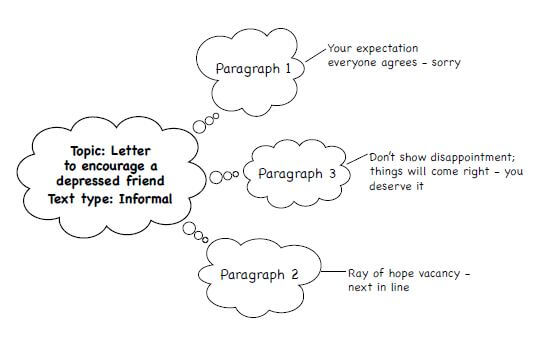
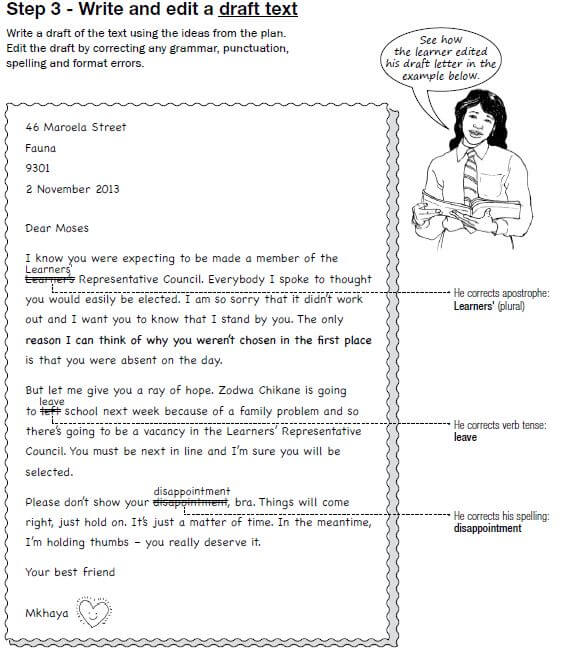
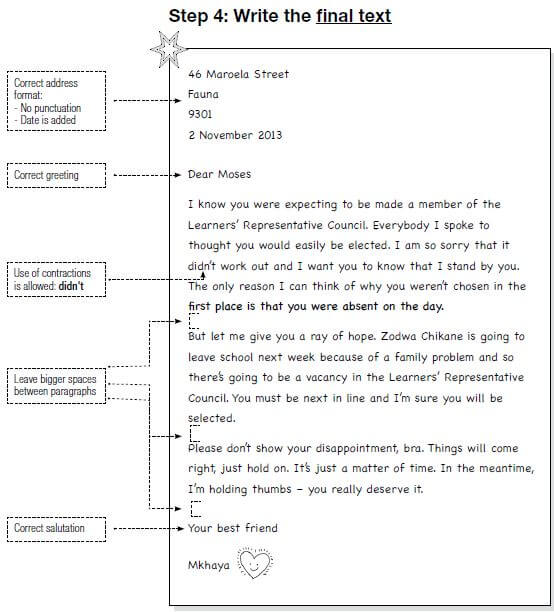
Word count: 146
Activity: Writing an informal letter
Here are some informal letter topics to help you to practise your writing skills:
- Your best friend has been selected to represent the province in a certain code of sport.
Write a letter to congratulate him/her on this achievement and to wish him/her well. - You have won two tickets to a soccer/rugby/cricket match in another province.
Write a letter inviting a friend to accompany you. Include details such as travel and accommodation arrangements.
2.3 Writing a letter to the press
A letter to the press (such as newspapers) is a formal letter with its own features and format rules.
Hint:
|
eg: A learner’s example of a letter to the press using the four steps
Step 1: Choose the text type and topic
The learner chose to write this letter to the press in the exam:
Respond to a letter in your local newspaper. In this letter a reader argues that the death penalty should be re-introduced.
Take a position in which you either support or reject the reader’s views.
Step 2: Plan the text
Find the key words in the question to help you think of the contents of the letter. The key words in this question are death penalty and support or reject.
The learner has used a list to plan her letter.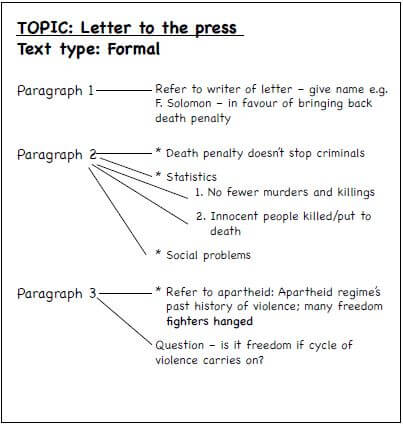
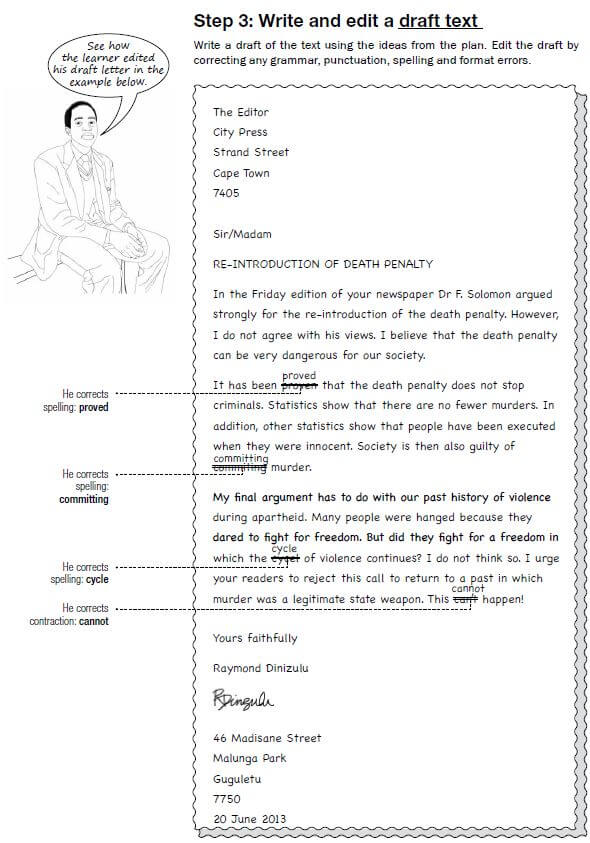
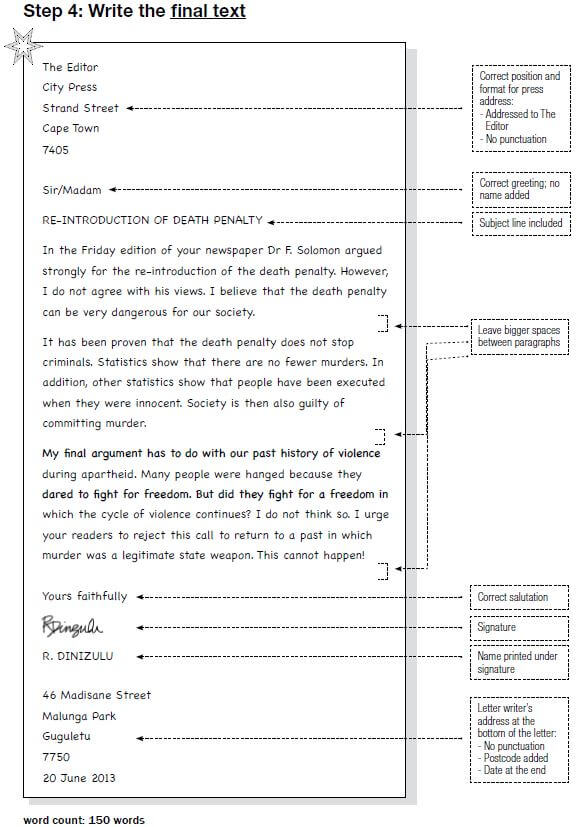
Activity: Writing a letter to the press
Here are some letter to the press topics to help you to practise your writing skills:
- Write a letter to the press in which you support or disagree with raising the age at which a person can obtain a driver’s licence from 18 to 21.
- Write a letter to the press in which you take a stand on the issue of violence against women. Propose a way of dealing with people who abuse women.
2.4. Category A checklist
Features | Details of the feature | Yes | No | Don't know |
Exam instructions | I understand the exam instruction for writing a letter | |||
Letter topic | I understand the letter topic I have chosen. | |||
Letter type | I understand the features of the letter type I have chosen:
| |||
Content, planning and format | ||||
Planning | I can show evidence of planning my letter. | |||
Content | Each point in my plan is relevant to the letter topic. | |||
Purpose/audience | I understand the purpose of the letter type I have chosen | |||
Letter structure | The first paragraph of my letter introduces the topic. The paragraphs in the body of my letter relate to the topic. The last paragraph concludes the ideas in my letter. | |||
Sentences | I have not repeated sentences in my paragraphs. | |||
Paragraphs | My ideas link and are well-organised in paragraphs. | |||
Format | I have used the correct format for the type of letter I have chosen:
| |||
Language, style and editing | ||||
Choice of words/diction | I have chosen my words carefully to make my letter interesting. My letter has the correct register (formal or informal) for the type of letter i have written. | |||
Verb tenses | I have used tenses correctly (past, present or future). | |||
Concord | My nouns and verbs are in agreement. | |||
Spelling | My spelling is correct. | |||
Punctuation | My sentences start with a capital letter and end with a punctuation mark. | |||
3. Category B
Category B in the exam covers the following:
- Curriculum vitae (CV) and covering letter
- Obituary
Each of these texts has a different format, serves a different purpose and has a different register.
3.1 Writing a CV
A CV is the document you send to businesses when you are applying for a job. It briefly shows the potential employer important information about you, and why you are suitable for the job. This information includes details about your education, qualifications, and previous work experience.
A covering letter is a letter which you send with your CV when applying for a job. A well-written covering letter will improve your chances of being given the job.
Hint:
|
eg: A learner’s example of a CV using the four steps
Step 1: Choose the text type and topic
This learner chose this question on a CV:
You are applying for a job at a supermarket. Write the CV that you will submit. It is not necessary to write a covering letter.
Step 2: Plan the text
Look for the key words in the question that would help you with the content. In the question above, the key words are apply for a job and supermarket. The learner used a mind map to plan his CV.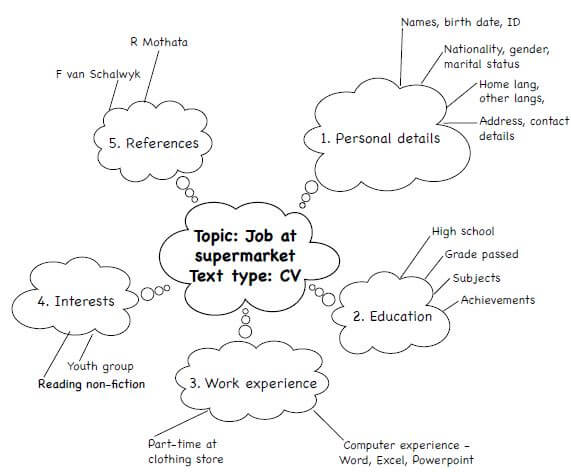
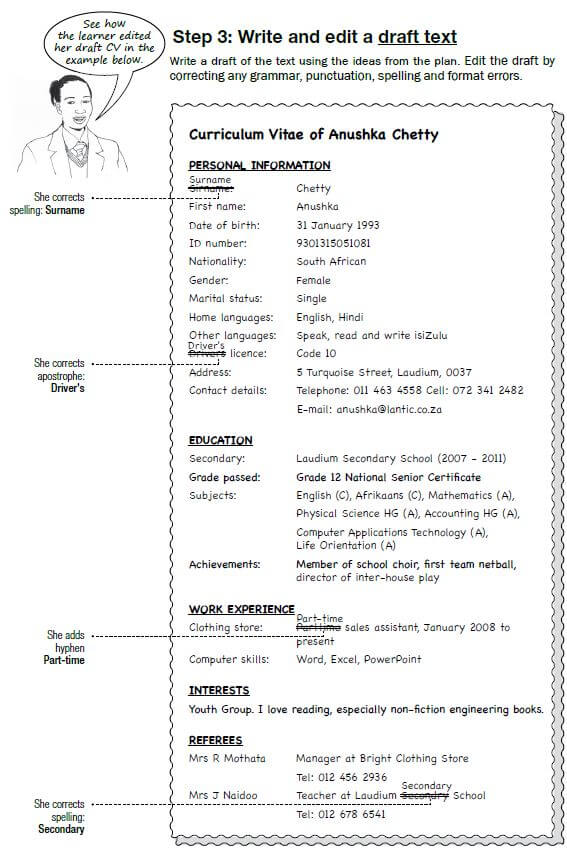
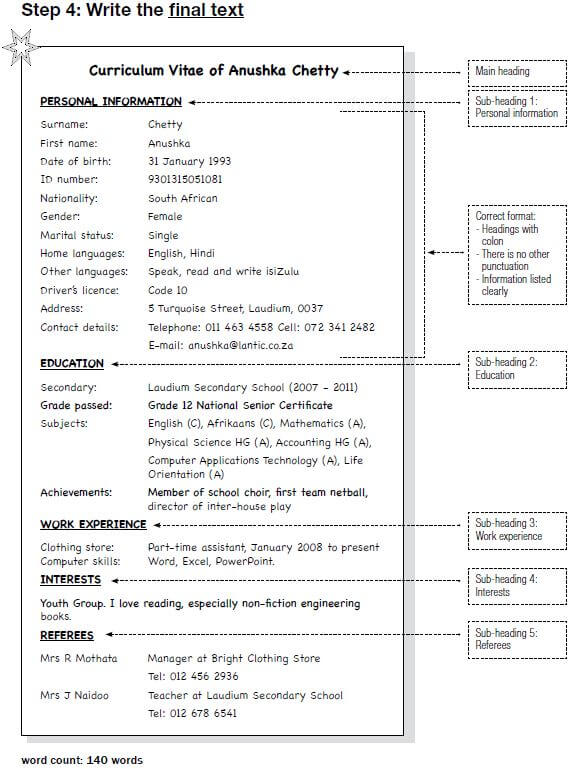
Activity: Writing a CV
Here are some CV topics to help you to practise for the exam:
- You are in your final year of Grade 12. You intend applying for part-time work. Write the CV that will accompany your application.
- You have recently completed a Bachelor of Arts degree in journalism. You have applied for a job at a local newspaper as a journalist. Write the CV that will accompany your application.
3.2 CV checklist
Features | Details of the feature | Yes | No | Don't know |
Text type | I understand the features of a CV and covering letter. | |||
Topic | I understand the topic I have chosen. | |||
Content, planning and format | ||||
Planning | I can show evidence of planning. | |||
Content | Each point in plan is relevant to my topic. | |||
Purpose / Audience | I understand the purpose of a CV and covering letter. | |||
Format | My CV is correctly laid out:
My covering letter uses the correct formal letter features. | |||
Language, style and editing | ||||
Choice of words / diction | I have chosen my words carefully to make my CV and covering letter informative and clear. | |||
Language | I have checked and corrected my grammar, spelling and punctuation. | |||
3.3 Writing an obituary
An obituary is a text about a person who has recently died. It may be published as an article in a newspaper, or read aloud at a funeral.
Hint:
|
eg: A learner’s example of an obituary using the four steps
Step 1: Choose the text type and topic
This learner chose this question on an obituary:
A well-known person in your community has passed away. This person was actively involved in charity work.
Write a suitable obituary, paying tribute to the person.
Step 2: Plan the text
Read the question carefully and note the key words that would help you brainstorm the content of your answer. In the question above, the key words are well-known in your community and charity work.
This learner has used a mind map to plan her essay.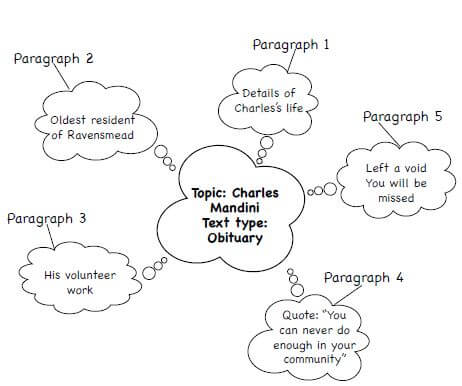
Step 3: Write and edit a draft text
Write a draft of the text using the ideas from the plan.
Edit the draft by correcting any grammar, punctuation, spelling and format errors.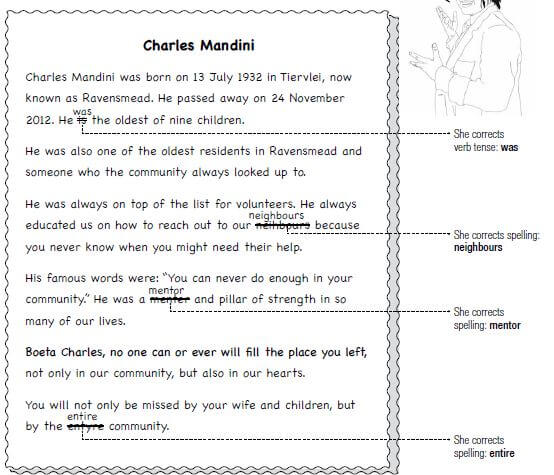
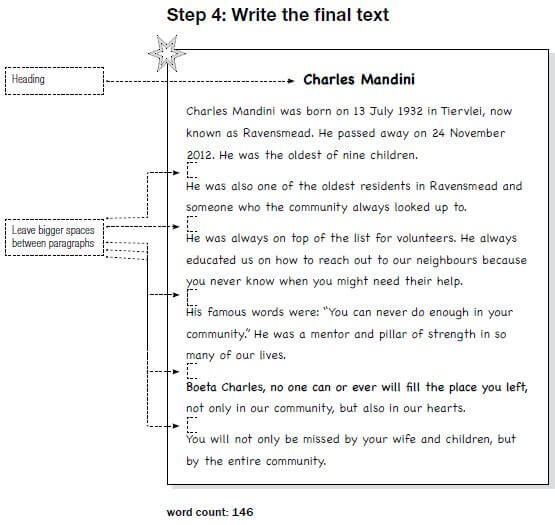
Activity: Writing an obituary
Here are some topics to help to practise writing obituaries:
- A well-known member of your church has died. He/she was responsible for looking after the youth, and frequently helped boys and girls who were in trouble. Write the obituary for this person.
- A respected and favourite teacher has died. The principal has approached you as a member of the Learners’ Representative Council to write an obituary. Write the obituary for this teacher.
3.4. Obituary checklist
Features | Details of the feature | Yes | No | Don't know |
Text type | I understand the features of an obituary. | |||
Topic | I understand the topic I have chosen. | |||
Content, planning and format | ||||
Planning | I can show evidence of planning. | |||
Content | Each point in plan is relevant to my topic. | |||
Purpose / Audience | I understand the purpose of an obituary. | |||
Format | My obituary. is correctly laid out:
| |||
Language, style and editing | ||||
Choice of words / diction | I have chosen my words carefully to make my obituary interesting. | |||
Language | I have checked and corrected my grammar, spelling and punctuation. | |||
4. Category C
Category C in the exam covers the following texts:
- Review
- Newspaper article
- Magazine article
- Agenda and minutes of a meeting
- Formal report
Each one of these texts has a different format, serves a different purpose and has a different register.
4.1 Writing a review
A review is a written assessment or account of something. Reviews may be assessments of an artwork; a movie; a book; a restaurant; a performance (a play or a concert); a CD or DVD; or a place.
Hint:
|
eg: A learner’s example of a review using the four steps
Step 1: Choose the text type and topic
This learner chose this question on a review:
Write a review of one of your literature setworks.
Step 2: Plan the text
The learner decided to write a review of Nothing But the Truth, and used a mind map to plan his review.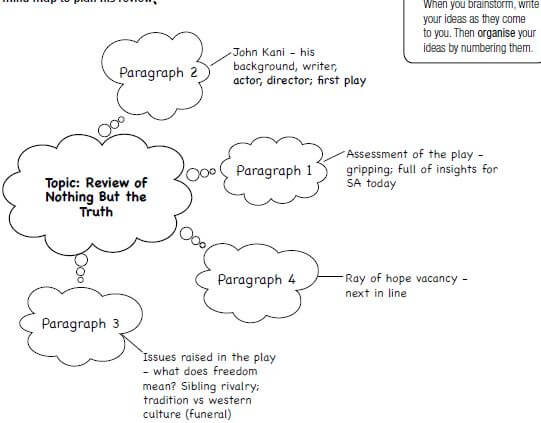
Step 3: Write and edit a draft text
Write a draft of the text using the ideas from the plan. Edit the draft by correcting any grammar, punctuation, spelling and format errors.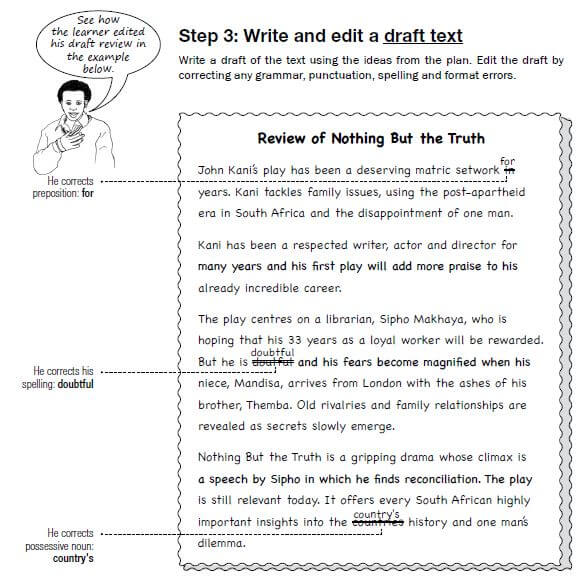
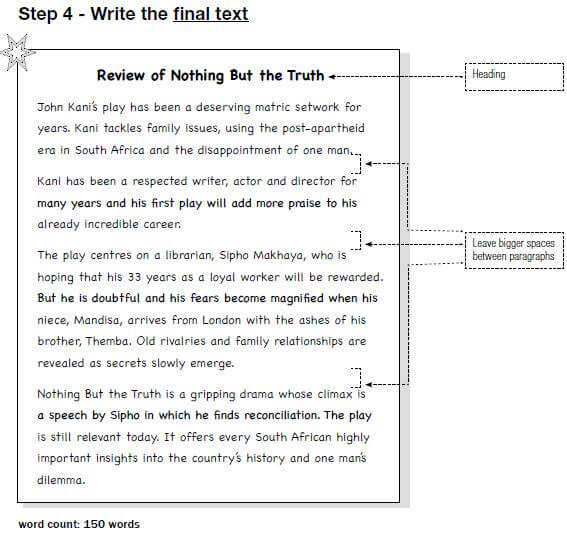
Activity: Writing a review
Here are some topics to help you to practise writing reviews:
- Your high school puts on a play every year. You are a member of the school’s annual magazine committee and have been asked to write a review of this production. Write this review.
- Your family often visits a nearby restaurant. A local newspaper is holding a competition for its readers in which they are asked to submit a review. You decide to submit a review of this restaurant.
- Write a review of your favourite movie / TV series / radio programme.
4.2 Review checklist
Features | Details of the feature | Yes | No | Don't know |
Text type | I understand the features of a review | |||
Topic | I understand the topic I have chosen. | |||
Content, planning and format | ||||
Planning | I can show evidence of planning. | |||
Content | Each point in plan is relevant to my topic. | |||
Purpose / Audience | I understand the purpose of a review. | |||
Format | My review is correctly laid out:
| |||
Language, style and editing | ||||
Choice of words / diction | I have chosen my words carefully to make my review interesting. | |||
Language | I have checked and corrected my grammar, spelling and punctuation. | |||
4.3 Writing a newspaper article
A newspaper article is a piece of writing in a newspaper about a particular subject. Its purpose is to inform or entertain the public.
Hint:
|
eg: A learner’s example of a newspaper article using the four steps
Step 1: Choose the text type and topic
This learner chose this question on a newspaper article:
There has been an increase in various types of crime in your area.
Write an article for publication in your local newspaper suggesting ways to avoid becoming a victim of crime.
Step 2: Plan the text
Identify the key words to use in your planning - local newspaper and victim of crime. Then order your ideas logically. The learner used a list to plan her newspaper article.
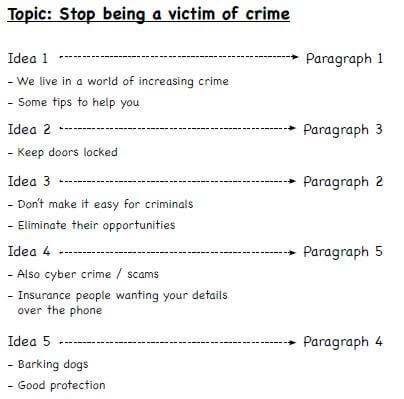
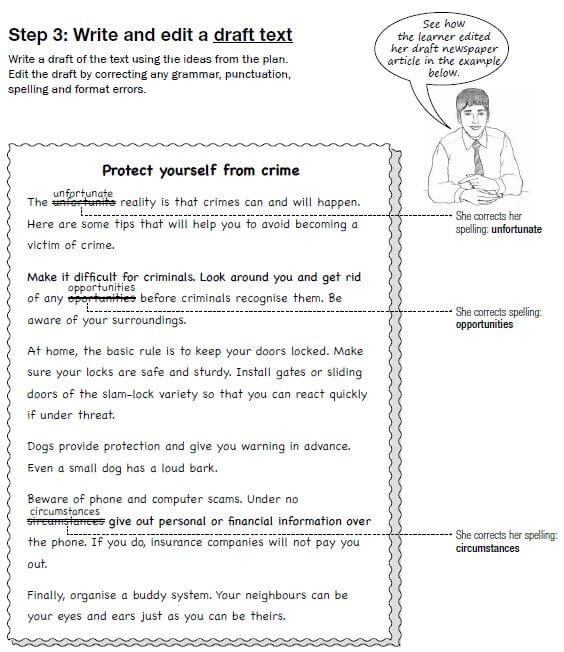
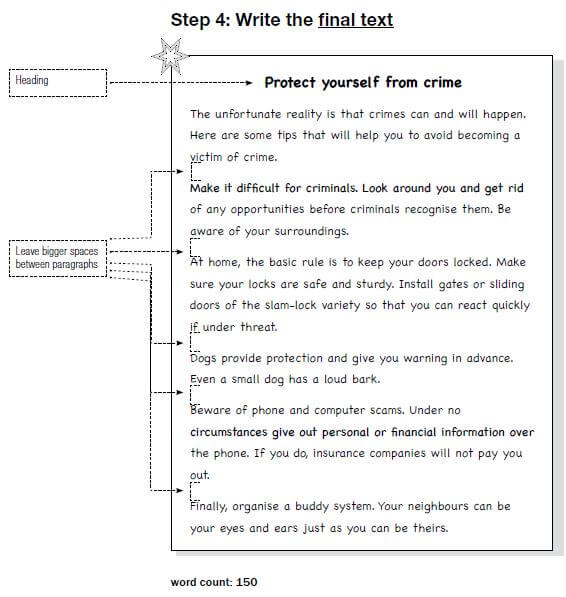
Activity: Writing a newspaper article
Here are some topics to help you to practise writing newspaper articles:
- The local newspaper has approached you as a learner in Grade 12 at the local high school. The newspaper would like you to write an article on the pressure of final examinations. Write this article.
- An intersection near your house is very dangerous and a number of accidents have occurred there. Your local newspaper has asked you to write an article for the newspaper about this problem.
- Write a newspaper article using this headline: Bullying on the increase in local school.
4.4 Newspaper article checklist
Features | Details of the feature | Yes | No | Don't know |
Text type | I understand the features of a newspaper article. | |||
Topic | I understand the topic I have chosen. | |||
Content, planning and format | ||||
Planning | I can show evidence of planning. | |||
Content | Each point in plan is relevant to my topic. | |||
Purpose / Audience | I understand the purpose of a newspaper article. | |||
Format | My newspaper article is correctly laid out:
| |||
Language, style and editing | ||||
Choice of words / diction | I have chosen my words carefully to make my newspaper article interesting. | |||
Language | I have checked and corrected my grammar, spelling and punctuation. | |||
4.5 Writing a magazine article
A magazine article is a piece of writing in a magazine about a particular subject. Like a newspaper article, it aims to entertain and inform the reader.
There are different kinds of magazine articles. Some give opinions. Some give advice. Some just present facts. Read the question carefully to make sure you write the right kind of article.
Hint:
|
eg: A learner’s example of a magazine article using the four steps
Step 1: Choose the text type and topic
This learner chose this question on a magazine article:
You are a committee member of your school magazine.
Write an article covering the sporting highlights of 2013.
Step 2: Plan the text
Identify the key words to use in your planning. In the question above,
the key words are school magazine and sporting highlights. The learner used a mind map to plan his magazine article.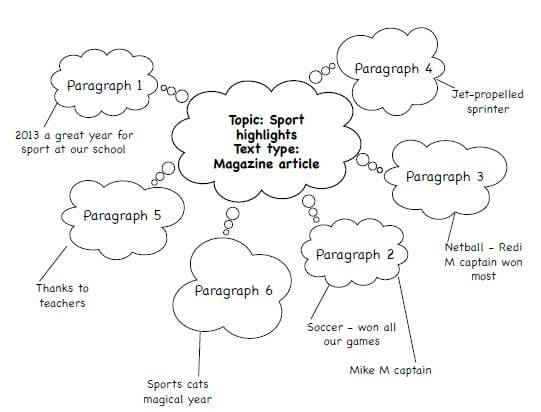
Step 3: Write and edit a draft text
Write a draft of the text using the ideas from the plan. Edit the draft
by correcting any grammar, punctuation, spelling and format errors.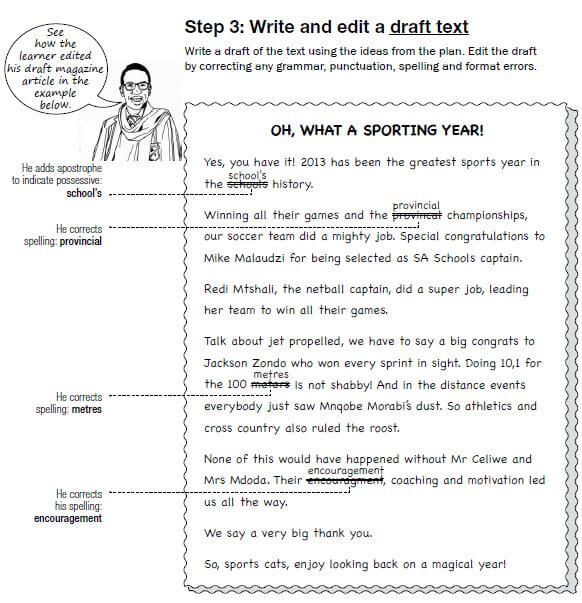
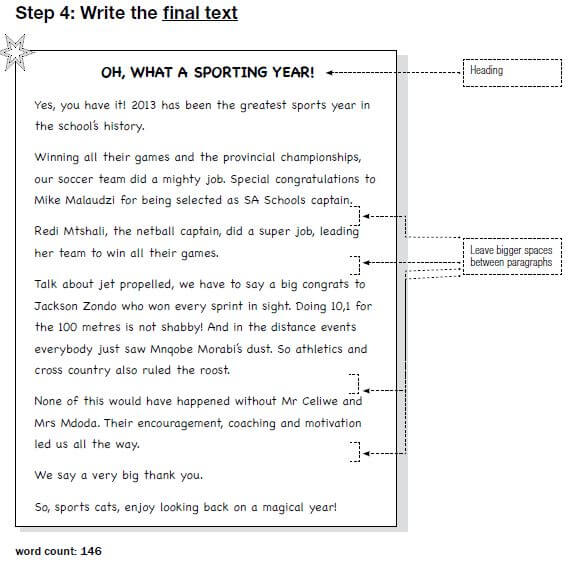
Activity: Writing a magazine article
Here are some topics to help you to practise writing magazine articles:
- You have been approached by the editor of a teenage magazine to write an article on peer pressure. Your focus should be on its effects and how to deal with it. Write this article.
- You work on a part-time basis for a small teenage magazine. Your next assignment is to write on changing teenage fashion trends. Write this article.
- Many young people overcome difficult circumstances. Write a magazine article about one such person, either real or imaginary.
4.6 Magazine article checklist
Features | Details of the feature | Yes | No | Don't know |
Text type | I understand the features of a magazine article. | |||
Topic | I understand the topic I have chosen. | |||
Content, planning and format | ||||
Planning | I can show evidence of planning. | |||
Content | Each point in plan is relevant to my topic. | |||
Purpose / Audience | I understand the purpose of a magazine article. | |||
Format | My magazine article is correctly laid out:
| |||
Language, style and editing | ||||
Choice of words / diction | I have chosen my words carefully to make my magazine article interesting. | |||
Language | I have checked and corrected my grammar, spelling and punctuation. | |||
4.7 Writing an agenda and minutes of a meeting
An agenda is a list of the subjects that will be discussed, as well as the procedure that will be followed, at a meeting. The agenda is prepared before the meeting.
Minutes are a written record of what was discussed and decided at a meeting. Minutes are recorded as a meeting is happening.
Hint:
|
eg: A learner’s example of an agenda and minutes using the four steps
Step 1: Choose the text type and topic
This learner chose this question on an agenda and minutes:
You are the secretary of your school’s Learners’ Representative Council. Write the agenda and minutes of a meeting in which the Council discussed latecomers.
Step 2: Plan the text
Identify the key words to use in your planning. In the question above, the key words are Learners’ Representative Council, agenda, minutes and latecomers.
The learner used a list to plan her agenda and minutes.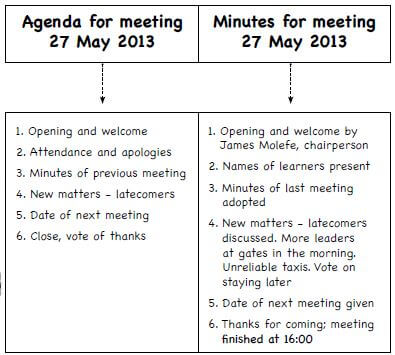
Step 3: Write and edit a draft text
Write a draft of the text using the ideas from the plan. Edit the draft by correcting any grammar, punctuation, spelling and format errors.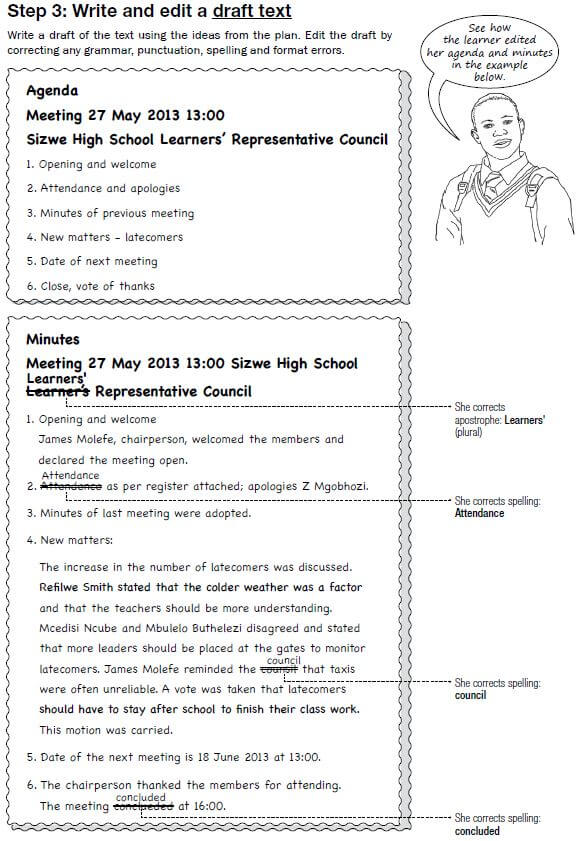
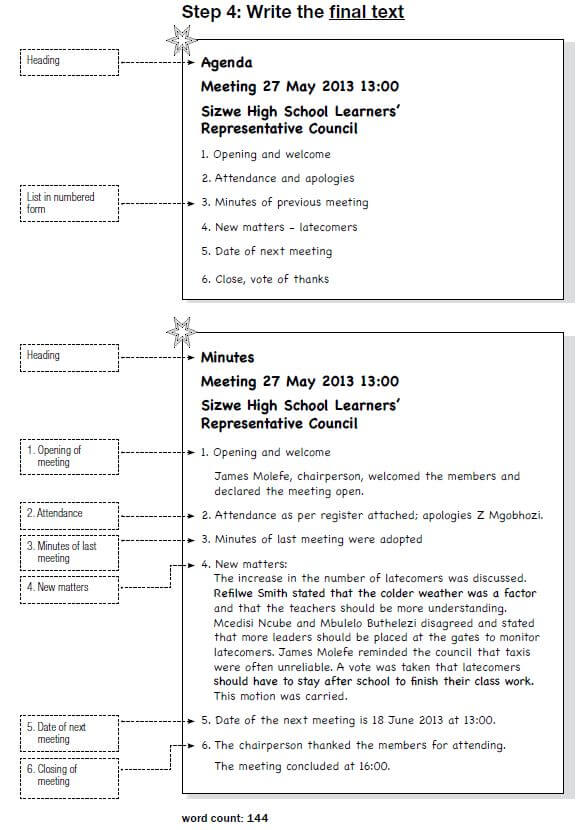
Activity: Writing an agenda and minutes
Here are some topics to help you to practise writing an agenda and minutes:
- As the chairperson of the Matric Committee, it is your task to organise the farewell assembly for the Grade 12s. You call a meeting of all the matrics and discuss this matter, taking various decisions. Write the agenda and minutes of this meeting
- You belong to a soccer / netball / athletics club. The next meeting of the committee is due to take place. Two issues are on the agenda: an increase in subscription fees, and the need to expand the clubhouse. Write the agenda and minutes of this meeting.
4.8 Agenda and minutes of a meeting checklist
Features | Details of the feature | Yes | No | Don't know |
Text type | I understand the features of an agenda and minutes. | |||
Topic | I understand the topic I have chosen. | |||
Content, planning and format | ||||
Planning | I can show evidence of planning. | |||
Content | Each point in plan is relevant to my topic. | |||
Purpose / Audience | I understand the purpose of an agenda and minutes. | |||
Format | My agenda and minutes are correctly laid out:
| |||
Language, style and editing | ||||
Choice of words / diction | I have chosen my words carefully to make my agenda and minutes accurate and informative. | |||
Language | I have checked and corrected my grammar, spelling and punctuation. | |||
4.9 Writing a formal report
A formal report is a written description of a situation or event after an investigation. Formal reports contain information and ideas that can help to resolve difficult situations.
Hint:
|
eg: A learner’s example of a formal report using the four steps
Step 1: Choose the text type and topic
This learner chose this question on a formal report:
You are the captain of a popular sporting code at your school. Your team participated in an interschool event during which one of your team members was seriously injured. Your school principal has requested a formal report from you on the incident and the action taken afterwards.
Write the report you will submit.
Step 2: Plan the text
Identify the key words to use in your planning. In the question above, the key words are interschool event, team member injured and action taken afterwards.
The learner has used a mind map to plan his report.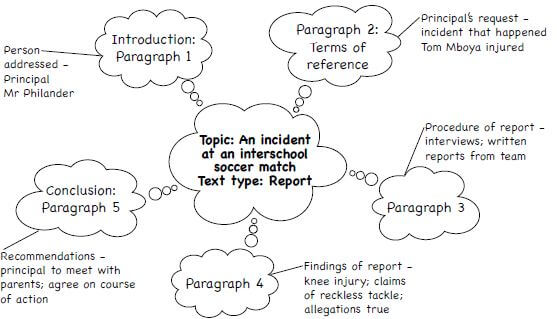
Step 3: Write and edit a draft text
Write a draft of the text using the ideas from the plan. Edit the draft by correcting any grammar, punctuation, spelling and format errors.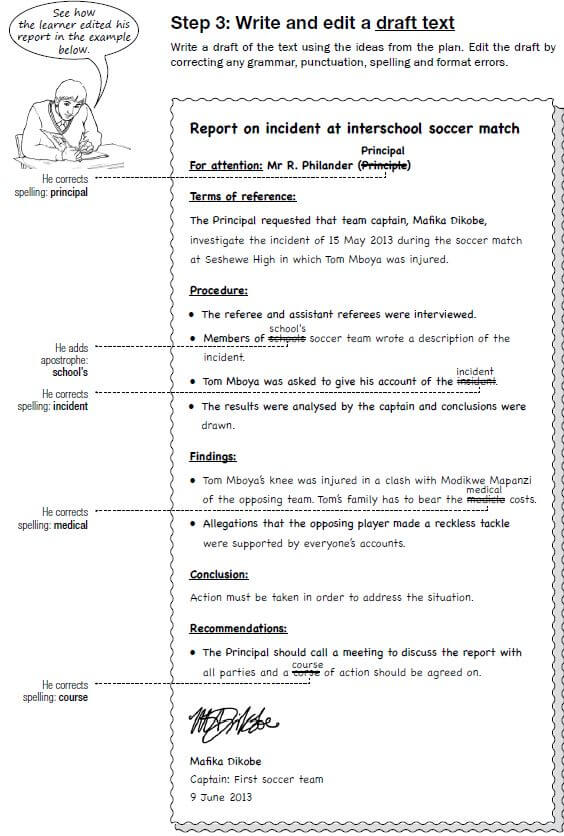
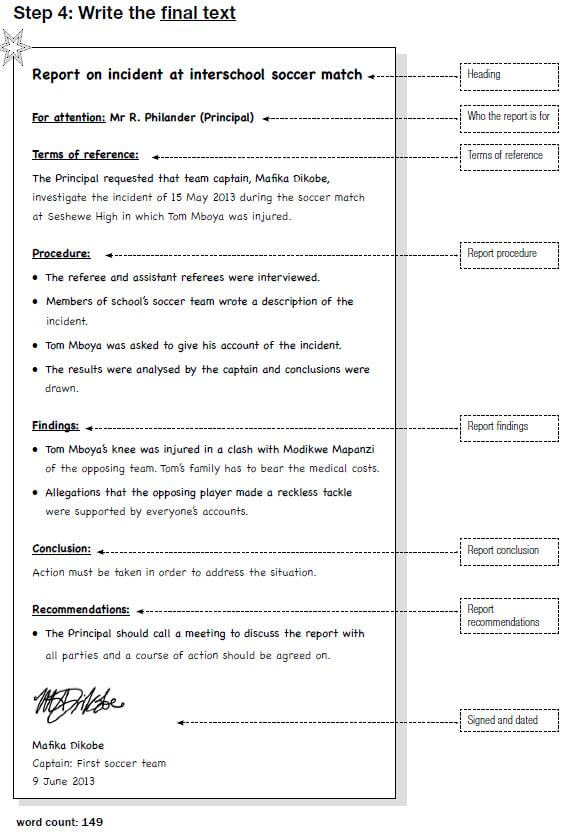
Activity: Writing a formal report
Here are some topics to help you to practise writing formal reports:
- There have been complaints at school that the prices charged by the tuckshop for food and cold drinks are too high.
The Deputy Principal has asked you to investigate this situation. Write the report that you will submit. - You belong to a community club for the youth. Recently attendance at club events has dropped considerably.
The youth leader, Mr N. Sithole, has asked you to investigate reasons for this situation. Write the report that you will submit.
4.10 Formal report checklist
Features | Details of the feature | Yes | No | Don't know |
Text type | I understand the features of a formal report. | |||
Topic | I understand the topic I have chosen. | |||
Content, planning and format | ||||
Planning | I can show evidence of planning. | |||
Content | Each point in plan is relevant to my topic. | |||
Purpose / Audience | I understand the purpose of a formal report. | |||
Format | My formal report is correctly laid out:
| |||
Language, style and editing | ||||
Choice of words / diction | I have chosen my words carefully to make my newspaper article interesting.report accurate and informative. | |||
Language | I have checked and corrected my grammar, spelling and punctuation. | |||
5. Category D
Category D in the exam paper covers the following:
- Dialogue
- Written interview
- Written formal and informal speech
Each one of these texts has a different format, serves a different purpose and has a different register.
5.1 Writing a dialogue
A dialogue is a conversation between two or more people. The people speak about a specific topic.
Hint:
|
eg: A learner’s example of a dialogue using the four steps
Step 1: Choose the text type and topic
This learner chose this question on a dialogue:
A close friend has upset you in some way. Write out the dialogue that takes place between you and your friend, in which you discuss with him/her what he/she has done to upset you.
Note: Use the dialogue format.
Step 2: Plan the text
Identify the key words to use in your planning. In the question above, the key words are close friend, upset and discuss.
The learner used a list to plan her dialogue.
Topic: Argument between friends
|
Step 3: Write and edit a draft text
Write a draft of the text using the ideas from the plan. Edit the draft by correcting any grammar, punctuation, spelling and format errors.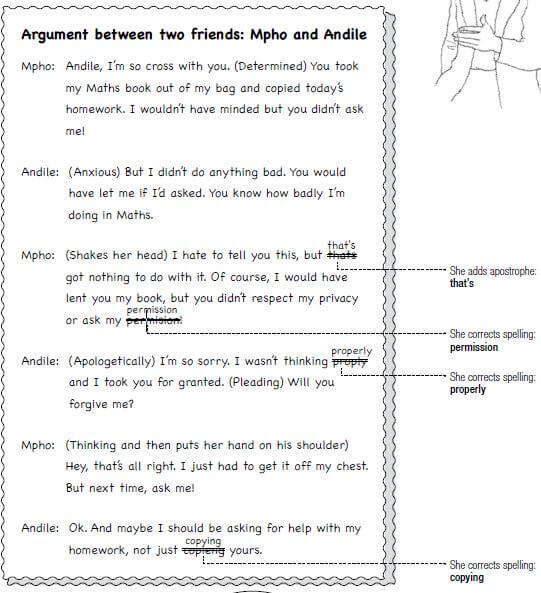
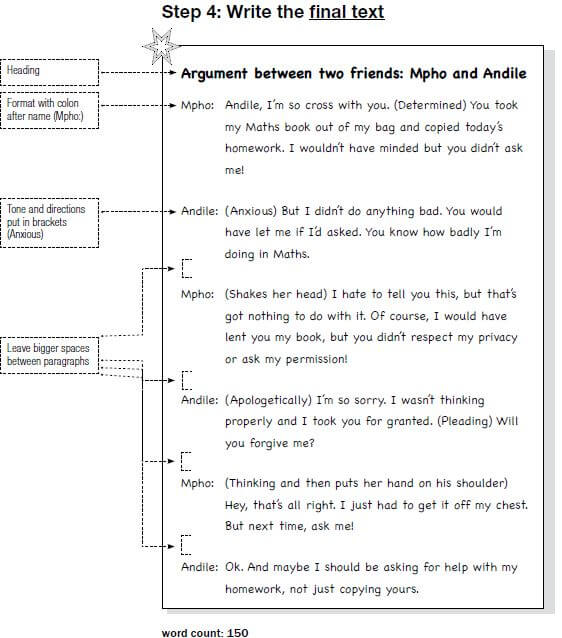
Activity: Writing a dialogue
Here are some topics to help you to practise writing dialogues:
- Eleni and Precious are good friends. However, Precious is going to “bunk” a Science class because she does not understand the subject and also believes the teacher cannot explain anything. Eleni is trying to persuade her not to do this.
Write the dialogue that takes place between the two friends. - You and your brother share a room. His untidiness is proving to be a problem and you feel you need to tell him about your unhappiness. Write the dialogue that takes place between the two brothers.
5.2 Dialogue checklist
Features | Details of the feature | Yes | No | Don't know |
Text type | I understand the features of a dialogue. | |||
Topic | I understand the topic I have chosen. | |||
Content, planning and format | ||||
Planning | I can show evidence of planning. | |||
Content | Each point in plan is relevant to my topic. | |||
Purpose / Audience | I understand the purpose of a dialogue. | |||
Format | My dialogue is correctly laid out:
| |||
Language, style and editing | ||||
Choice of words / diction | I have chosen my words carefully to make my dialogue interesting and life-like. | |||
Language | I have checked and corrected my grammar, spelling and punctuation. | |||
5.3 Writing an interview
An interview is a formal meeting at which someone is asked questions, such as a job interview. It may also be a TV or radio interview.
Hint:
|
eg: A learner’s example of an interview using the four steps
Step 1: Choose the text type and topic
This learner chose this question on an interview:
Your local municipality needs male and female administrative assistants. You have applied for one of these positions. The municipal manager has invited you to an interview. Write out the interview that takes place between the two of you.
NOTE: Use the dialogue format.
Step 2: Plan the text
Read the question carefully. Identify the key words to use in your planning. In this topic, the key words are administrative assistant, municipal manager, interview.
This learner used a mind map to plan his interview.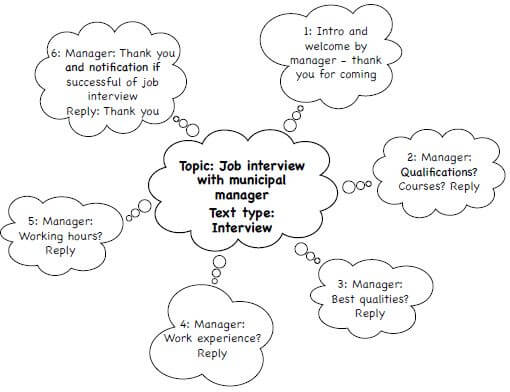
Step 3: Write and edit a draft text
Write a draft of the text using the ideas from the plan. Edit the draft by correcting any grammar, punctuation, spelling and format errors.
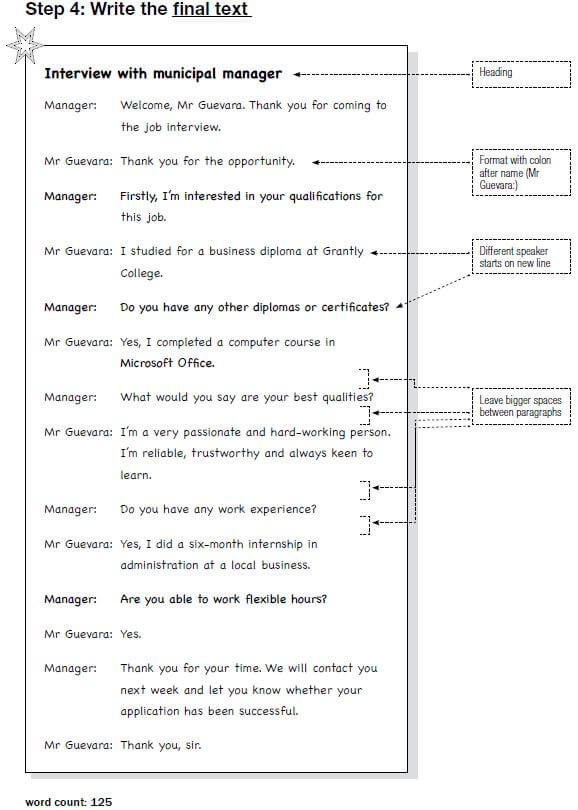
Activity: Writing an interview
Here are some topics to help you to practise writing interviews:
- You have applied for a bursary from a government department to study at a tertiary institution. The director of this department has called you for an interview.
Write down the interview that takes place between you and the director.
NOTE: Use the dialogue format. - You work for a local newspaper and your editor asks you to interview a well-known TV actor who lives near you. Write down the interview that takes place between you and the actor.
NOTE: Use the dialogue format.
5.4 Interview checklist
Features | Details of the feature | Yes | No | Don't know |
Text type | I understand the features of an interview. | |||
Topic | I understand the topic I have chosen. | |||
Content, planning and format | ||||
Planning | I can show evidence of planning. | |||
Content | Each point in plan is relevant to my topic. | |||
Purpose / Audience | I understand the purpose of an interview. | |||
Format | My interview is correctly laid out:
| |||
Language, style and editing | ||||
Choice of words / diction | I have chosen my words carefully to make interview interesting and life-like. | |||
Language | I have checked and corrected my grammar, spelling and punctuation. | |||
5.5 Writing a speech
A speech is a formal talk given to a group of people about a particular subject.
Hint:
|
eg: A learner’s example of a speech using the four steps
Step 1: Choose the text type
This learner chose this question on a speech:
You have been selected to deliver a farewell speech on behalf of the Grade 12 learners at your final school assembly.
Write out your speech.
Step 2: Plan the text
Read the question carefully. Note the key words in this topic are farewell speech and final school assembly.
This learner used a mind map to plan her speech.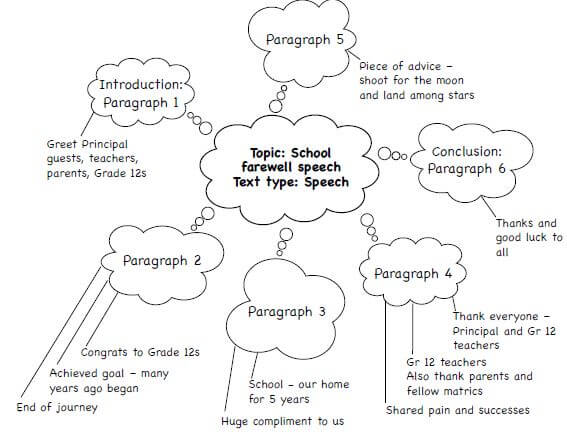
Step 3: Write and edit a draft text
Write a draft of the text using the ideas from the plan. Edit the draft by correcting any grammar, punctuation, spelling and format errors.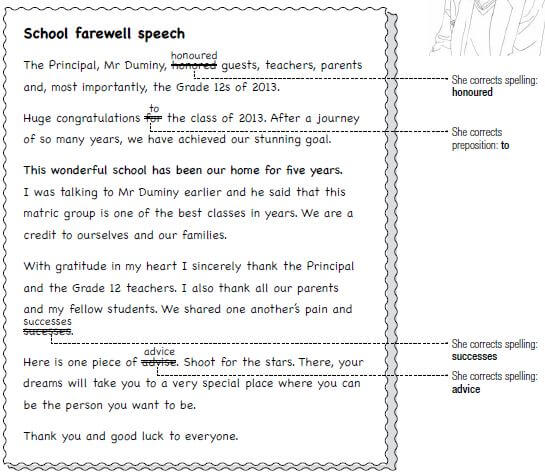
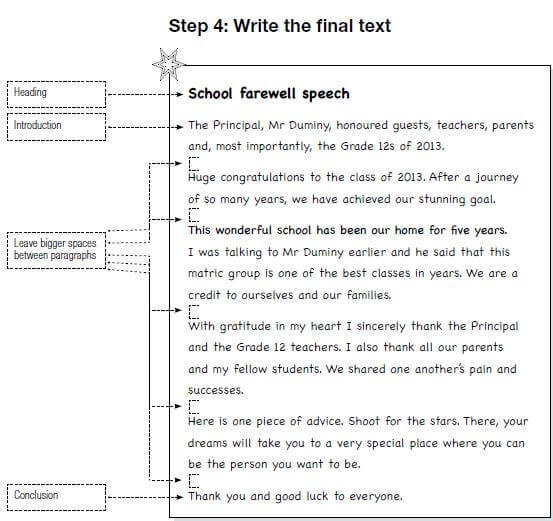
Activity: Writing a speech
Here are some topics to help you to practise writing speeches:
- A well-liked and respected Grade 12 teacher is leaving in the middle of the year. Your principal has asked you to deliver a farewell speech at the end-of-term assembly. Write this speech.
- You are the captain of a school sports team. The team has done well, thanks to a good coach. A function has been organised to celebrate the achievements of the team, and you have been asked to give a speech. Write this speech.
- A famous person is due to visit your school to deliver a motivational speech. Write the speech that will introduce this person to the school.
5.6 Speech checklist
Features | Details of the feature | Yes | No | Don't know |
Text type | I understand the features of a speech. | |||
Topic | I understand the topic I have chosen. | |||
Content, planning and format | ||||
Planning | I can show evidence of planning. | |||
Content | Each point in plan is relevant to my topic. | |||
Purpose / Audience | I understand the purpose of a speech. | |||
Format | My speech is correctly laid out:
| |||
Language, style and editing | ||||
Choice of words / diction | I have chosen my words carefully to make my speech interesting. | |||
Language | I have checked and corrected my grammar, spelling and punctuation. | |||
6. What is expected from you in the exam?
In the exam, you must write one longer transactional text that is no less than 120 words long and no more than 150 words long.
The longer transactional text question is worth 30 marks out of 100 marks in the exam. Examiners will give marks for your longer transactional text based on:
- Content, planning and format (18 marks)
- Language, style and editing (12 marks)
The exam is 2 1/2 hours long and your should spend about 40 minutes on the longer transactional text question.
The rubric on the next page is a table the examiners use to mark your longer transactional text. It shows the five levels of achievement that the examiners can award a longer transactional text, from the lowest achievement (Inadequate column) to the highest achievement (Exceptional column).
The table also describes the skills the examiner looks for when marking. For example, when marking the text, the examiner will assess how well the ideas relate to the topic, whether they are well planned, and that the format used is correct for the text type.
The rubric is a useful guide for you to use when practising your longer transactional text writing because it reminds you of the skills the examiner will be assessing
when marking your work.
ASSESSMENT RUBRIC FOR LONGER TRANSACTIONAL TEXT – FIRST ADDITIONAL LANGUAGE [30 MARKS]
| Criteria | Exceptional | Skillful | Moderate | Elementary | Inadequate |
| CONTENT, PLANNING & FORMAT Response and ideas; Organisation of ideas for planning; Purpose, audience, features/conventions and context 18MARKS | 15-18 | 11-14 | 8-10 | 5-7 | 0-4 |
|
|
|
|
| |
| LANGUAGE, STYLE & EDITING Tone, register, style, purpose/effect, audience and context; Language use and conventions; Word choice; Punctuation and spelling 12 MARKS | 10-12 | 8-9 | 6-7 | 4-5 | 0–3 |
|
|
|
|
| |
| MARK RANGE | 25-30 | 19-23 | 14-17 | 9-12 | 0-7 |
ESSAYS GRADE 12 NOTES - LITERATURE STUDY GUIDE
Section A
Essays
To write a successful exam essay, you need to give yourself time to plan your ideas and write a draft. Once you have edited and corrected your draft, your final essay should be a well-structured and interesting piece of writing.
In this section, you will learn how to express yourself using the rules that will earn you marks in the final Grade 12 exam.
1. All about essays
1.1 The structure of an essay
An essay must have an introduction, a body and a conclusion.
Introduction
The introduction is the first paragraph of an essay. It should catch the reader’s attention and suggest what the essay is about (the topic).
Body
The longest part of an essay is the body of the essay. It is divided into paragraphs. Each paragraph usually contains one main idea about the essay topic.
Conclusion
The last paragraph in an essay is the conclusion. It brings the essay to an end. No new information is given in the conclusion, but it often brings together some key points or ideas.
Vocab
- Coherent - expressed in a clear way that is easily understood
- Logical order - Arranging information so that the points follow each other in an order that makes sense.
Essay structure
|
1.2 Steps for writing an essay in the exams
There are four main steps involved in writing an exam essay:
Step 1: Choose your topic and type of essay
Step 2: Plan your essay
Step 3: Write and edit your draft essay
Step 4: Write your final essay
Step 1: Choose your topic and type of essay
Topic
In the essay section of the exam, there will be about eight topics. You need to choose one of these topics on which to write your essay. You only need to write one essay.
Essay type
A particular topic may suit one type of essay better than another type of essay. For example, if a topic asks whether you agree or disagree, then use the argumentative essay type. The table below shows brief descriptions of the five essay types. See pages 9 to 38 for more information on each essay type.
| The five essay types | ||
| 1 | Narrative essay | It tells a story; will have the word story in the topic; has characters, setting, plot |
| 2 | Descriptive essay | It describes an experience, an event or a place |
| 3 | Reflective essay | It shows how you think or feel about a topic. It shows your emotions, hopes and dreams |
| 4 | Discursive essay | It must present BOTH sides of an issue based on the topic. |
| 5 | Argumentative essay | It must support ONE side of an issue based on the topic |
Hint: Choosing an essay topic in the exam
|
Step 2: Plan your essay
Decide which type of essay you think is most suitable for the essay topic.
Remind yourself of the features of this type of essay.
Plan your essay by writing down your ideas for the content of the essay. The content refers to the main ideas (points or details) in your essay – what it is mainly about. It must be relevant to the topic.
Once you have written down a few ideas, you can organise them by numbering them. This will show the order of your paragraphs for the structure of your essay.
There are many different ways to plan an essay. For example, you could use a mind map. Use the planning method that works best for you. There are examples of planning tools on pages 5 and 6.
Essay content planning
|
Ways to plan an essay
A plan helps you think about what ideas you want to include in your essay. It also helps you put your ideas into a clear structure. You will earn marks for showing your planning.
You can use a mind map or an ideas list to plan your essay.
1. Mind maps
These are diagrams of ideas. The title is in the center with branches coming from it showing thoughts and ideas. Below is an example of a mind map.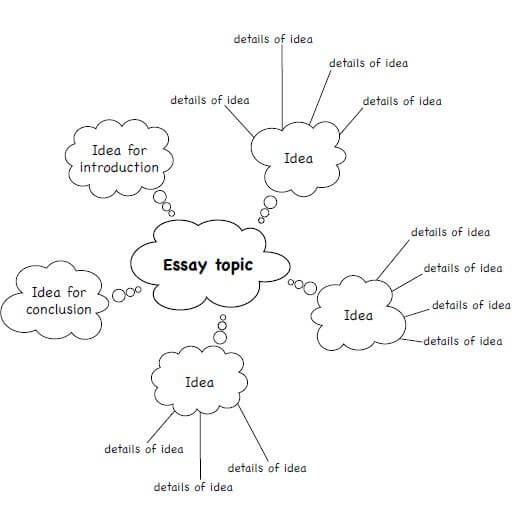
2. Idea lists
These help you to quickly write down ideas for each paragraph. Write down your ideas as they come to you and then organise them in a logical order. Below is an example.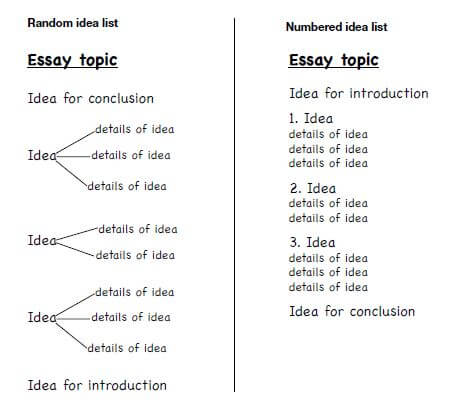
Step 3: Write and edit your draft essay
Write a draft of your essay, using the ideas from your plan.
Read through each sentence carefully to proofread it. Look for any spelling, punctuation or other language mistakes. Edit your draft by correcting these mistakes and making any other changes you think are needed.
This will improve your language and writing style in your final essay.
Count the number of words in your essay and make any changes to meet the word limit. For example, you may need to add some words or use fewer words.
NOTE:
- An essay must be between 250 to 300 words long.
Hint:
|
- The way you write your essay creates a style of writing. The words you chose and the length of your sentences are two examples of how a writing style is created.
- Think about your audience to help you chose the right register for your essay. Register can be formal. For example; if your audience is a teacher or informal if your andience is for example a friend.
- The tone of the essay is the feling the write gives the writing. For example, the tone could be playful or serious.
Step 4: Write your final essay
Write your final essay by rewriting your draft. Make sure that you make all the changes you marked in your draft so that your final essay has no mistakes and clearly expresses all your best ideas.
When you have finished your final essay, cross out your planning and draft essay. If you do not do this, the examiner may mark your draft and not your final essay.
Hint:
|
2. The five essay types
There are different types or genres of essays. Each type is written for a different purpose. To prepare for the exam, you need to revise how to write five types of essay:
- Narrative essays
- Descriptive essays
- Reflective essays
- Discursive essays
- Argumentative essays
The main features of each type of essay and guidelines for writing each type of essay are given in this section. To prepare for the exam, practice writing the different types of essays.
2.1 Narrative essays
A narrative essay tells a story or describes a sequence of events. It can be written from any perspective (first person or third person narrative). The first person narrator will use the pronouns “I” or “we”, while the third person narrator will use pronouns such as “he”, “she”, “they” and “them”.
A narrative essay can include dialogue (speech between characters in the story) and often includes interesting descriptions. This helps the reader to imagine what is happening, so the story comes alive.
| Hint: In a narrative essay, you must tell a story
|
A learner’s example of a narrative essay using the four steps
Step 1: Choose the topic and type of essay
- This learner chose this essay topic because it fitted a narrative essay type:
I am an old desk in a classroom and this is my story…
Note: Write a narratiove if the word "story" is in the description. Always give your essay a title.
Step 2: Plan the essay
The learner used a mind map to plan her essay.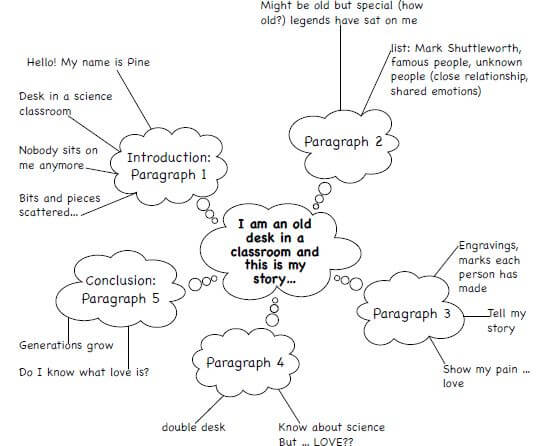
Step 3: Write and edit the draft essay
Editing means checking your draft and correcting any grammar, punctuation and spelling errors. You can also change your word choice to make your writing stronger.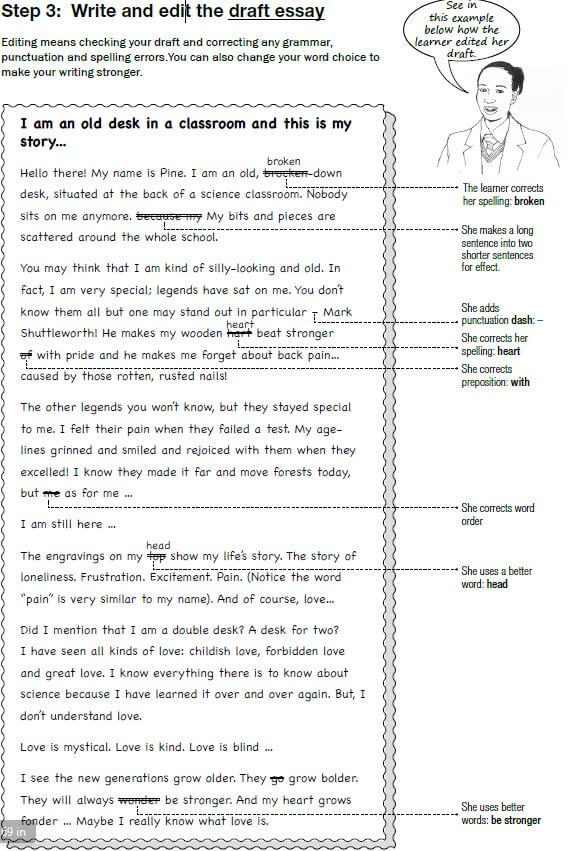
Step 4: Write the final essay
Note: By including her edits from her draft essay, the learner greatly improved her final essay.
I am an old desk in a classroom and this is my story… |
word count: 262
Main features of a narrative essay that are shown in this learner’s story
Features | Examples in the essay |
Characters
| Pine, learners (including famous people), and lovers, who used the desk |
Plot
| The story has a strong story line. The desk remembers people who have used it, and how they made it feel. It ends with the climax - as the desk realises that it loves learners who use it. |
Setting
| The science classroom. |
Theme
| The movement of learners through the classroom - they move on as they grow up, but the desk remains. The meaning of love. |
Structure
| From the past to the present, looking ahead to the future; from the concrete to the abstract. |
Creative use of language | Strong, interesting words are used, for example: age-lines, legends, scattered move forests, rejoice, excelled, rotten, frustration, forbidden love, mystical. Short sentences and paragraphs add impact. |
Activity: Writing a narrative essay
Here are some narrative essay topics to help you to practice your writing skills:
- Write a story that includes the following words:
Suddenly there was absolute silence...
NOTE: The words given in the topic MUST be included somewhere in your essay. - Write a story that begins with the following words:
It was the greatest day of my life.
NOTE: The words given in the topic MUST be used in the first sentence of your introduction.
2.2 Descriptive essays
In a descriptive essay, the writer describes an experience, an event, a situation, an object or a person. The purpose is to allow the reader to imagine what is being described as clearly as possible. Writing a descriptive essay is like creating a picture with words, rather than telling a story.
Hint:
|
A learner’s example of a descriptive essay using the four steps
Step 1: Choose the topic and type of essay
This learner chose this essay topic because it fitted a descriptive essay type:
The scene in the waiting area of a clinic OR a doctor’s surgery.
Note; The word scene in the topic sentence suggests that a descriptive essay is appropriate for this topic
Step 2: Plan the essay
The learner used a mind map to plan his essay.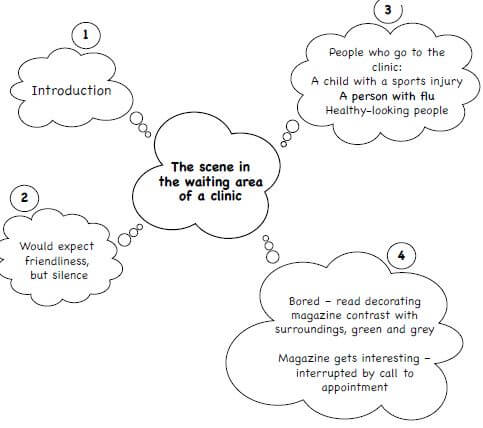
Step 3: Write and edit the draft essay
Editing means checking your draft and correcting any grammar, punctuation and spelling errors. You can also change your word choice to make your writing stronger.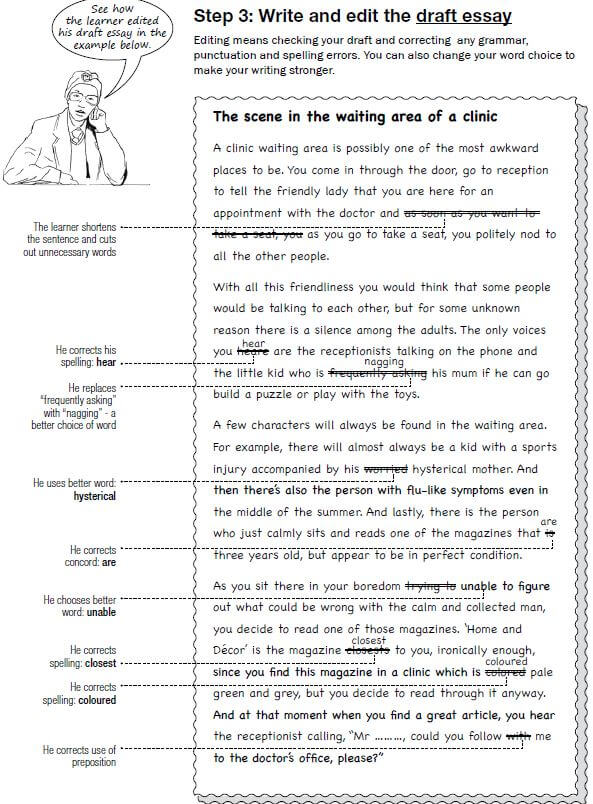
Step 4: Write the final essay
The scene in the waiting area of a clinic A clinic waiting area is possibly one of the most awkward places to be. You come in through the door, go to reception to tell the friendly lady that you are here for an appointment with the doctor and as you go to take a seat, you politely nod to all the other people. |
word count: 271
Main features of a descriptive essay that are shown in this learner’s essay
Features | Examples in the essay |
Characters
| Receptionist, the child, the mother, other people waiting in the queue |
Plot
| Description and observation of events from the moment of registration with the receptionist up to the point where the patient is called to see the doctor. |
Setting
| The waiting area of the clinic. |
Theme
| Awkwardness of being in a small public space with strangers. |
Structure
| The events move from the arrival up to the point when the doctor is ready to see the patient. |
Creative use of language | Strong, interesting words are used, for example; hysterical, flu-like symptoms, calm and collected man, coloured pale green and grey. |
Activity: Writing a descriptive essay
Here are some descriptive essay topics to help you to practise your writing skills:
- Write an essay on the following topic:
Life with my neighbors - Write an essay on the following topic :
It was a dream come true!
NOTE: The words given in the topic MUST be included somewhere in your essay. - Write an essay on the following topic :
An amazing performance.
2.3 Reflective essays
A reflective essay is written to explain what the writer thinks, and/or feels, about an object, an idea, a situation or an experience. It is subjective (based on the writer’s personal experience) and uses first person pronouns (“I”, “we”, “us”).
A reflective essay usually includes the writer’s emotional reactions or feelings. It could be about, for example, a dream, your hopes for the future or a past event.
Subjective - Your own personal feelings and point of view
In a reflective essay, you write your thoughts, hopes and dreams about the essay topic
|
A learner’s example of a reflective essay using the four steps
Step 1: Choose the topic and type of essay
This learner chose this essay topic because it fitted a reflective essay type:
Things I would like to achieve by the time I am 30.
A reflective essay will be about what you think and feel about a topic. It shows your emotions, hopes and dreams.
Step 2: Plan the essay
The learner used a mind map to plan her essay.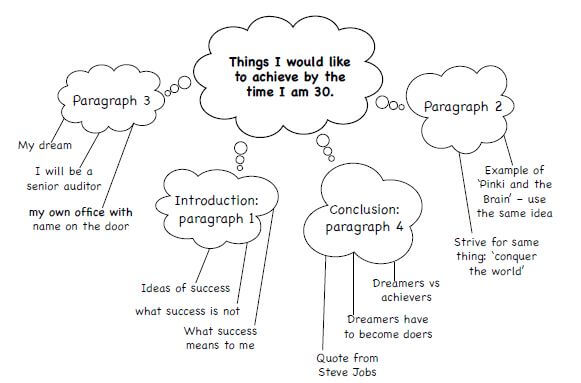
Step 3: Write and edit the draft essay
Editing means checking your draft and correcting any grammar, punctuation and spelling errors. You can also change your word choice to make your writing stronger.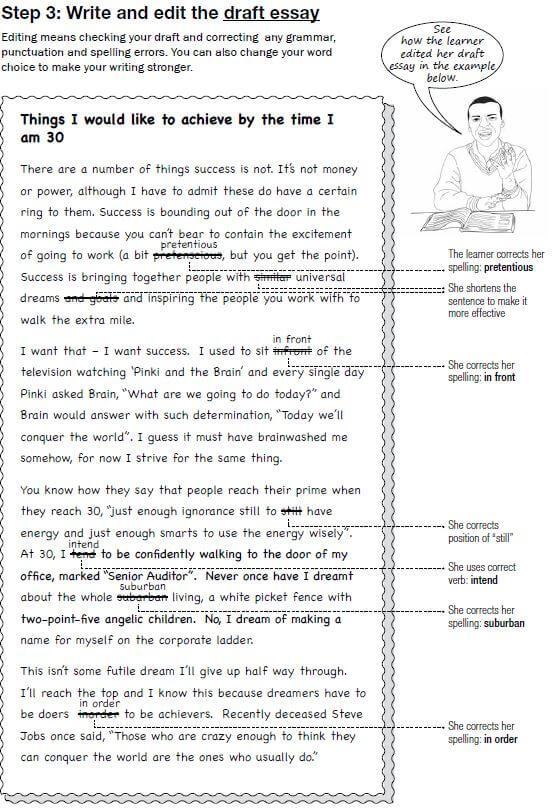
Step 4: Write the final essay
Note: Leave a line between each paragraph to make your essay easy to read.
Things I would like to achieve by the time I am 30 There are a number of things success is not. It’s not money or power, although I have to admit these do have a certain ring to them. Success is bounding out of the door in the mornings because you can’t bear to contain the excitement of going to work (a bit pretentious, but you get the point). Success is bringing together people with universal dreams and inspiring the people you work with to walk the extra mile. |
word count: 260
Main features of a reflective essay that are shown in this learner’s essay
Features | Examples in the essay |
Characters
| The speaker (the writer) is the main person in this story, as it is about personal hopes and dreams. Steve Jobs is quoted as an inspiring person. |
| Introduction | The writer introduces the main idea for the essay - "success". |
| Body | The writer's viewpoint is supported by examples of what personal success means to the writer. |
Creative use of language | Strong, interesting words are used, for example; success is bounding out of the door, universal dreams, walks the extra mile, conquer the world, brainwashed, a white picket fence with two-point0five angelic children. |
Activity: Writing a reflective essay
Here are some reflective essay topics to help you to practise your writing skills:
- Write an essay that includes the following words:
‘I wish I hadn’t ...’
NOTE: The words given in the topic MUST be included somewhere in your essay. - Write an essay that includes the following words:
As I looked at that photograph ...
NOTE: The words given in the topic MUST be included somewhere in your essay. - Write an essay that includes the following words:
This experience has made me realise that ...
NOTE: The words given in the topic MUST be included somewhere in your essay.
2.4 Discursive essays
The word “discursive” comes from the word “discourse” which means the sharing of thoughts and ideas.
A discursive essay presents both sides of an argument. Its purpose is to tell the reader about various sides of a topic. This could be the advantages and disadvantages of something, or the reasons for or against a particular point of view.
It must be objective (looking at both sides equally), and give a balanced view. In the conclusion, the writer usually gives a summary of the main points, and suggests, or recommends, some action or way forward.
In the conclusion, the writer may state the opinion, or view, with which he or she personally agrees. However, the reasons for that decision must be clearly shown in the essay.
Objective - giving a general point of view
Hint:
|
A learner’s example of a discursive essay using the four steps
Step 1: Choose the topic and type of essay
This learner chose this essay topic because it fitted a discursive essay type:
Freedom of choice has both advantages and disadvantages
Discuss this statement.
- In a discursive essay you must present
BOTH sides of an issue. For example, the advantages AND disadvantages of a topic.
Step 2: Plan the essay
The learner used a list to plan his essay.
TOPIC: Freedom of choice - advantages and disadvantages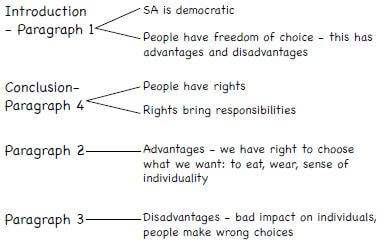
Step 3: Write and edit the draft essay
Editing means checking your draft and correcting any grammar, punctuation and spelling errors. You can also change your word choice to make your writing stronger.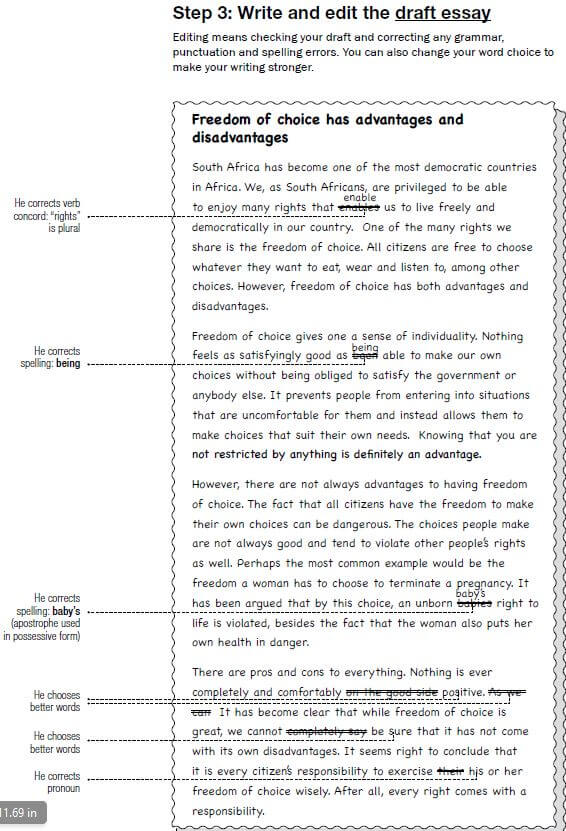
Step 4: Write the final essay
| Freedom of choice has advantages and disadvantages South Africa has become one of the most democratic countries in Africa. We, as South Africans, are privileged to be able to enjoy many rights that enable us to live freely and democratically in our country. One of the many rights we share is the freedom of choice. All citizens are free to choose whatever they want to eat, wear and listen to, among other choices. However, freedom of choice has both advantages and disadvantages. Freedom of choice gives one a sense of individuality. Nothing feels as satisfyingly good as being able to make our own choices without being obliged to satisfy the government or anybody else. It prevents people from entering into situations that are uncomfortable for them and instead allows them to make choices that suit their own needs. Knowing that you are no† restricted by anything is definitely an advantage. However, there are not always advantages to having freedom of choice. The fact that all citizens have the freedom to make their own choices can be dangerous. The choices people make are not always good and tend to violate other people’s rights as well. Perhaps the most common example would be the freedom a woman has to choose to terminate a pregnancy. It has been argued that by this choice, an unborn baby’s right to life is violated, besides the fact that the woman also puts her own health in danger. There are pros and cons to everything. Nothing is ever completely and comfortably positive. It has become clear that while freedom of choice is great, we cannot be sure that it has not come with its own disadvantages. It seems right to conclude that it is every citizen’s responsibility to exercise his or her freedom of choice wisely. After all, every right comes with a responsibility. |
Word count: 300
Features | Examples in the essay |
Content | The writer presents two sides of the argument, and makes a judgement at the end of the essay |
Introduction | The writer introduces the main idea for the essay - freedom of choice. |
Body | The writer presents both the advantages and disadvantages of freedom of choice. The writer organises the paragraphs by presenting arguments for, followed by arguments against, the topic. The concluding line shows the writer's personal view. |
Creative use of language | Strong, interesting words are used, for example; Freedom of choice gives one a sense of individuality; the choices people make are not always good and tend to violate other people's rights as well; an unborn baby's right to life is being violated; nothing is ever completely and comfortably positive. |
Activity: Writing a discursive essay
Here are some descriptive essay topics to help you to practise your writing skills:
- Sport can unite or divide people.
Discuss your views. - Do subjects offered at school prepare you for life?
Discuss your views. - Wearing school uniform is very important.
Do you agree?
Discuss your views on wearing school uniform.
2.5 Argumentative essays
In an argumentative essay, the writer expresses his or her opinion or viewpoint on a topic. The purpose of the essay is to try to convince, or persuade, the reader to agree with that opinion. The writer’s opinion about the topic is clear throughout the essay. It is a subjective essay, and strong personal opinions may be expressed.
In an argumentative essay, you must express your personal opinion about the topic
|
In an argumentative essay you must take a stand on a topic and then support your point of view.
A learner’s example of an argumentative essay using the four steps
Step 1: Choose the topic and type of essay
This learner chose this essay topic because it fitted an argumentative essay type:
Today young people are influenced more by their friends than by their parents.
Do you agree?
Step 2: Plan the essay
This learner used a list to plan her essay.
Topic: Influences on youth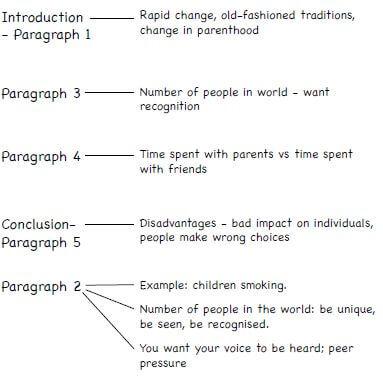
Step 3: Write and edit the draft essay
Editing means checking your draft and correcting any grammar, punctuation and spelling errors.
You can also change your word choice to make your writing stronger.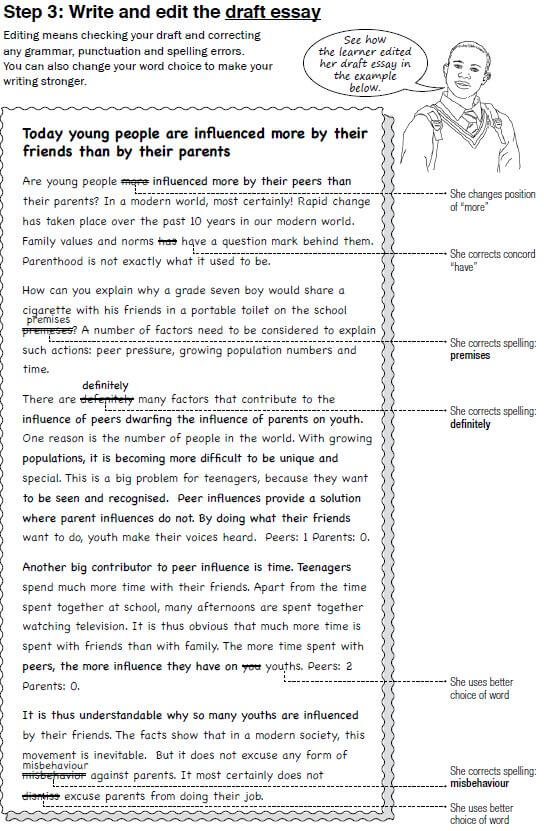
Step 4: Write the final essay
| Today Young People Are More Influenced By Their Friends than by Their Parents Are young people influenced more by their peers than their parents? In a modern world, most certainly! Rapid change has taken place over the past 10 years in our modern world. Family values and norms have a question mark behind them. Parenthood is not exactly what it used to be. How can you explain why a grade seven boy would share a cigarette with his friends in a portable toilet on the school premises? A number of factors need to be considered to explain such actions: peer pressure, growing population numbers and time. There are definitely many factors that contribute †o †he influence of peers dwarfing †he influence of parents on youth. One reason is the number of people in the world. With growing populations, it is becoming more difficult †o be unique and special. This is a big problem for teenagers, because they want to be seen and recognised. Peer influences provide a solution where parent influences do not. By doing what †heir friends want to do, youth make their voices heard. Peers: 1 Parents: 0. Another big contributor †o peer influence is †time. Teenagers spend much more time with their friends. Apart from the time spent together at school, many afternoons are spent together watching television. It is thus obvious that much more time is spent with friends than with family. The more time spent with peers, †he more influence †hey have on youths. Peers: 2 Parents: 0. *I† is thus understandable why so many youths are influencing by their friends. The facts show that in a modern society, this movement is inevitable. But it does not excuse any form of misbehavior against parents. It most certainly does not excuse parents from doing their job. |
Word count: 282
Main features of an argumentative essay that are shown in this learner's essay
Features | Examples in the essay |
Content | The writer begins with a general statement and moves on to explain her point of view. The viewpoint is supported with good reasons. |
Introduction | The writer introduces the main idea for the essay by giving some background to the topic. |
Body | The writer supports her viewpoint with examples. Related facts are combined within paragraphs. Use is made of connecting words to back up the argument. For example, How else can you explain; but; thus |
Creative use of language | Strong, interesting words are used. For example, values and norms; peers; dwarfing the influence of parents; in a modern society this movement is inevitable. |
Activity: Writing an argumentative essay
Here are some argumentative essay topics to help you to practise your writing skills:
- Most teenagers today do not pay much attention to leading a healthy life.
Do you agree? - Technology has changed the lives of teenagers.
Do you agree? - Should alcohol and cigarettes be advertised in the mass media?
Discuss your views.
2.6 Writing an essay from a picture
There is always a question in the exam that asks you to write an essay based on a picture. You only need to write an essay about ONE of the pictures. Choose which picture you are going to write about. Then you need to decide what type of essay you are going to write. The content of your essay must link with the picture.
Looking closely at the picture, identify information you can use in your essay. For example, the picture below shows a man who is:
- Laughing/smiling
- Dressed smartly in a shirt and tie
- Holding a baby
- Speaking/listening on the telephone
- Writing something in a book/diary
There are five different types of essay that could be written about this picture, as shown below.
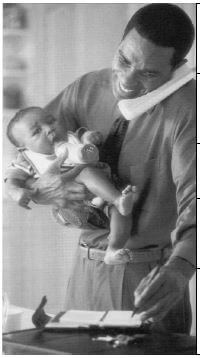 | 1. A narrative essay
|
2. A reflective essay
| |
3. A descriptive essay
| |
4. A discursive essay
| |
5. An argumentative essay
|
A learner’s example of an essay from a picture using the four steps
Step 1: Choose the topic and type of essay
This learner chose to write a reflective essay based on this picture of a watch: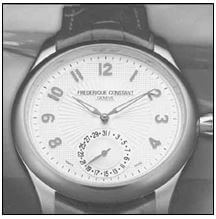
Step 2: Plan the essay
This learner used a mind map to plan his essay.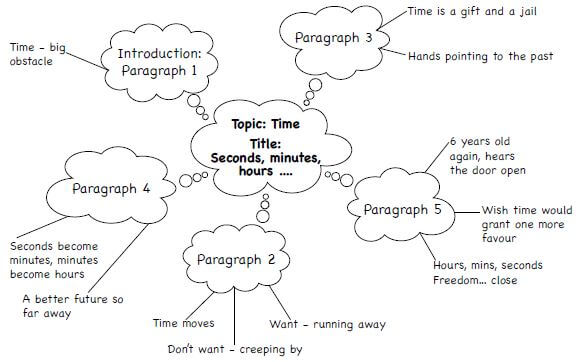
Step 3: Write and edit the draft essay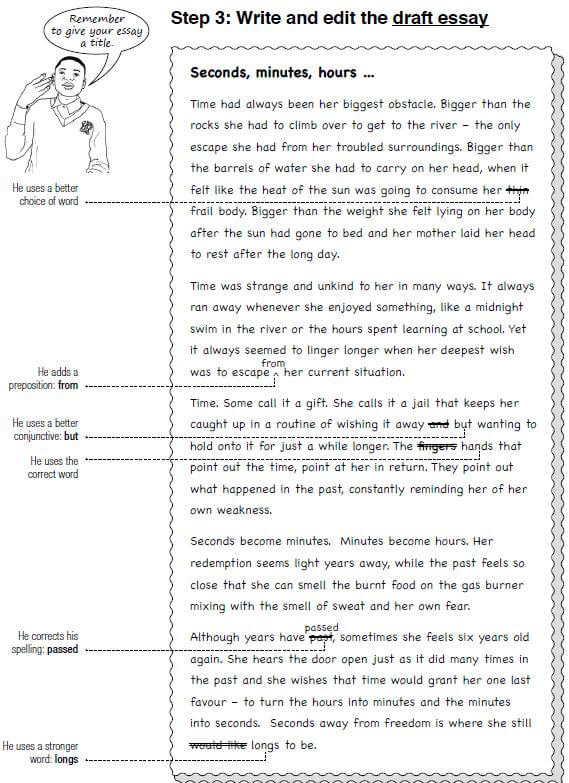
Step 4: Write the final essay
| Seconds, minutes, hours... Time had always been her biggest obstacle. Bigger than the rocks she had to climb over to get to the river – the only escape she had from her troubled surroundings. Bigger than the barrels of water she had to carry on her head, when it felt like the heat of the sun was going to consume her frail body. Bigger than the weight she felt lying on her body after the sun had gone to bed and her mother laid her head to rest after the long day. Time was strange and unkind to her in many ways. It always ran away whenever she enjoyed something, like a midnight swim in the river or the hours spent learning at school. Yet it always seemed to linger longer when her deepest wish was to escape from her current situation. Time. Some call it a gift. She calls it a jail that keeps her caught up in a routine of wishing it away but wanting to hold onto it for just a while longer. The hands that point out the time, point at her in return. They point out what happened in the past, constantly reminding her of her own weakness. Seconds become minutes. Minutes become hours. Her redemption seems light years away, while the past feels so close that she can smell the burnt food on the gas burner mixing with the smell of sweat and her own fear. Although years have passed, sometimes she feels six years old again. She hears the door open just as it did many times in the past and she wishes that time would grant her one last favour – to turn the hours into minutes and the minutes into seconds. Seconds away from freedom is where she still longs to be. |
Word count: 297
Features | Examples in the essay |
Content | The writer has interpreted the picture in a figurative way. That is, the watch reminds the writer of time and how it is linked to the events in someone's life. |
Introduction | The writer introduces the main idea for the essay by giving some background to the topic - time |
Body | In each paragraph, the writer talks about a different aspects of time in the woman's life; and how it did not work in her favour - it was a jail, not a gift. The essay ends with the character wishing that time would go faster, so she can escape from her current situation and be free of her past. |
Creative use of language | Strong, interesting figurative language is used, for example: the metaphor ' hands of time' can refer to the watch as well as to what happens to the character in the story. Alliteration is used in 'linger longer' to emphasise the slow passing of time. |
Activity: Writing an essay from a picture
Choose ONE of the pictures below and write an essay on a topic that comes to mind. Write the question number and give your essay a suitable title/heading.
Note: There must be a clear link between your essay and the picture you have chosen. Use your imagination when answering questions based on pictures. You can interpret them in any way.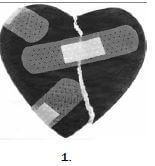
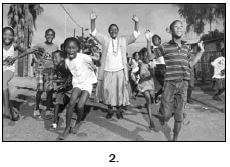
2.7 Essay checklist
Features | Examples in the essay | Yes | No | Don't know |
Essay instructions | I understand the exam instructions for writing an essay. | |||
Essay topic | I understand the essay topic I have chosen. | |||
Essay type | I understand the features of the essay type I have chosen:
| |||
Content and planning | ||||
Planning | I can show evidence of essay planning. | |||
Content | Each point in my plan is relevant to the essay topic. | |||
Purpose/audience | I understand the purpose of the essay type I have chosen. | |||
Structure | ||||
Sentences | I have not repeated sentences in my paragraphs, | |||
Paragraphs | My ideas link and are well organised in paragraphs. | |||
Essay structure | The first paragraph of my essay introduces the topic. | |||
Language, style and editing | ||||
Choice of words/diction | I have chosen my words carefully to make my essay interesting. | |||
Verb tenses | I have used the correct tenses (past, present or future) | |||
Concord | My nouns and verbs are in agreement | |||
Spelling | My spelling is correct | |||
Punctuation | My sentences start with a capital letter and end with a punctuation mark. | |||
3. What is expected from you in the exam?
In the exam, you must write one essay that is no less than 250 and no
more than 300 words long (about 1 to 1 1/2 pages).
The essay is worth 50 marks out of 100 marks in the exam - half the total marks for Paper 3. Examiners will give marks for your essay based on:
- Content and planning (30 marks)
- Language, style and editing (15 marks)
- Structure (5 marks)
The rubric on the next two pages is a table the examiners use to mark your essay. It shows the five levels of achievement that the examiners can award an essay, from the lowest achievement (Inadequate column) to the highest achievement (Exceptional column).
The table also describes the skills the examiner looks for when marking. For example, when marking an essay’s content, the examiner will assess how well the ideas relate to the topic, and whether they are well planned and organised.
The rubric is a useful guide for you to use when practising your essay writing because it reminds you of the skills the examiner will be assessing when marking your exam.
| Criteria | Exceptional | Skilful | Moderate | Elementary | Inadequate | |
| CONTENT & PLANNING (Response and ideas) Organisation of ideas for planning; Awareness of purpose, audience and context 30 MARKS | Upper level | 27–30 | 22–23 | 15-17 | 9-11 | 3-5 |
|
|
|
|
| ||
| Lower level | 24-26 | 18-20 | 12-14 | 6-8 | 0–2 | |
|
|
|
|
| ||
| LANGUAGE, STYLE & EDITING Tone, register, style, vocabulary appropriate to purpose/effect and context; Word choice; Language use and conventions, punctuation, grammar, spelling 15 MARKS | Upper level | 12-13 | 8-9 | 4-5 | 0-1 | |
|
|
|
|
| ||
| Lower level | 13 | 10 | 7 | 4 | ||
|
|
|
| |||
| STRUCTURE Features of text; Paragraph development and sentence construction 5 MARKS | 5 | 4 | 3 | 2 | 0-1 | |
|
|
|
|
|
LITERATURE; POETRY OVERVIEW GRADE 12 NOTES - LITERATURE; POETRY STUDY GUIDE
Dear Grade 12 learner
This Mind the Gap study guide helps you to prepare for the end-of-year Grade 12 English First Additional Language (EFAL) Literature exam.
There are three exams for EFAL: Paper 1: Language in Context; Paper 2: Literature; and Paper 3: Writing.
There are nine great EFAL Mind the Gap study guides which cover Papers 1, 2 and 3.
Paper 2: Literature includes the study of novels, drama, short stories and poetry. A Mind the Gap study guide is available for each of the prescribed literature titles. Choose the study guide for the set works you studied in your EFAL class at school.
This study guide focuses on the 10 prescribed poems examined in Paper 2: Literature. You will need to study all 10 poems for the exam:
- Sonnet 116 by William Shakespeare
- Death be not proud by John Donne
- An elementary school classroom in a slum by Stephen Spender
- Auto wreck by Karl Shapiro
- On his blindness by John Milton
- A prayer for all my countrymen by Guy Butler
- The birth of Shaka by Oswald Mbuyiseni Mtshali
- The serf by Roy Campbell
- Mementos, 1 by WD Snodgrass
- Cheetah by Charles Eglington
How to use this study guide
There is one chapter for each poem. Each chapter includes a copy of the poem and information about:
- The poet;
- The themes;
- Words you need to know to understand the poem;
- Type and form;
- Line-by-line analysis; and
- Tone and mood.
All the above information is contained in a one-page summary. Use the 10 summaries to help you hold the 10 poems clearly in your mind.
You can test your understanding of each poem by completing the activities, then use the answers to mark your own work. The activities are based on the kinds of questions you will find in the exam.
Top 7 study tips
- Break your learning up into manageable sections. This will help your brain to focus. Take short breaks between studying one section and going onto the next.
- Have all your materials ready before you begin studying a section – pencils, pens, highlighters, paper, glass of water, etc.
- Be positive. It helps your brain hold on to the information.
- Your brain learns well with colours and pictures. Try to use them whenever you can.
- Repetition is the key to remembering information you have to learn. Keep going over the work until you can recall it with ease.
- Teach what you are learning to anyone who will listen. It is definitely worth reading your revision notes aloud.
- Sleeping for at least eight hours every night, eating healthy food and drinking plenty of water are all important things you need to do for your brain. Studying for exams is like exercise, so you must be prepared physically as well as mentally.
On the exam day
- Make sure you bring pens that work, sharp pencils, a rubber and a sharpener. Make sure you bring your ID document and examination admission letter. Arrive at the exam venue at least an hour before the start of the exam.
- Go to the toilet before entering the exam room. You don’t want to waste valuable time going to the toilet during the exam.
- You must know at the start of the exam which two out of the four sections of the Paper 2 Literature exam you will be answering. Use the 10 minutes’ reading time to read the instructions carefully.
- Break each question down to make sure you understand what is being asked. If you don’t answer the question properly you won’t get any marks for it. Look for the key words in the question to know how to answer it. You will find a list of question words on pages xiv and xv of this study guide.
- Manage your time carefully. Start with the question you think is the easiest. Check how many marks are allocated to each question so you give the right amount of information in your answer.
- Remain calm, even if the question seems difficult at first. It will be linked with something you have covered. If you feel stuck, move on and come back if time allows. Do try and answer as many questions as possible.
- Take care to write neatly so the examiners can read your answers
Overview of the English First Additional Language Paper 2: Literature exam
In the Paper 2 Literature exam, you need to answer questions from two sections. Choose the two sections that you know best:
- Section A: Novel
- Section B: Drama
- Section C: Short stories
- Section D: Poetry
A total of 70 marks is allocated for Paper 2, which means 35 marks for each section you choose.
You will have two hours for this exam.
Here is a summary of the Paper 2 Literature exam paper:
Question number | Title of novel | Type of question | Number of marks |
Section A: Novel If you choose Section A, answer ONE question. Choose the question for the book you have learnt. | |||
1. | To Kill a Mockingbird | Contextual | 35 |
2. | Lord of the Flies | Contextual | 35 |
3. | A Grain of Wheat | Contextual | 35 |
Section B: Drama If you choose Section B, answer ONE question. Choose the question for the play you have learnt. | |||
4. | Romeo and Juliet | Contextual | 35 |
5. | Nothing but the Truth | Contextual | 35 |
Section C: Short stories If you choose Section C, answer BOTH questions. You will not know exactly which short stories are included until the exam. TWO stories will be set. Answer the questions set on BOTH short stories. | |||
6.1 | Short story | Contextual | 17 or 18 |
6.2 | Short story | Contextual | 17 or 18 |
Section D: Poetry If you choose Section D, answer BOTH questions. You will not know exactly which poems are included until the exam. TWO poems will be set. Answer the questions set on BOTH poems. | |||
7.1 | Poem | Contextual | 17 or 18 |
7.2 | Poem | Contextual | 17 or 18 |
What is a contextual question?
In a contextual question, you are given an extract from the poem. You then have to answer questions based on the extract. Some answers you can find in the extract. Other questions will test your understanding of other parts of the poem. Some questions ask for your own opinion about the poem.
What are the examiners looking for?
Examiners will assess your answers to the contextual questions based on:
- Your understanding of the literal meaning of the poem. You need to identify information that is clearly given in the poem.
- Your ability to reorganise information in the poem. For example, you may be asked to summarise key points.
- Your ability to provide information that may not be clearly stated in the extract provided, using what you already know about the text as a whole. This process is called inference. For example, you may be asked to explain how a figure of speech affects your understanding of the poem as a whole.
- Your ability to make your own judgements and form opinions about aspects of the poem. This process is called evaluation. For example, you may be asked if you agree with a statement.
- Your ability to respond to the emotional level of a poem. This is called appreciation. For example, you may be asked what you would have done in the situation described in the poem. You may be asked to discuss how the writer’s style helps to describe the tone and mood of a poem.
Question words
Here are examples of question types found in the exam.
Question type | What you need to do |
Literal: Questions about information that is clearly given in the text or extract from the text | |
Name characters/places/things ... | :Write the specific names of characters, places, etc. |
State the facts/reasons/ideas … | Write down the information without any discussion or comments. |
Give two reasons for/why … | Write two reasons (this means the same as ‘state’). |
Identify the character/reasons/theme … | Write down the character’s name, state the reasons. |
Describe the place/character/what happens when … | Write the main characteristics of something, for example: What does a place look/feel/smell like? Is a particular character kind/rude/ aggressive … |
What does character x do when … | Write what happened – what the character did. |
Why did character x do … | Given reasons for the character’s action according to your knowledge of the plot. |
Who is/did … | Write the name of the character. |
To whom does xx refer … | Write the name of the relevant character/person. |
Reorganisation: Questions that need you to bring together different pieces of information in an organised way. | |
Summarise the main points/ideas … | Write the main points, without a lot of detail. |
Group the common elements … | Join the same things together. |
Give an outline of ….. | Write the main points, without a lot of detail. |
Inference Questions that need you to interpret (make meaning of) the text using information that may not be clearly stated. This process involves thinking about what happened in different parts of the text; looking for clues that tell you more about a character, theme or symbol; and using your own knowledge to help you understand the text. | |
Explain how this idea links with the theme x … | Identify the links to the theme. |
Compare the attitudes/actions of character x with character y … | Point out the similarities and differences. |
What do the words … suggest/reveal about /what does this situation tell you about … | State what you think the meaning is, based on your understanding of the text. |
How does character x react when …. Describe how something affected … State how you know that character x is … | Write down the character’s reaction/ what the character did/felt. |
What did character x mean by the expression … | Explain why the character used those particular words. |
Is the following statement true or false? | Write ‘true’ or ‘false’ next to the question number. You must give a reason for your answer. |
Choose the correct answer to complete the following sentence (multiple choice question). | A list of answers is given, labelled A–D. Write only the letter (A, B, C or D) next to the question number. |
Complete the following sentence by filling in the missing words … | Write the missing word next to the question number. |
Quote a line from the extract to prove your answer. | Write the relevant line of text using the same words and punctuation you see in the extract. Put quotation marks (“ ” inverted commas) around the quote. |
Evaluation Questions that require you to make a judgement based on your knowledge and understanding of the text and your own experience. | |
Discuss your view/a character’s feelings/a theme ... | Consider all the information and reach a conclusion. |
Do you think that … | There is no ‘right’ or ‘wrong’ answer to these questions, but you must give a reason for your opinion based on information given in the text. |
Do you agree with … | |
In your opinion, what … | |
Give your views on … | |
Appreciation Questions that ask about your emotional response to what happens, the characters and how it is written. | |
How would you feel if you were character x when … | There is no ‘right’ or ‘wrong’ answer to these questions, but you must give a reason for your opinion based on information given in the text. |
Discuss your response to … | |
Do you feel sorry for … | |
Discuss the use of the writer’s style, diction and figurative language, dialogue … | To answer this type of question, ask yourself: Does the style help me to feel/imagine what is happening/what a character is feeling? Why/why not? Give a reason for your answer. |
Literary features found in poems
| Diction | The poet’s choice of words and how he/she organises them. |
Euphemism | A mild or vague expression in place of a word that is more harsh or direct. |
First person | The poem is written from the point of view of ‘I’ or ‘we’. |
Hyperbole | A deliberate exaggeration. For example, ‘a big’ plate of food is described as ‘a mountainous’ plate of food |
Irony | A statement or situation that has an underlying meaning that is different from the literal meaning. |
Metaphor | A figure of speech that uses one thing to describe another in a figurative way. |
Mood | The emotions felt by the reader when reading the poem. |
Oxymoron | A combination of words with contradictory meanings (meanings which seem to be opposite to each other). For example, ‘an open secret’ |
Personification | Giving human characteristics to non-human beings. |
Pun | A play on words which are identical or similar in sound. It is used to create humour. |
Rhyme | Lines of poetry that end in the same sound. |
Rhythm | A regular and repeated pattern of sounds. |
Sarcasm | An ironic expression which is used to be unkind or to make fun of someone. |
Simile | Comparing one thing directly with another. ‘Like’ or ‘as’ is used to make this comparison. |
Symbol | Something which stands for or represents something else |
Theme | Themes are the main messages of a text. There are usually a few themes in each poem. |
Third person | The poem is written from the point of view of ‘he’, ‘she’ or ‘they’. |
| Tone | The feeling or atmosphere of the poem. |
Sound devices: | |
| Alliteration | A pattern of sounds that includes the repetition of consonant sounds. The repeated sound can be either at the beginning of successive words or inside the word. |
Assonance | The vowel sounds of words that occur close together are repeated. |
Consonance | A sound that occurs at the end of words that are close together is repeated. |
| Onomatopoeia | The use of words to create the sounds being described. |
CHEETAH BY CHARLES EGLINGTON GRADE 12 NOTES - LITERATURE; POETRY STUDY GUIDE
Cheetah by Charles Eglington
This poem was written by Charles Eglington (1918-1971). Eglington was born in Johannesburg and graduated from Wits University. He spent his life working in the media as a newspaper journalist, a translator and also in radio. Many of his poems are about animals.
Fun fact
- Did you know the cheetah is the world's fastest animal - it can reach speeds of up to 96 kilometres per hour!
1. Themes
The main themes in this poem are that appearances can be misleading; and that in nature only the strongest survive.
The poet tells the story of an ordinary event among wild animals in nature – a hunter catching its prey. In the first part of the poem, the poet describes a young cheetah lying relaxed in the long grass of the bushveld, while a herd of buck grazes nearby. The buck do not know that the cheetah is close by.
The big cat is waiting for darkness before hunger makes it go out and hunt. Then the cheetah races forward towards the herd, which smells it and begins to run in panic. The chase is like a lottery, as the buck do not know which one of them will be caught. The cheetah leaps on one unlucky buck and kills it. (Cheetahs knock their prey down, jump on it and then bite its neck to kill it.)
| Cheetah by Charles Eglington | ||
Stanza 1 | Indolent and kitten-eyed, | |
This is the bushveld’s innocent | ||
The stealthy leopard parodied | ||
With grinning, gangling pup-content. | ||
Stanza 2 | Slouching through the tawny grass | 5 |
Or loose-limbed lolling in the shade, | ||
Purring for the sun to pass | ||
And build a twilight barricade. | ||
Stanza 3 | Around the vast arena where, | |
In scattered herds, his grazing prey | 10 | |
| Do not suspect in what wild fear | ||
| They’ll join with him in fatal play; | ||
Stanza 4 | Till hunger draws slack sinews tight | |
As vibrant as a hunter’s bow; | ||
Then, like a fleck of mottled light, | 15 | |
He slides across the still plateau. | ||
Stanza 5 | A tremor rakes the herds: they scent | |
The pungent breeze of his advance; | ||
Heads rear and jerk in vigilant | ||
Compliance with the game of chance. | 20 | |
Stanza 6 | In which, of thousands, only one | |
Is centred in the cheetah’s eye; | ||
They wheel and then stampede, for none | ||
Knows which it is that has to die. | ||
Stanza 7 | His stealth and swiftness fling a noose | 25 |
And as his loping strides begin | ||
To blur with speed, he ropes the loose | ||
Buck on the red horizon in. | ||
Words to know
Definitions of words from the poem: | ||
Line 1: | indolent | lazy |
Line 2: | innocent | harmless |
Line 3: | stealthy | quiet, sneaky, secret, dangerous |
parodied | copy in a funny way | |
Line 4: | grinning | smiling |
gangling | long-legged, awkward, clumsy | |
pup-content | happy | |
Line 5: | Slouching | moving casually, relaxed |
tawny | yellowish-brown | |
Line 6: | loose-limbed | with relaxed legs |
lolling | lying back, relaxing | |
Line 7: | purring | sound made by a happy cat |
Line 8: | twilight | early evening |
barricade | barrier, wall | |
Line 9: | vast | very big |
arena | stadium, sports field | |
Line 10: | scattered | spread out |
grazing | eating grass | |
prey | something or somebody who is being hunted | |
Line 11: | do not suspect | have no thoughts, do not expect |
Line 12: | fatal | ending in death |
Line 13: | slack | loose |
sinews | tough fibres that tie muscles to bone | |
Line 14: | vibrant | full of life, energy |
bow | weapon used to shoot arrows | |
Line 15: | fleck | tiny spot |
mottled | patches of light and dark, full of shadows | |
Line 16: | slides | moves smoothly, swiftly, quietly |
plateau | flat raised ground | |
Line 17: | tremor | shaking, shiver |
rakes | moves through | |
scent | smell | |
Line 18: | pungent | strong smell |
advance | moving towards them | |
Line 19: | rear | lift quickly |
jerk | pull up quickly | |
vigilant | watchful, senses danger | |
Line 20: | compliance | giving in to, obeying the rules |
Line 22: centred | in the middle of, focused, given attention |
Line 23: wheel | turn |
stampede | run away in terror and panic |
Line 25: swiftness | quickness |
fling | throw |
noose | circle of rope |
Line 26: loping | running |
strides | big steps |
Line 27: blur | look unclear and fuzzy |
Line 28: horizon | far distance |
2. Type and form
This is a narrative poem that tells the story of how the cheetah hunts its prey.
The poem has a formal structure (the way it is set out) with seven stanzas of four lines each (quatrains) that have a regular pattern of rhyme (abab).
Each of the seven stanzas tells a different part of the story. Some stanzas focus on the cheetah, others on the buck. In the last stanza, the two come together when the cheetah catches a buck. The poem’s structure (the form) and the hunt described in the poem (the content) are closely linked in an effective way.
3. Analysis
Stanza 1 (lines 1 – 4) Indolent and kitten-eyed, |
In stanza one, the poet describes the cheetah as seeming to be harmless. The poet uses imagery as if he is describing a harmless young animal – the cheetah looks “innocent”. The metaphor “kitten-eyed” (line 1), compares the cheetah’s big eyes to those of a sweet kitten. The poet feels the leopard is a more impressive-looking animal and that the cheetah is a “parody” (or funny copy) of a leopard.
Both the leopard and the cheetah are big cats that have spots, but where the leopard is described as “stealthy” (line 2), which suggests it is secret and dangerous, the cheetah seems to smile in a rather silly way. The metaphor “pup-content” (line 4) compares it to a happy (and harmless) puppy.
The word “gangling” means it has long, loose legs that make it seem rather awkward and clumsy. The words for baby animals like “kitten” and “pup” suggest it is young, as does “gangling”, as teenage animals (including people) often seem to have long, thin bodies before they grow older, stronger and more muscular.
Stanza 2 (lines 5 – 8) Slouching through the tawny grass |
The cheetah moves lazily and casually (“slouching” in line 5) through the grass or lies back, (“lolling” in line 6) in the shade during the day. Notice how the alliteration links the words “Loose-limbed lolling” in line 5, emphasising how relaxed the animal is.
The big cat purrs like a happy house cat as it waits patiently for the sun to set. Again, this makes the cheetah seem harmless, as cats purr when they are relaxed and content. At twilight it is growing dark and the metaphor “barricade” (line 8) compares the darkness to a wall or barrier that will hide the cheetah when it hunts. Barricades are often built across streets during wars or riots, so the poet’s diction (choice of words) creates a more uneasy tone with the use of “barricade”.
Up to now, the herd of buck and the cheetah seem relaxed. By including the word “barricade”, the poet introduces tension at the end of the stanza. The barricade interrupts the relaxed tone.
Stanza 3 (lines 9 – 12) Around the vast arena where, |
The tension in the poem grows. The poet sets the scene for the hunt. The huge grasslands (“vast arena” line 9), the herds of buck that are spread about (“scattered”) as they graze and have no idea that there is a cheetah nearby waiting to kill one of them, its “prey” (line 10). In this stanza, the poet uses an extended metaphor which is carried on in the first and last lines of the stanza. The hunt is compared to a game that is played to the death in an “arena”. This game or “fatal play” (line 12) is an oxymoron, because “play” suggests a game, but “fatal” means deadly, so this game will end in a death.
This creates a visual image (a picture we can see in our minds) of the games in the Coliseum, the great sports stadium of ancient Rome, when spectators enjoyed watching men fight with swords and the loser was often killed. As we read, we feel fearful for the unsuspicious buck that do not know of the danger that is coming. We begin to sympathise with the “wild fear” (line 9) they will feel when the cheetah begins its chase. Notice how vividly and strikingly the poet’s diction in “wild fear” conveys the panic the buck are going to feel. The uneasy tone becomes stronger now.
Stanza 4 (lines 13 – 16) Till hunger draws slack sinews tight |
This stanza describes the cheetah as it attacks. The animal now changes from a harmless-seeming young animal into a dangerous predator (hunter) as it begins its chase. Unlike the ancient Romans, for whom killing was a sport, the cheetah hunts only to eat and survive.
When it starts to think about hunting its body changes from relaxed to tense. The poet uses a simile that compares it to a bow. When an archer (who shoots with bow and arrow) gets ready to shoot the arrow, he pulls back the string of the bow very tightly so that the arrow will shoot forward with great speed and power. In the same way, when the cheetah is hungry and ready to hunt, it tenses all the muscles in its body (“slack sinews tight” in line 13). As it jumps forward, the cheetah’s body bends in a curve like a bow and it is no longer “slack” (relaxed) but “vibrant” - filled with energy and life.
The poet uses a simile “like a mottled fleck of light” (line 15) to describe the cheetah’s speed, as its spotted body moves as fast as a flashing spot of light. It moves so smoothly and quickly that it seems to “slide” across the flat ground (line16). Notice how the alliteration of the hissing “s” sound in “slide/still” emphasises its speed. The cheetah’s movement is purposeful, controlled and confident.
Stanza 5 (lines 17 – 20) A tremor rakes the herds: they scent |
The poet now describes the reaction of the herd. The buck catch the strong (“pungent”) smell of the cheetah, perhaps carried to them on the wind. They all shiver (“tremor”) with fear (line 17). The metaphor “rakes” describes the way the shiver of fear (“tremor”) runs through the herd the way a rake (a garden instrument like a very big fork) can sweep along the ground.
All moving together at the same time, the buck at once raise their heads and become tense and watchful. In a metaphor the poet compares the buck to people taking part in a “game of chance” (line 20). They have no choice but “compliance” - they have to fit in with the rules of the “game” in which they know that any one of them might be attacked and killed by the cheetah. Unfortunately for the buck, the rules of nature are that some animals have to die so that others can survive.
Stanza 6 (lines 21 – 24) In which, of thousands, only one |
Of all the thousands of buck, the cheetah sets his eyes on only one. All his attention is on one buck. The buck all turn round quickly, they “wheel” and “stampede” (line 23) to get away. When herd animals (such as cows, horses or buck) are afraid, they stampede – the whole herd runs away in a mass panic. Their movement is uncontrolled. They know one of them will die, but do not know which of them the cheetah has chosen to kill.
The rhyming of “eye” (line 22) and “die” (line 24) links these two words to emphasise that the buck has no chance of escape. The buck is in the cheetah’s sight.
Stanza 7 (lines 25 – 28) His stealth and swiftness fling a noose |
In this last stanza, the poet returns to describing the cheetah. He again uses an extended metaphor, this time of a cowboy using a lasso.
The silent speed (“stealth and swiftness” in line 25) with which the cheetah runs towards the buck is compared to the rope and noose flying through the air. The cheetah’s long steps (“loping strides” in line 26) begin to go so fast that you cannot see the animal clearly; you see only a blur. The cowboy metaphor is continued when the cheetah leaps on the buck’s back to knock it to the ground, as this is compared to the rope pulling the animal in. The horizon is described as “red” (line 28). This could refer to the red of the setting sun but it also suggests that the land itself is stained with the blood of the dead buck.
Note that stanzas 6 and 7 are part of a continuous run-on line – this helps to suggest that the cheetah is gaining speed and its movements are not interrupted as it chases its prey.
There is a contrast between the description of the harmless looking cheetah in the first two stanzas and the dangerous hunter in the later stanzas.
Note:
- Lasso - a long rope with a loop at the end called a noose. To catch a cow, the cowboy throws the rope so that the loop falls around the animal's neck so that he can pull it in.
- Run-in-line: the meaning runs on from one line to the next, without being broken by punctuation.
4. Tone and mood
The tone of the poem is relaxed, like the cheetah, at the start. It becomes more urgent and tense as the poem progresses, starting with the uneasy tone at the end of stanza 3. The tone of danger increases later in the poem as the poet describes the hunt.
The mood of a poem is how it makes the reader feel. How does this poem make you feel? For example, happy, sad, angry, or indifferent.
Summary
Cheetah by Charles Eglington
- Theme
The main themes are that appearances can be misleading; and that in nature, only the strongest survive. - Type and form

Activity 10
Refer to the poem on page 87 and answer the questions below.
- Complete the following sentences by using the words provided in the list below.
The poet says that the cheetah is (1.1) … but it has (1.2) … movements and it appears to be (1.3) … (3)young; snarling; awkward; old; smiling; graceful - What does the word “indolent” in line 1 tell you about the cheetah? State TWO (2)
- Choose the correct answer to complete the following In line 3 the speaker’s tone shows that he feels ...
- the cheetah is better than the leopard.
- the leopard is better than the cheetah.
- the cheetah and the leopard are the same.
- the cheetah is quieter than the leopard. (1)
- Refer to the words “twilight barricade” in line
4.1 Identify the figure of speech used (1)
4.2 Explain why the poet uses this figure of (2) - Which ONE WORD in stanza three shows that purpose of the hunt is to find food? (1)
- Quote two consecutive words in this stanza that contradict each other (oxymoron), and suggest that the hunt is not really a game? (2)
- Refer to line 14 (“And vibrant as a hunter’s bow”).
7.1 Identify the figure of speech used (1)
7.2 Explain why the poet has used this figure of (2) - Refer to line 20 (“Compliance with the game of chance”).
Do you think the use of the word “compliance” is suitable? Discuss your view. (2) - What message does this poem have for you? (1) [18]
| Answers to Activity 10 | ||
| 1.1 | Smiling/young/graceful/awkward ✓ | |
1.2. | Awkward/graceful ✓ | |
1.3. | Young/smiling ✓ | (3) |
2. | The cheetah is lazy/inactive/idle ✓✓ | (2) |
3. | B / the leopard is better than the cheetah. ✓ | (1) |
4.1. | Metaphor ✓ | (1) |
4.2. | Night/darkness will become his shield from his prey ✓✓ | (2) |
5. | “prey” ✓ | (1) |
6. | “fatal play” ✓✓ | (2) |
7.1. | Simile ✓ | (1) |
7.2. | The poet compares the cheetah to a hunter’s bow. When it is hunting, the cheetah has the speed and force of a hunter’s bow and arrow. ✓✓ | (2) |
| 8. | Yes, when one sees no way out of a fatal situation, one gives in and accepts one’s fate. ✓✓ | (2) |
| 9 |
| (1) |
| [18] | ||
MEMENTOS, 1 BY WD SNODGRASS GRADE 12 NOTES - LITERATURE; POETRY STUDY GUIDE
Mementos, 1 by W.D. Snodgrass
This poem was written by W.D. Snodgrass (1926-2009). He was an American poet who won a number of prizes for his work. He also wrote essays and was an academic who taught at several US universities, finally retiring in 1994.
He is best known for writing very personal poems about his own life and loves. His poems are often about the pain of life that we do not show to one another when we meet in our busy lives: the pain of love lost, divorce, death, unsatisfying jobs and dreams which are not achieved.
Snodgrass wrote another poem, called Mementos, 2, which is why this poem is called Mementos, 1.
1. Themes
The theme of this poem is memory, and the power that mementos (such as photographs) have to bring back feelings and memories from the past.
The poet is looking through a collection of old papers when he comes across a photograph of his ex-wife. After his first shock, he feels glad for a moment. It was taken at their first dance and she looked young and very pretty. He remembers how that picture had helped him cope with his fear during the war, but then he feels bitter as he remembers how their marriage failed and ended in divorce.
However, he puts the photograph back to look at it again one day, which may mean that he still has some feelings for his wife. In this poem, he addresses his words to “you” — referring to the person in the photograph.
Fun fact:
- Mementos are small objects that we keep to remember our friends and special times in our lives. Examples are photographs or letters.
Mementos, 1 by W.D. Snodgrass | |
| Stanza 1 | Sorting out letters and piles of my old |
| Stanza 2 | Still, that first second, I was glad: you stand |
| Stanza 3 | Then through the war and those two long years |
| Stanza 4 | Before we drained out one another’s force |
Words to know
Definitions of words from the poem: | ||
Line 2: | canceled checks | old cheques that have been paid up, no longer of value |
clippings | cuttings from newspapers and magazines | |
Line 4: | cold | frozen, still |
Line 5: | raking | using a rake to collect leaves |
Line 6: | severed | cut off from the body |
Line 8: | delicate | small |
slender | slim, thin | |
Line 9: | gown | dress |
lace netting | delicate fabric | |
daisies | small flowers | |
Line 10: stunned | amazed |
Line 12: ideals | ideas of perfection / can also mean beliefs, goals |
Line 13: the war | reference to World War 2 |
Line 16: glimpse | sight (the photo) |
choke | hold back |
Line 19: drained | emptied |
force | energy, life |
Line 20: self-denial | give up something, deny yourself something you want |
regret | feel sorry |
Line 22: treachery | disloyalty, unfaithfulness |
Line 23: in due course | later on |
2. Type and form
This poem is of the type known as confessional poetry, in which the poet confesses or shares very personal and private thoughts and feelings. In this case, he shares his memories of and feelings about his first marriage.
One of the formal elements in the poem’s structure is that there are four stanzas of six lines each and the lines are similar in length.
The poet uses some rhyme, but in no set pattern. For example, look at “old” and “cold” in stanza 1, or “force, divorce and course” in the last stanza.
He also uses half-rhymes, which are words that almost rhyme, but not quite. For example, look at “years / fear” in stanza 3.
3. Analysis
Stanza 1 (lines 1 – 6) Sorting out letters and piles of my old |
This stanza describes the poet’s reaction to finding an old photograph of his ex-wife. He is sorting out old papers, probably to throw away what he no longer needs. There are “Canceled checks” which are old cheques that have been paid and returned by the bank.
There are also pieces cut out from old newspapers or magazines that had interested him at the time, and old note cards which have turned yellow with age. Note how the words “canceled / old/ yellowed” (line 2) tell us that these papers have been there for a very long time; they had been important to him (“meant something”) long ago.
Suddenly he finds a photograph of his ex-wife; perhaps he had forgotten about it, for he is shocked. Notice the short, sharp punctuation in line 4, with two full stops in four words: “Your picture. That picture. I stopped there cold”. The short phrases and full stops make us stop short so that we experience the shock that the poet feels when he sees the picture. The italics used in “That picture” are for emphasis. We realise that he knows this photograph and it is a special picture of someone who was once very important to him.
The poet’s use of the word “cold” in line 4 helps to describe his shock at seeing the picture. He then explains how he feels with a horrifying simile: he feels like someone innocently tidying up his garden when he finds, among the dead leaves, a “severed hand” (lines 4 and 5).
Note:
- Cancelled checks is American spelling. We use cancelled cheques.
- Font means the type of print or writing used. There are three main fnt types;
- Standard
- Bold - is used for emphasis
- Italics - also used for emphasis and for words which come from another language
| Stanza 2 (lines 7 – 12) Still, that first second, I was glad: you stand |
This stanza describes the poet’s memories of the time when the photograph was taken. In spite of the shock, the poet feels glad for a moment as it brings back a happy memory. The photograph was taken of his ex-wife at the first dance they had gone to together and she looked very beautiful in a lovely green lace dress with little daisies on it. Everyone there admired her (“stunned/ Us all.” – line 10 and 11). In the 1940s people often went to dances, so their first dance suggests they had not been going out together for very long. At that time she was shy, small and slim, perhaps a little uncertain of herself.
The poet must also have been very young, about 18 years old. He reflects that when they were young, they had simpler needs and less complicated expectations of each other, and of life itself, perhaps. Their “ideals came easy” (line 12): young people are usually more idealistic and hopeful about what they believe and about their goals in life.
Note:
- In the second World War the Americans fought against the Japanese in the Pacific, and the poet joined the American navy in 1944, when he was about 18
Stanza 3 (lines 13 – 18) Then through the war and those two long years |
Now the poet remembers how this photograph had helped him cope with his fear during the two years he had spent at war.
By describing the two years as “long” (line 13), the poet tells us that this was a difficult and unhappy time. He saw the horrors of war in which not only soldiers but also Japanese civilians (ordinary people) suffered. He refers to Japanese people lying dead in their “shacks” amid the ordinary belongings of their everyday lives: “dishes, dolls and lost shoes” (line 15). In writing of this, the poet shows little emotion, unlike the feelings he expresses when he describes finding the photograph or the failure of his marriage.
He carried the photograph with him in the war as the “glimpse” (line 16) of her gave him comfort. A “glimpse” is a quick look at something. This does not mean that he took only quick looks at the picture. Rather, the picture itself is just a “quick look” at the real person.
The photograph helped him to push back (“choke back”) his fear and reminded him of a happy time in his life; it gave him hope that that he might find that happiness again. Notice the metaphor “choke” (line 16). When you choke, something is stopping your breathing, and so “choking” something down suggests that this is not an easy or comfortable thing to do. The poet ends this stanza by saying with a bitter tone that the photograph comforted “ ... before we got married” (line 18).
Stanza 4 (lines 19 – 24) Before we drained out one another’s force |
In this stanza, the poet recalls the breakdown of the marriage and the unhappiness this brought.
The first line continues the thought of the last line of stanza 3. Once they were married they “drained out one another’s force” (line 19). In this metaphor the poet compares the way they took away each other’s enthusiasm for life (“force”) to the way water drains out of a pipe. When a pipe, or bath, is drained, it is left empty, and they were emptied of happiness. Notice that the poet says we – they were both to blame for their unhappiness.
The poet says the causes of this were the lies they told each other, and their self-denial (line 20). “Self-denial” suggests sacrifice. Perhaps they both felt they had given up dreams or things they wanted to do for the other person’s sake and then resented it and felt bitter about it. Both felt “regret” (line 20) - felt sorry - but did not say so; their feelings remained “unspoken” (line 20). The poet does not say what they regretted.
They blamed each other for their unhappiness with “sick eyes” (line 21). Their eyes were not literally “sick”; this is a metaphor suggesting that their feelings were reflected in their eyes - they felt anger and dislike and their eyes showed how each blamed and accused the other, neither taking responsibility for what they were doing to their marriage. Eventually they got divorced. The poet refers to their ‘”treachery” (line 22); perhaps this was their betrayal of the ideals they used to have, or perhaps they were unfaithful or deliberately hurt each other in other ways.
He addresses his ex-wife directly when he writes: “Say it: before we met” (line 22). This line may have many meanings. The poet may mean that they were happy before they met. It could also mean that each had not known what sort of person the other would turn out to be.
However, he does not throw the picture away, but puts it back to look at again some other time. There are a number of possible reasons why he keeps the photograph:
- At a later date he may feel differently about these
- He still cannot cope with the hurt, but may be able to deal with it better in the
- In spite of painful memories of marriage, the photograph still reminds him of a time when he and his ex-wife were happy and in
- He has not come to terms with the divorce
- He still has feelings for his ex-wife.
The poet’s bitterness and pain are expressed in the first four lines, but the last two lines of the poem have a more gentle tone as he decides to keep the picture.
4. Tone and mood
Overall, the poem has a conversational tone, as though the poet were talking directly to his ex-wife.
However, the tone changes through the poem. The tone is one of horror when he first discovers his ex-wife’s picture, and changes to a happy tone as he remembers good times with her. The tone becomes bitter and sad as he remembers the war and the breakdown of their marriage. The final lines, though, have a hopeful tone.
The mood of a poem is how it makes the reader feel. How does this poem make you feel? For example, happy, sad, angry, or indifferent.
Summary
Mementos, 1 by W.D. Snodgrass
- Theme
The theme is memory, and the power of mementos to bring back past feelings and memories. - Type and form

- Tone and mood
Tone: Overall, it has a conversational tone. It shifts through the poem from one of horror; to a happy tone; to a bitter and sad tone; and ends on a more gentle and hopeful tone.
Mood: How does this poem make you feel? Happy, sad, angry or indifferent? Always give reasons for your answer.
Activity 9
Refer to the poem on page 77 and answer the questions below.
- Complete the following sentences by using the words provided in the list below.
The speaker is sorting out old papers when he finds a photograph of his (1.1) ... Initially, he is (1.2) ... but then he is (1.3) ... to find it as it brings back old memories. (3)stunned; mother; shocked; disappointed; ex-wife; glad - Refer to line 4 (“Your That picture. I stopped there cold,”).
Explain why the words “That picture” are written in a different font (letter type).(1) - Refer to lines 4-6 (“I stopped there ... a severed ”).
3.1 Identify the figure of speech used here
3.2 Explain why the poet has used this figure of speech (2) - Choose the correct answer to complete the following In line 10, the word “stunned” suggests that the girl was ...
- gorgeous.
- scary.
- motionless.
- happy. (1)
- Refer to lines 11-12 (“Well, our needs ... ideals came ”).
Using your own words, say what the speaker and his wife’s lives were like when they were young. (1) - Refer to stanza (3)
6.1 Quote THREE separate words to show that not only soldiers were affected by the war.
6.2 Explain what the photograph meant to the speaker during the war (1) - Refer to the last
7.1 Is the following statement TRUE or FALSE? Give a reason for your answer.
The speaker’s wife was responsible for the breakdown of their marriage. (2)
7.2 What does the speaker’s decision to keep the photograph reveal about him? (1) - In the first stanza, the tone of the speaker is one of shock
What is the tone in the last stanza? (1) - After reading this poem, do you think it is a good idea to use old photographs as a way of remembering the past?
Discuss your view. (2) [18]
Answers to Activity 9
- 1.1 Ex-wife ✓
1.2 Shocked ✓
1.3 Glad ✓ (3) - It emphasises/shows the importance of the photo/It shocks him./It refers to a particular picture of relevance/ significance. ✓ (1)
- 3.1 Simile ✓ (1)
3.2 Finding this photograph is as shocking/unexpected as finding a severed hand in your garden. ✓ (1) - A /gorgeous ✓ (1)
- Simple/carefree/uncomplicated ✓ (1)
- 6.1 “shacks” ✓
“dishes” ✓
“dolls” ✓ (3)
6.2 It helped him cope with his fears/it helped him to choke down his fears. ✓ (1) - 7.1 False.
Both of them were responsible. ✓✓
OR
They drained one another’s force. ✓✓ (2)
7.2 He is not ready to let go./The photograph still has meaning for him./He has not come to terms with the divorce yet./He still has feelings for his ex-wife. ✓ (1) - The tone becomes gentler/accepting/agreeable/forgiving. ✓ (1)
- Yes, people need real objects like photographs to remember the ✓✓
OR
No, memories should not depend on objects such as photographs. ✓✓ (2) [18]
